Author: Munehisa
Translation: Baihua Blockchain
Abstract
Throughout history, currency has continuously evolved around three core functions: as a medium of exchange, a store of value, and a unit of account. Meanwhile, the pursuit of faster settlement, lower costs, and borderless usage has driven the transformation of currency from localized barter systems to today’s global digital networks.
Since the end of World War II, the US dollar has become the dominant global currency, more effectively meeting the key attributes of currency than any other.
Stablecoins represent the next stage of evolution for currency and payment systems, laying the foundation for a financial system with faster settlement speeds, lower fees, seamless cross-border functionality, native programmability, and robust audit trails. Today’s stablecoin ecosystem includes several different types of stablecoins, primarily distinguished by their collateral support, degree of decentralization, and mechanisms for maintaining price pegs.
Dollar-pegged stablecoins are in high demand due to their various use cases, including: store of value, cross-border remittances, payments, yield generation, cryptocurrency trading, and as tools for shadow monetary policy.
Stablecoins are becoming a powerful tool for shadow monetary policy, increasingly viewed by governments and fiscal authorities as strategic instruments for managing sovereign debt and promoting the influence of monetary and financial systems.
We expect that over the next decade, the total market capitalization of stablecoins will reach approximately $4.9 trillion, growing nearly 20 times from current levels.
Introduction
We provide a brief historical overview of currency, the US dollar, and central banks below. If you wish to directly understand stablecoin-related content, you can skip to the "Stablecoins" section.
Following the global financial crisis and subsequent government bailouts of over-leveraged financial institutions ("The Chancellor is about to bail out the banks again"), Bitcoin emerged as a non-sovereign alternative aimed at achieving "a purely peer-to-peer electronic cash system that allows online payments to be sent directly from one party to another without going through a financial institution." While Bitcoin has successfully served as a censorship-resistant asset for holders, independent of any central authority, it has yet to become a practical tool for everyday payments due to limitations such as low transaction throughput, slow settlement times, high fees, significant price volatility, and poor user experience. Although Bitcoin may ultimately prove to be a superior form of currency (capable of withstanding fiat currency devaluation and arbitrary decisions by central bankers), the vast majority of global trade is still conducted in US dollars. The digital representation of the dollar—stablecoins—is increasingly replacing the role of Bitcoin as the originally envisioned electronic cash system.
These "room-temperature superconductors of financial services" are transforming value transfer for individuals in high-inflation or authoritarian regimes through low-cost peer-to-peer remittance payments, while enhancing user experience and real-time functionality for multinational corporations. Additionally, we believe that the structural debt dynamics in the US, the demand for new marginal buyers of US Treasury bonds, the need to maintain dollar hegemony, and the Trump administration's deregulatory stance and macroeconomic policies are laying the groundwork for a long-term bull market in stablecoin adoption. Against this backdrop, we expect the total circulating market capitalization of stablecoins to expand into the trillions of dollars.
History of Currency
To understand why stablecoins represent the future of currency and settlement, it is essential to trace the historical evolution of currency and identify the core attributes that enable currency systems to effectively serve society. This includes not only the macro trajectory of currency development but also the rise of dollar hegemony and the "exorbitant privilege" enjoyed by the US as the world’s dominant reserve currency issuer.
- Barter and Commodity Money
Early civilizations relied on barter, directly exchanging goods and services. As societal complexity increased, the inefficiency of barter led to the emergence of commodity money, such as livestock (9000-6000 BC) and shells (around 1200 BC in Asia). These early forms of money had intrinsic or socially recognized value, laying the groundwork for standardized mediums of exchange.
- Metal Money
As trade networks expanded, societies gradually adopted metals as mediums of exchange due to their durability and divisibility. In China during the Zhou Dynasty (around 1000 BC), metal money appeared in the form of small bronze tools and cast shell replicas. By the 7th century BC, true coins independently developed in India, China, and the Aegean region. Indian currency consisted of punched metal discs, while Chinese currency was cast bronze coins, often with holes for stringing. In Anatolia, the Kingdom of Lydia introduced the first standardized coins, certifying their metal content with stamps. This innovation marked the unification of the functions of value storage and medium of exchange, while allowing states to regulate the money supply and profit from seigniorage. The transition from commodity barter to metal money significantly expanded long-distance trade, exemplified by Athenian silver coins financing imperial expansion and circulating widely, while Chinese bronze coins helped unify the East Asian market.
- Paper Money and Credit
While metal money dominated the classical era, medieval China experienced the next major leap with the introduction of paper money. During the Tang Dynasty (618-907 AD), merchants used "flying money" in the form of promissory notes to avoid transporting heavy copper coins over long distances. This system evolved into formal paper currency during the Song and Yuan Dynasties, allowing China to use paper money 500 years ahead of the rest of the world. However, over-issuance led to inflation, and by 1455, the Ming Dynasty abandoned paper currency due to severe devaluation. Although paper money did not reach Europe until centuries later, China's experience highlighted the efficiencies and risks associated with fiat currency. Meanwhile, in 12th century England, the Royal Exchequer used tally sticks to record debts and taxes as a form of credit money. These sticks circulated as "accounting currency" for transactions with the crown and remained in use until the 19th century. These innovations marked the transition of currency to more abstract forms—written instruments and credit records, laying the foundation for modern banking.
- Banknotes, Trading Platforms, and Central Banks
By the late medieval and Renaissance periods (15th-17th centuries), formal banking and the first paper currencies emerged in Europe. Wealthy families, such as the Medici in Florence, operated banks, held deposits, extended credit, and pioneered double-entry bookkeeping, laying the groundwork for modern financial accounting. In the 16th century, Antwerp and Amsterdam became financial centers, with bills of exchange, marine insurance, and international credit supporting the expanding global trade. The establishment of public banks was a significant breakthrough. The Bank of Amsterdam, founded in 1609, accepted various currencies and issued deposit receipts, creating stable ledger money or "bank money" widely used in European trade. Merchants could directly transfer balances on bank ledgers, foreshadowing modern checking accounts. In the 17th century, paper money made its debut in Europe. In 1661, the Stockholm Bank in Sweden issued the first public paper currency, backed by heavy copper coin deposits. Although initially successful, over-issuance led to the bank's collapse in 1664. In 1694, the Bank of England was established, beginning to issue receipts for deposits and government loans as banknotes. These early notes represented currency redeemable for gold and silver. Over time, the Bank of England gained a monopoly on note issuance, marking a key transition from private to centralized, state-controlled currency systems. This period marked the rise of central banks and national currencies.
- Fiat Currency and National Currency
By the 18th century, paper money and banknotes were common in Western economies, but not always stable. During the American Revolutionary War and the French Revolution, governments issued paper money not fully backed by metals—an early form of fiat currency. The "Continental Currency" issued by the Continental Congress rapidly depreciated due to over-issuance, leading to the saying "not worth a Continental." In the 19th century, national currencies began to take on modern forms. Many countries established central banks or treasuries to issue standardized notes and currency. Metal-backed banknotes became the norm in peacetime, restoring public trust. In the UK, the Bank Charter Act of 1844 required Bank of England notes to be backed by gold, becoming the dominant fiat currency. Other countries followed suit, linking their currencies to precious metals to enhance credibility. This marked the beginning of the gold standard era.
- The Gold Standard
In the 19th century, intense debates arose over whether currency should be based on gold, silver, or both. At the century's start, many countries adopted a bimetallic standard, recognizing both gold and silver as legal tender. For example, the Coinage Act of 1792 in the US set a silver-to-gold weight ratio of 15:1. However, as global trade grew and new metal supplies emerged, fluctuations in relative value led to one metal driving the other out of circulation—an example of Gresham's Law. The UK was the first to shift to a pure gold standard in 1816, defining the pound solely in terms of gold and ceasing the minting of high-value silver coins. By the end of the 19th century, other major economies followed suit, with gold becoming the dominant standard for international trade. In the US, the bimetallic debate was particularly intense. After large silver discoveries depressed its value, the "Crime of '73" in 1873 ended the minting of silver dollars, pushing the US toward a de facto gold standard. Despite strong populist pressure to restore silver, gold supporters ultimately prevailed. The Gold Standard Act of 1900 formally defined the dollar as approximately 1/20.67 ounces of gold, solidifying the US commitment to the gold standard monetary system.
- Modern Central Banks and Global Institutions
To manage national currencies and ensure financial stability, countries increasingly relied on central banks. Early examples include Sweden's Riksbank (1668) and the Bank of England (1694). In the 19th and early 20th centuries, more central banks were established, such as the Bank of France (1800), the Imperial Bank of Germany (1876), and the Bank of Japan (1882). In the US, the Federal Reserve System was created in 1913 to address recurring bank panics and regulate credit. Under the gold standard, central banks were typically granted exclusive rights to issue banknotes, such as the Bank of England becoming the sole legal issuer in the mid-19th century, with the Federal Reserve System assuming this role after 1913. Central banks also managed gold reserves and maintained fixed exchange rates, ensuring the convertibility of paper currency into gold was a core responsibility. However, during World War I (1914-1918), many countries suspended gold convertibility to finance war expenditures through money printing. The US also suspended gold convertibility for domestic transactions during the Great Depression in 1933.
- Electronic Money
Forms of currency have continuously evolved with technological advancements. In the mid-20th century, banks began using computers, leading to electronic money transfers. By the 1970s, the SWIFT system enabled instant global movement of funds through electronic signals, replacing the need for physical cash. At the consumer level, payment cards changed how people accessed money, starting with the Diners Club credit card in 1950, followed by widespread adoption of credit and debit cards in the 1960s and 70s. By the end of the 20th century, most currency existed in the form of digital ledger entries rather than paper money. The internet accelerated this shift. By the 1990s and 2000s, online banking and platforms like PayPal allowed anyone to send money electronically. In the 2010s, innovations in mobile payments and fintech surged, from Kenya's M-Pesa to applications like Alipay and Venmo. Today, in developed economies, most currency is fully digital, with physical cash accounting for only a small portion of the total money supply.
Throughout history and civilization, currency has independently evolved around a set of fundamental characteristics that enable it to effectively serve as a medium of exchange, a store of value, and a unit of account. These attributes include:
Interchangeability: Each unit of currency must be interchangeable with other units of the same denomination. For example, a $100 bill functions identically to any other $100 bill, ensuring value uniformity and eliminating the need to distinguish between individual units.
Durability: Currency must withstand long-term physical wear. It should maintain its shape and function after repeated use and transactions, ensuring long-lasting circulation.
Portability: Effective currency must be easy to transport and usable over long distances. Whether physical or digital, it must be efficiently transferable between parties, avoiding excessive friction or costs.
Divisibility: Currency must be easily divisible into smaller units to facilitate transactions of varying sizes.
Uniformity: All banknotes of the same denomination should look and value the same. Standardization can enhance trust, simplify recognition, and reduce transaction errors.
Scarcity: To maintain purchasing power, currency must exist in limited supply. If the supply grows too quickly relative to demand, the value of the currency will diminish, leading to inflation and a collapse of trust.
Acceptability: Currency must be widely recognized and accepted as a valid form of payment. Broad social and institutional recognition is the foundation of its practicality and legitimacy.
Over time, the nature of currency has continuously evolved in the pursuit of greater efficiency. People have always been committed to developing forms of currency that enable faster transaction settlements, lower circulation costs, and are not limited by geography, evolving from localized barter systems to global digital networks.
Dollar Hegemony
The United States has not always enjoyed the privilege of issuing the world’s reserve currency, nor has its financial system always been the most dominant, centralized, and legally monetized, with the deepest and most investable capital markets globally. The rise of the dollar has been accompanied by a long struggle to establish national currencies and central banks. In fact, the evolution of American currency bears a striking resemblance to the current stablecoin ecosystem, from the circulation of banknotes during the National Banking Era to the rise, regulation, and controversy surrounding money market funds (MMFs).
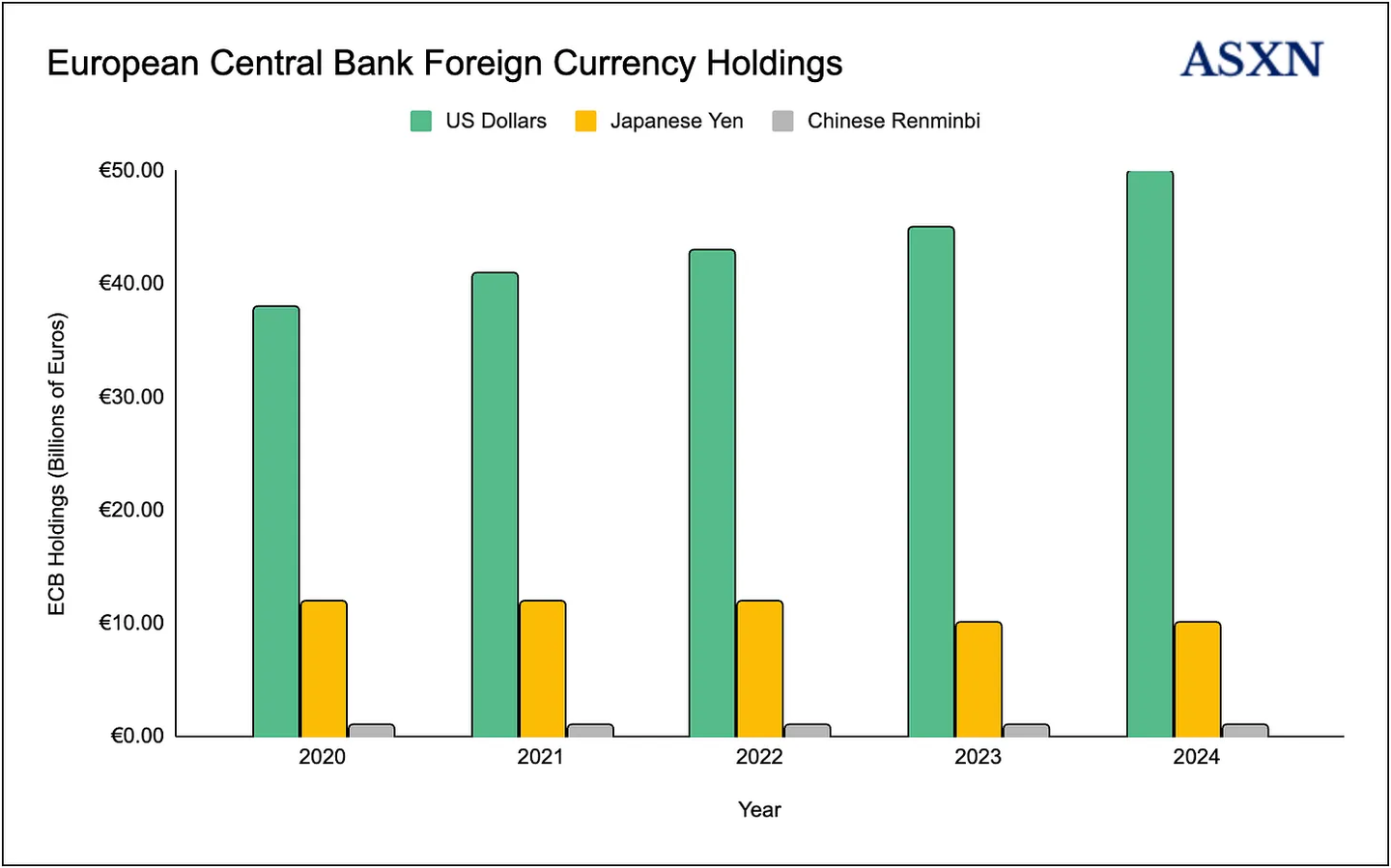
We will briefly explore how the dollar ascended to global hegemony, providing important context for understanding the long-term tailwinds supporting stablecoin adoption. In our view, understanding stablecoins requires not only a technological perspective but also an appreciation of the political and economic forces that shape their trajectory.
The History of the US Banking System and the Dollar
Hamilton's Blueprint (1775-1791)
Before establishing a formal banking system, the American Revolutionary War and the Confederation period plunged the nation into financial chaos. The war was financed through "Continental Currency," which rapidly depreciated, leading to the saying "not worth a Continental." To restore order, President George Washington appointed Alexander Hamilton as the first Secretary of the Treasury. Hamilton proposed that the federal government assume state debts, issue federal bonds, and create a national bank to regulate currency and credit. Disturbed by the chaos of competing state currencies, Hamilton persuaded Congress to charter the First Bank of the United States, calling it "an indispensable political machine for the nation," believing it was key to unifying the republic's financial system.
The Era of the First Bank (1791-1811)
In 1791, Congress chartered the First Bank of the United States, signed by President Washington, becoming the nation’s de facto first central bank. Headquartered in Philadelphia, it had a capital of $10 million, with 20% held by the government and 80% privately owned. The bank acted as the federal government’s fiscal agent, managing deposits, taxes, payments, and issuing currency backed by gold and silver that was accepted nationwide. Under President Thomas Willing, the bank opened branches in major cities, stabilizing the post-war economy. However, the establishment of the bank sparked strong opposition from Jefferson and Madison, who deemed it unconstitutional and elitist. Despite the bank's effective operations, political resistance grew, and in 1811, Congress narrowly voted against renewing its charter. Without a central bank, the US faced financial chaos during the War of 1812, highlighting the need for new national institutions and laying the groundwork for the establishment of the Second Bank of the United States.
The Second Bank and Jackson's "Bank War" (1816-1836)
To address the financial chaos following the War of 1812, Congress chartered the Second Bank of the United States in 1816 for a 20-year term with a capital of $35 million, also headquartered in Philadelphia. Even President James Madison, who had opposed the First Bank, acknowledged the need for a central financial institution to stabilize the post-war economy. Under Nicholas Biddle's leadership, the Second Bank aimed to regulate credit and the money supply. However, it became the target of a populist movement led by President Andrew Jackson opposing concentrated financial power. Jackson labeled the bank a "nest of vipers and thieves," vetoed its charter renewal, and withdrew federal deposits, effectively destroying the institution.
Free Banking and "Wildcat Currency" (1837-1862)
From the late 1830s until the Civil War, a period known as the Free Banking Era emerged, where banking affairs were controlled by state governments, and the collapse of the Second Bank left a lack of federal oversight. States like New York passed "Free Banking" laws, allowing almost anyone who met basic requirements and provided bond collateral to open a bank. Without federal supervision, over 8,000 different banknotes circulated, each trading at different discounts based on the issuing bank's creditworthiness and the distance to the redemption location. Some institutions, known as "wildcat banks," operated in remote areas to avoid redemption, issuing notes not fully backed by gold and silver, leading to widespread instability and fraud. Bank failures were common in places like Michigan, and the panics of 1837 and 1857 intensified public demand for a national banking framework and a unified currency.
Civil War Financing and the National Banking Act (1863-1879)
The Civil War triggered a financial revolution, with the federal government eager to fund the war. Initially relying on bond sales and tax increases, the North soon faced a cash shortage, suspending gold and silver convertibility by the end of 1861, causing currency to vanish from circulation. In 1862, Congress passed the Legal Tender Act, authorizing the issuance of $150 million in paper currency known as "greenbacks," which were non-interest-bearing Treasury notes designated as legal tender but not backed by gold. These legal tender notes filled a critical currency gap, although trading at a discount to gold led to inflation. Ultimately, about $450 million in greenbacks were issued, marking the first large-scale use of legal tender in US history, continuing into the 20th century. While the system provided stability and funded victory, it also triggered significant inflation, with Northern prices rising about 80% during the war. After 1865, efforts were made to restore a gold-backed currency, ultimately reestablishing gold and silver convertibility at a fixed rate of $20.67 per ounce in 1879.
Gold, Populism, and Morgan's Midnight Rescue (1879-1907)
The successful restoration of gold and silver payments in 1879 marked the official entry of the US into the classical gold standard era, with the dollar pegged to gold at $20.67 per ounce, and greenbacks, gold certificates, and national bank notes freely convertible into gold. From 1880 to 1914, this period saw robust economic growth and rapid industrialization, with the US rising as a global economic power. However, bank panics occurred frequently (in 1884, 1890, 1893, and 1907), highlighting deep structural flaws in the financial system. During these crises, credit and money dried up, interest rates soared, and banks hoarded reserves, leading to a contraction in lending. Clearinghouse associations in major cities attempted to stem losses by issuing emergency loan certificates, but these temporary measures underscored the lack of a formal liquidity injection mechanism. Debates over monetary policy intensified, with farmers and debtors in the West and South demanding the free coinage of silver to expand the money supply in response to deflation and falling agricultural prices. The panic of 1907 forced financier J.P. Morgan to personally organize a private sector rescue, locking in the heads of New York trust companies until a rescue agreement was reached, an event that ultimately catalyzed the creation of the Federal Reserve System.
From Jekyll Island to the Federal Reserve System (1907-1913)
In 1910, Senator Nelson Aldrich secretly convened five prominent financiers at Jekyll Island to devise a new central banking scheme, which Paul Warburg mockingly referred to as "secretive as a Confederate Navy." The result was the Aldrich Plan, proposing the establishment of a central institution with regional branches, ensuring flexibility through currency backed by commercial paper and gold, governed by bankers. In 1912, Aldrich unveiled the plan, but the political winds had shifted: the Democratic Party, long skeptical of concentrated financial power, won the White House and Congress after Woodrow Wilson's election. The Aldrich Plan was obstructed due to its perceived closeness to Wall Street and its secretive origins. However, its core ideas were retained. Wilson acknowledged that the plan was "60-70% correct." A proposal was reworked by Congressman Carter Glass and Senator Robert Latham Owen, and after intense debate, Wilson finalized it. On December 23, 1913, the Federal Reserve Act was signed, establishing the Federal Reserve System, granting 12 regional "bankers' banks" the authority to issue flexible Federal Reserve notes and manage the national monetary system.
Early Federal Reserve and the Roaring Twenties (1914-1928)
The Federal Reserve System began operations at the outbreak of World War I (1914-1918). Although the US remained neutral until 1917, the war had an immediate impact on the economy. Capital flowed from war-torn Europe into the US, which became the primary supplier of weapons and materials to the Allies, primarily financed through massive loans. The New York financial market rapidly expanded, and the dollar began to replace the pound in international transactions. Many belligerent nations suspended the gold standard to print money to finance the war, while the US maintained the gold standard, leading to a surge in gold inflows. By 1917, the US held about one-third of the world's central bank and Treasury reserves (approximately 11,000-12,000 tons). By the 1920s, the US share of reserves increased to about 40%. At the end of the war, the US emerged as the world's largest creditor, financing most of the Allies' war expenditures, shifting the global financial center from London to New York. By the mid-1920s, the dollar had become a strong competitor to the pound as a reserve and loan currency. However, imbalances intensified: the US accumulated vast gold reserves and actively lent abroad, while much of Europe remained mired in post-war debt and economic fragility.
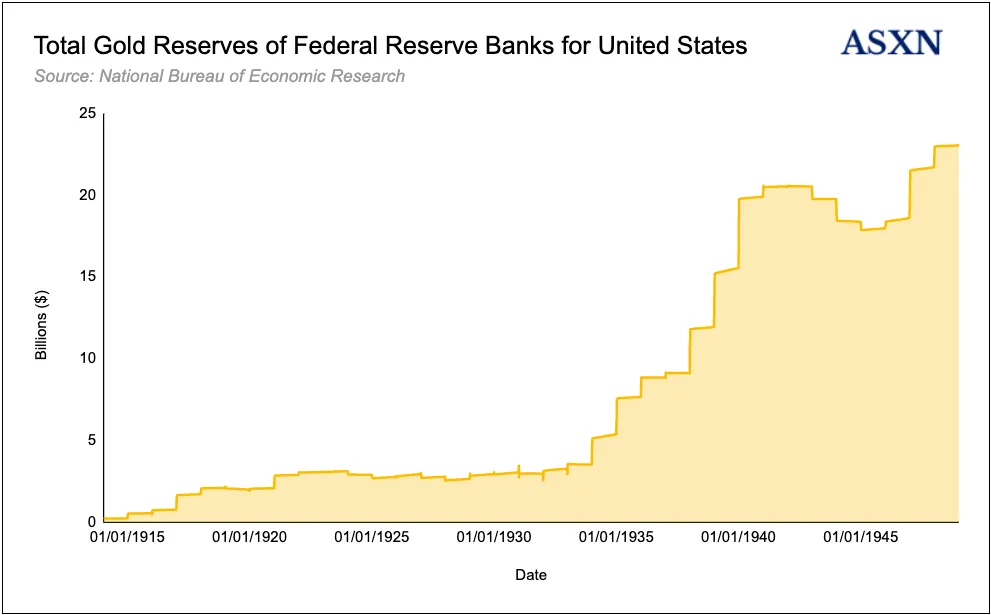
The Great Depression and the New Deal (1929-1945)
In October 1929, the long-accumulated stock market bubble burst, triggering the Wall Street crash and evaporating billions of dollars in wealth. This collapse destroyed confidence and rippled through the banking system, causing many institutions to fail due to exposure to stock loans or securities affiliates. Nearly 9,000 banks (about one-third of all banks in the US) closed, and the Federal Reserve failed to act decisively. Its decentralized structure led to internal disagreements, prioritizing the protection of the gold standard over expanding credit. Some officials took a "liquidationist" stance, believing that weak banks and borrowers should be allowed to fail. The result was a one-third contraction in the money supply, leading to deflation, a halving of GDP, and an unemployment rate of 25%. President Roosevelt declared a bank holiday, created the FDIC through the Glass-Steagall Act, and separated commercial banks from investment banks. Through Executive Order 6102, Americans were forced to surrender gold at a price of $20.67 per ounce in exchange for dollars, effectively nationalizing gold to prevent a run on the dollar and achieve monetary expansion. The Gold Reserve Act of 1934 confirmed this, devaluing the dollar and raising the gold price to $35 per ounce. With most of the world's gold and a stable banking system, the dollar became the dominant currency, laying the foundation for the post-war global monetary order.
Bretton Woods System (1944-1971)
After World War II, the United States emerged with unparalleled economic dominance, producing half of the world's output and holding about 70% of official gold reserves, placing it in a unique position to rebuild the international monetary system. The pound was weakened by massive war debts and a shortage of dollars, leading many countries to implement currency controls. Learning from the failures of post-World War I and the 1930s devaluations, 44 allied nations established a new framework at the Bretton Woods Conference in July 1944. Led by US Treasury official Harry Dexter White and British economist John Maynard Keynes, representatives created the Bretton Woods system, establishing the International Monetary Fund and the World Bank, and fixing exchange rates to the dollar, which was convertible to gold. This system effectively established the dollar's core position in global finance, supported by US economic strength and gold reserves, a status later referred to as "exorbitant privilege," allowing the US to borrow freely and run external deficits. For the next quarter-century, the Bretton Woods system defined international finance until its collapse opened the era of fiat dollars.
Nixon Shock and Petrodollars (1971-early 1980s)
On August 15, 1971, President Nixon unilaterally suspended the dollar's convertibility into gold, ending the Bretton Woods system and severing the last link between the dollar and gold. This marked a shift to a fiat currency regime, with the dollar and other major currencies floating freely, their values determined by market forces. Despite losing gold backing, the dollar retained and expanded its status as a global reserve currency due to a lack of alternatives and continued confidence in the US financial markets. After the oil crisis of 1973-74, OPEC significantly raised oil prices, forcing importing countries to acquire more dollars to pay for energy costs. In 1974, the US reached a strategic agreement with Saudi Arabia: in exchange for military protection and weapons, Saudi Arabia would price oil in dollars and invest its oil revenues in US Treasury securities. This arrangement was quickly emulated by other OPEC member countries, establishing the petrodollar system. Oil-exporting countries accumulated large dollar surpluses, depositing them in international banks or reinvesting in dollar assets, a process known as the petrodollar recycling. By 1975, all OPEC countries adopted dollar pricing, embedding the dollar in global trade and finance. This supported ongoing US budget and trade deficits while suppressing interest rates, reinforcing dollar hegemony and granting the US new "exorbitant privilege." In the 1970s, money market funds emerged as corporate cash management tools, with the first (the Reserve Fund) launched in 1971, holding assets of $1 million.
Deregulation, Globalization, and Eurodollars (1980s-1999)
In the 1980s and 1990s, the dollar's hegemony was solidified against the backdrop of financial deregulation, victory over inflation, and accelerated globalization. Under Federal Reserve Chairman Paul Volcker, inflation fell from about 13% in 1980 to about 3% in 1983, restoring confidence in the dollar as a stable store of value. By the mid-1980s, the dollar soared to historical highs, prompting the Plaza Accord in 1985, where the US coordinated with major allies to devalue the dollar, leading to a roughly 40% decline against the yen and mark by 1987, helping to reduce trade imbalances. Financial deregulation, including the Depository Institutions Deregulation and Monetary Control Act of 1980, eliminated interest rate ceilings on deposits and expanded the Federal Reserve's services, allowing banks to compete for deposits more effectively. In the 1990s, globalization intensified, and the dollar became the preferred currency for expanding global capital markets. The Eurodollar market flourished, and by the late 1990s, about 64% of global debt was denominated in dollars, with the dollar accounting for 59% of foreign exchange reserves and 58% of international payments, solidifying its core position in the global financial system.
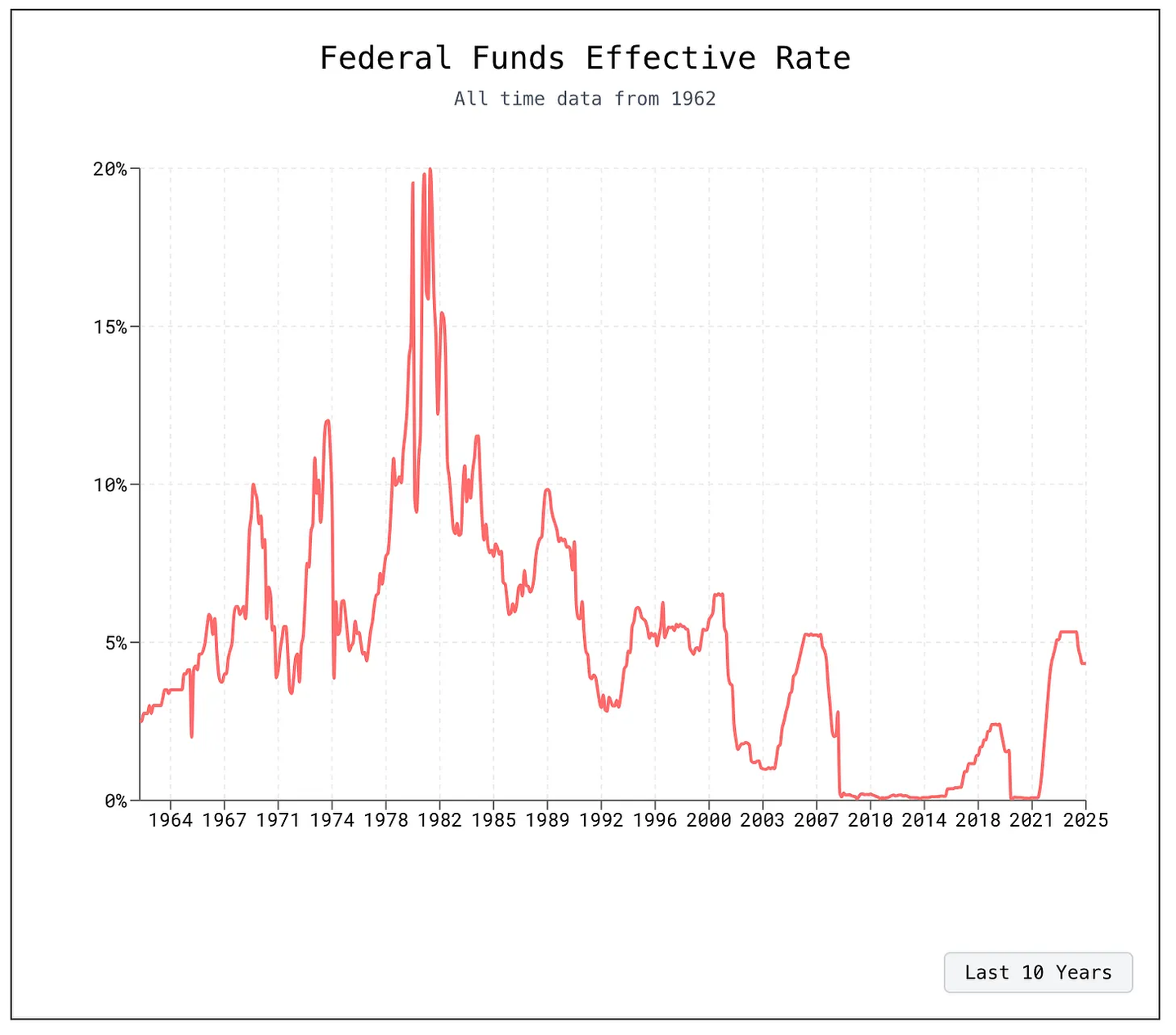
Global Financial Crisis and Quantitative Easing (2000s)
The 2000s tested the US banking system and the dollar, particularly during the global financial crisis of 2007-2009, the most severe economic recession since the Great Depression. Although the crisis began in the US housing and banking sectors, it ultimately reinforced the dollar's status as a global safe haven. In 2007, hedge funds and mortgage institutions began to fail; by March 2008, Bear Stearns was absorbed by JPMorgan with Federal Reserve support. The bankruptcy of Lehman Brothers in September 2008 marked the peak of the crisis, freezing interbank lending and triggering runs on money market funds, with one "breaking the buck." A global contagion followed, as many foreign banks held US mortgage securities or relied on dollar financing. The US implemented massive countermeasures: the Federal Reserve lowered interest rates to near zero, created emergency lending facilities, and established dollar swap lines with foreign central banks, becoming the global lender of last resort. The Treasury launched a $700 billion TARP program to inject capital into banks and stabilize institutions like AIG. The FDIC guaranteed bank debt and expanded deposit insurance to $250,000. Starting at the end of 2008, the Federal Reserve initiated quantitative easing (QE), purchasing long-term Treasury bonds and mortgage-backed securities. The Dodd-Frank Act of 2010 implemented stricter capital and liquidity rules, while subsequent rounds of QE (QE2 in 2010, QE3 from 2012-2014) supported a slow but steady recovery, expanding the Federal Reserve's balance sheet to $4.5 trillion.
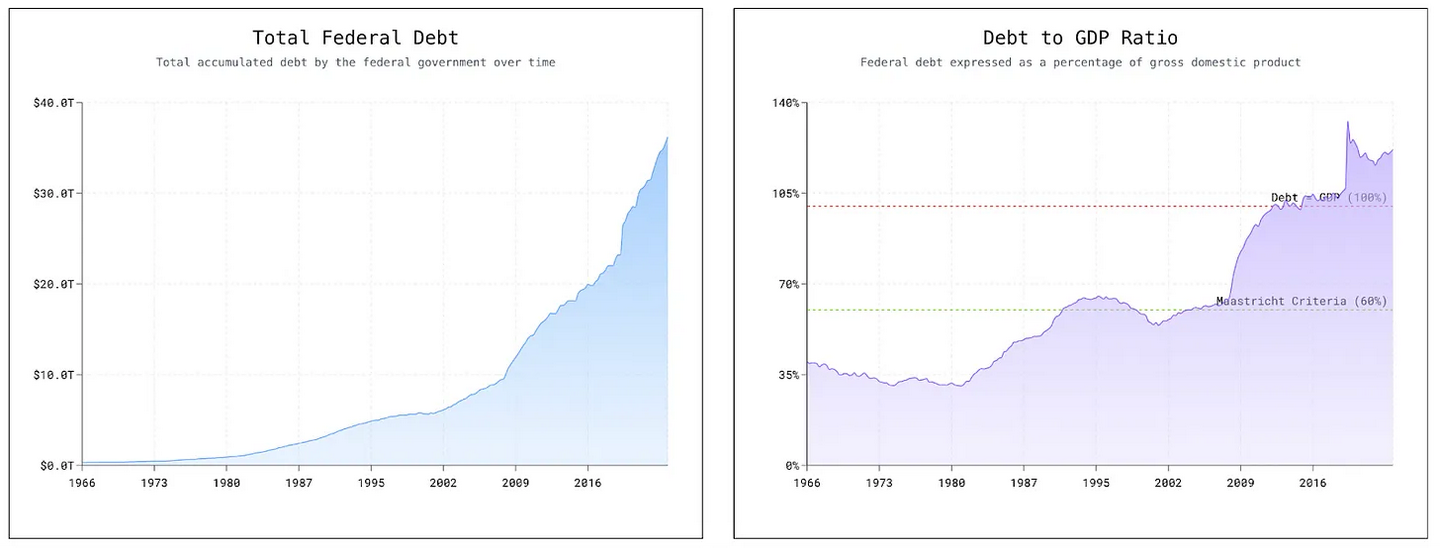
Pandemic Quantitative Easing and De-dollarization (2010-2025)
Over the past decade, the US has experienced an unprecedented expansion of monetary stimulus. After QE3 ended in 2014, the Federal Reserve's balance sheet exceeded $4 trillion, four times its pre-crisis size. A brief attempt to shrink the balance sheet in 2017 was interrupted by a 2019 repo market shock that exposed the system's reliance on Federal Reserve liquidity. In response to COVID-19, the Federal Reserve lowered interest rates to zero, restarted QE, and launched emergency tools, nearly doubling assets to nearly $9 trillion by mid-2022, accounting for 36% of GDP. Meanwhile, over $5 trillion in fiscal stimulus pushed federal debt to 98% of GDP for the fiscal year 2024. Inflation reached 9% in 2022, forcing the Federal Reserve to reverse course, raising interest rates above 5% and reducing the balance sheet to $6.8 trillion by early 2025. The dollar still dominates the foreign exchange market, accounting for 88% of transactions reported by the BIS, but its global reserve share has declined from 66% in 2015 to 57.8% in the fourth quarter of 2024. The trend of de-dollarization is accelerating: Russia's frozen reserves due to the invasion of Ukraine have raised awareness of dollar risks; Saudi Arabia's decision not to renew the petrodollar agreement marks a symbolic shift; Iran increasingly settles trade in non-dollar currencies; and China is promoting renminbi trade settlement, especially after the intensification of tensions with the US during the Trump tariff war.
Since Nixon closed the gold window in 1971, the dollar has floated freely as a pure fiat currency. Today, 12 regional Federal Reserve Banks issue a single national currency—the Federal Reserve note—while the US Treasury mints coins. Almost all other "dollars" exist in the form of electronic bank deposits settled through the Federal Reserve system. The federal government finances itself by selling Treasury securities, and the Treasury market remains the deepest pool of safe-haven assets globally: foreigners hold about $8.8 trillion in Treasury securities, with Japan alone holding $1.13 trillion. Ongoing global demand keeps yields relatively low, with the yield on 10-year Treasuries hovering around 4%, despite publicly held debt now reaching 122% of GDP and continuing to rise. This "reserve currency dividend" is another facet of dollar hegemony: the US can run large deficits and borrow at low costs because the world needs dollar assets for trade, security, and regulation.
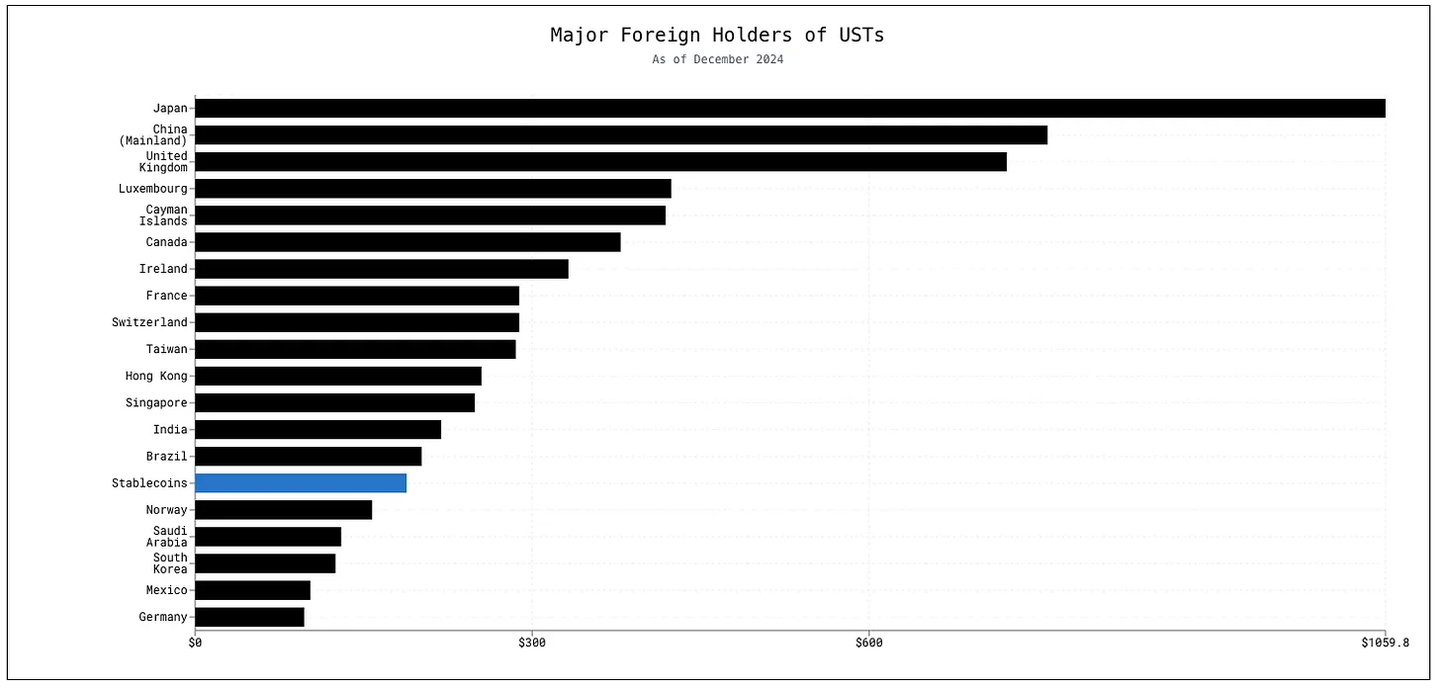
Another characteristic of the modern American monetary system is its high degree of digitization. Of the approximately $21 trillion in broad money (M2), about $18.5 trillion (nearly 90%) consists of digital ledger entries in commercial banks or the Federal Reserve's reserve database. The physical currency in circulation amounts to only $2.36 trillion, with the Federal Reserve estimating that about 60% (especially $100 bills) is held overseas as a portable store of value. Despite the digitization of currency, most US retail payments still rely on traditional infrastructure like the ACH system from half a century ago, with transfers often settling the next day or longer.

In summary, today's dollar primarily exists in digital form, officially unified, based on fiat currency, globally coveted, yet its payment network is only partially modernized, and the scale of the Federal Reserve's balance sheet and its future affordability remain long-term critical issues for the system.
Overview of Stablecoins
Stablecoins represent the next stage in the evolution of currency and payment systems, laying the foundation for a financial system with faster settlement speeds, lower costs, seamless cross-border functionality, native programmability, and robust audit trails. They essentially encapsulate the dollar in software, enabling it to move at lightning speed anywhere with internet coverage. In simple terms, stablecoins are the fastest form of the dollar's existence.
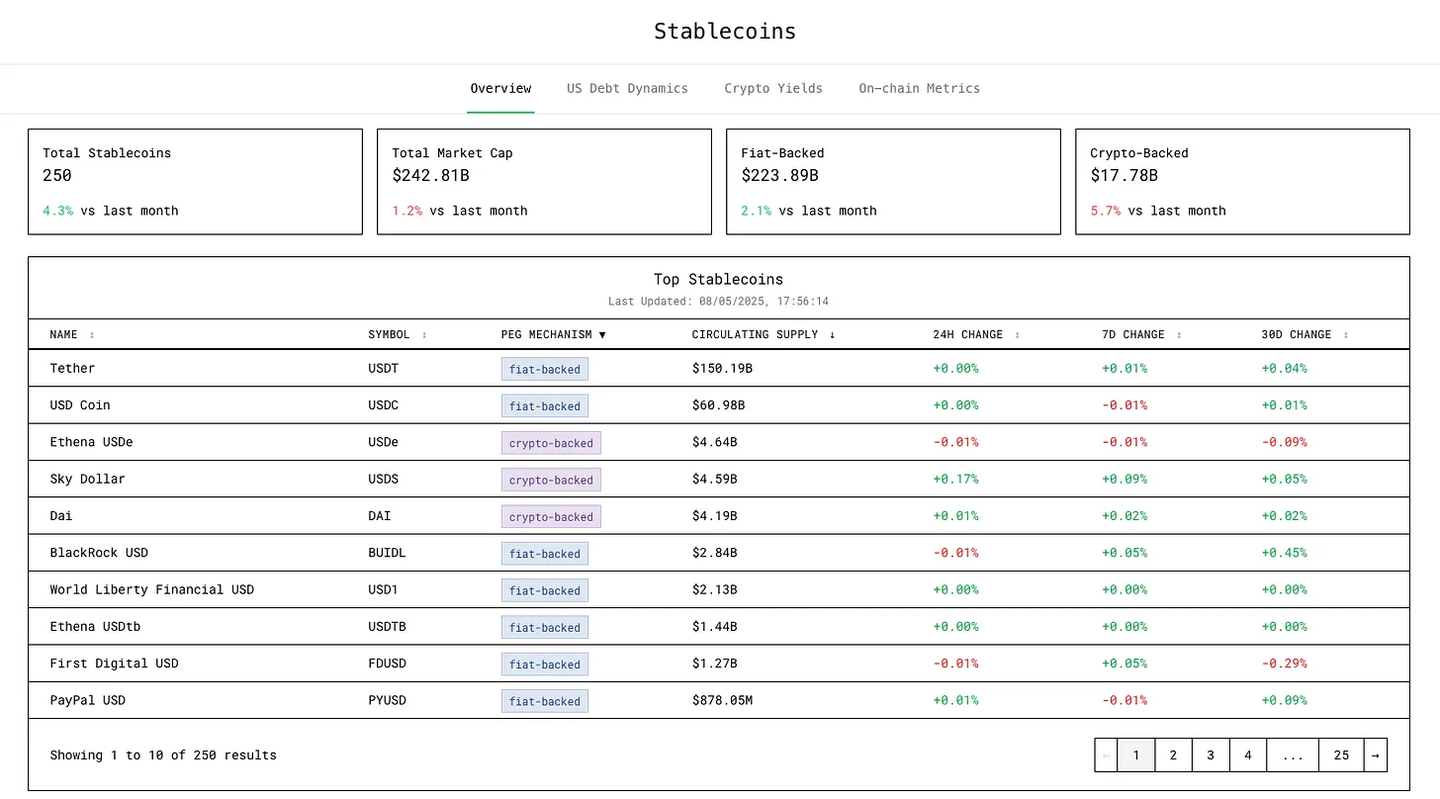
Stablecoins have become the most prominent product in cryptocurrency—market fit, with a growth trajectory reflecting extraordinary adoption rates. The market has expanded from a total market capitalization of $30 million in 2018 to over $250 billion today, with a compound annual growth rate of 263%. Initially used as crypto-native collateral and settlement mechanisms, particularly by market makers and arbitrageurs, stablecoins have now evolved into widely adopted financial primitives. Today, trading firms and market makers regularly hold stablecoins on their balance sheets, while decentralized finance (DeFi) protocols have deeply embedded stablecoins into collateral structures and trading pairs. Centralized exchanges are increasingly shifting from Bitcoin-collateralized perpetual contracts to margin trading based on stablecoins. In addition to internal applications within crypto, stablecoins are gaining traction among citizens in high-inflation or politically unstable regions as a means of storing value and as a fast, low-cost remittance tool. This broader adoption has benefited from significant improvements in infrastructure, including more efficient deposit and withdrawal channels, high-throughput low-fee blockchains, better-designed wallets, and user-friendly applications based on private key management advancements.
Categories of Stablecoins
Today's stablecoin ecosystem includes several different types of stablecoins, primarily distinguished by their collateral support, degree of decentralization, and mechanisms for maintaining price pegs. Fiat-backed stablecoins dominate the market, accounting for over 92% of the total stablecoin market capitalization. Other categories include cryptocurrency-backed stablecoins, algorithmic stablecoins, and recently emerged strategy-backed stablecoins. Broadly, stablecoins are digital tokens that maintain a 1:1 value with a designated currency (usually the US dollar).
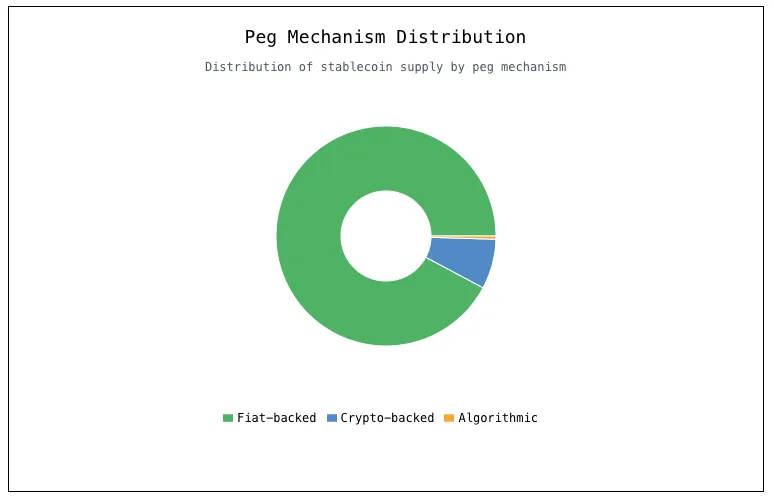
Fiat-Backed Stablecoins
Fiat-backed stablecoins are similar to banknotes issued by note-issuing banks during the era of national banks in the United States (1865-1913): at that time, various banks issued notes redeemable for government greenbacks or gold and silver, with their value depending on the bank's creditworthiness and the note holder's ability to redeem them. Today's fiat-backed stablecoins promise 1:1 convertibility with a given fiat currency, but just as 19th-century note holders relied on secondary markets to redeem notes that could not be directly redeemed, modern users rely on platforms like Uniswap or centralized exchanges to exchange tokens for dollars at par (if direct redemption is not possible). This reliable convertibility—enforced through audited reserves and robust trading infrastructure—establishes the same level of confidence in fiat-backed stablecoins as the widely redeemable guarantees of banknotes over a century ago.
Fiat-backed stablecoins maintain their 1:1 peg by fully collateralizing each digital token with an equivalent amount of fiat currency held off-chain. For example, each USDC token is backed by a combination of $1 in cash and short-term US government debt. According to current reserve disclosures, each USDC is supported by approximately $0.885 in US Treasury securities and $0.115 in cash. The cash portion is held by regulated financial institutions, while the Treasury securities (including short-term securities and overnight repurchase agreements) are custodied by BNY Mellon and managed by BlackRock.
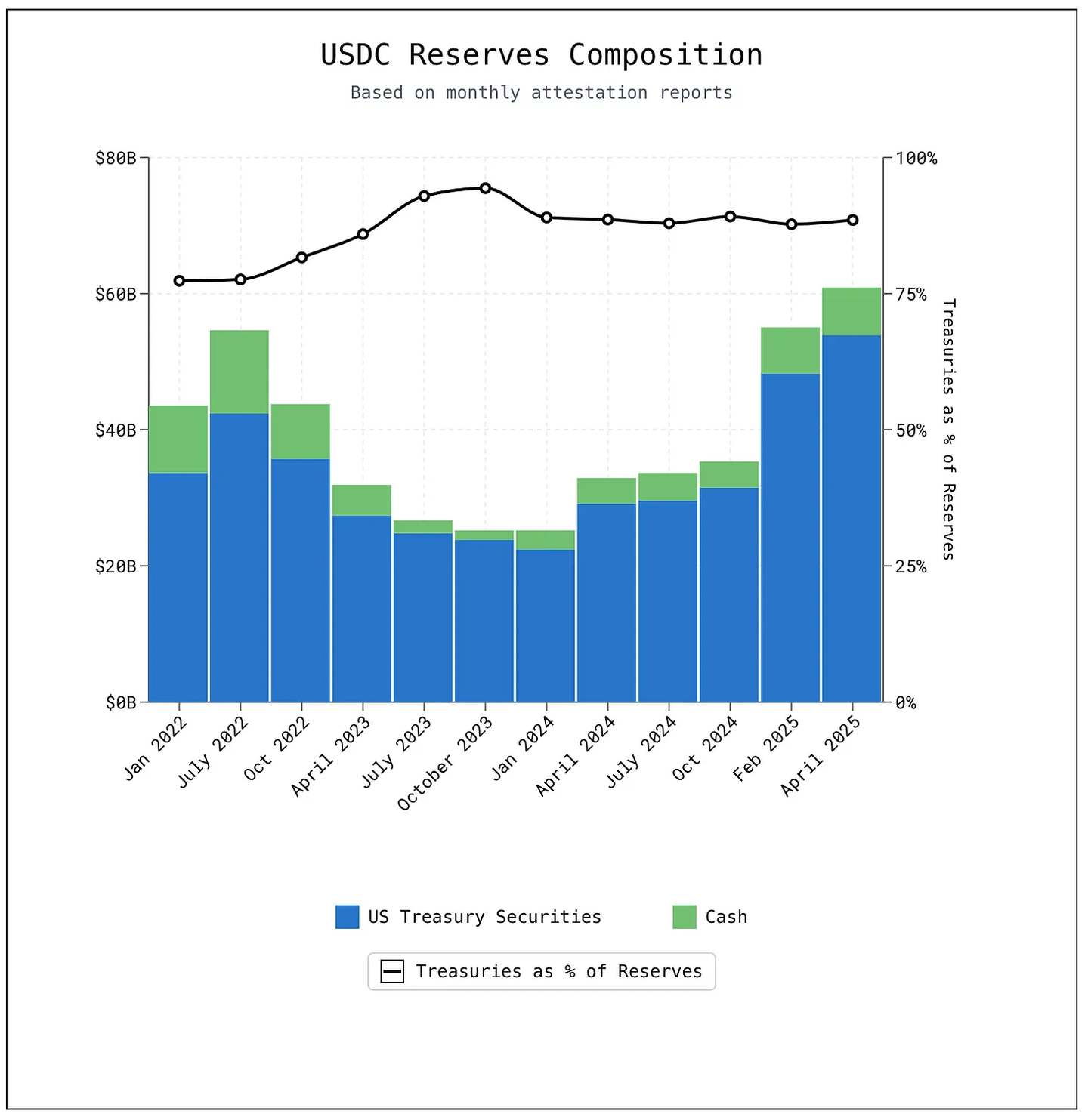
Typically, only specific entities can mint and redeem fiat-backed stablecoins. For example, Circle Mint clients (businesses and institutions with verified accounts) can redeem USDC directly at a 1:1 ratio through Circle. Redemption is initiated by sending USDC to the smart contract's burn function via the Circle Mint dashboard or API and submitting a redemption request. Clients can choose between two options: standard redemption, which provides near-real-time settlement with a daily limit of $15 million free of charge (with a 0.1% fee for amounts exceeding this limit); or basic redemption, which is completely fee-free but may take up to two business days for settlement. Once processed, Circle transfers the dollars to the client's associated bank account via ACH or wire transfer, depending on the chosen payment channel. This structure supports the 1:1 peg of USDC through arbitrage: when the secondary market deviates from par, traders can exploit the price difference, helping to restore price stability.
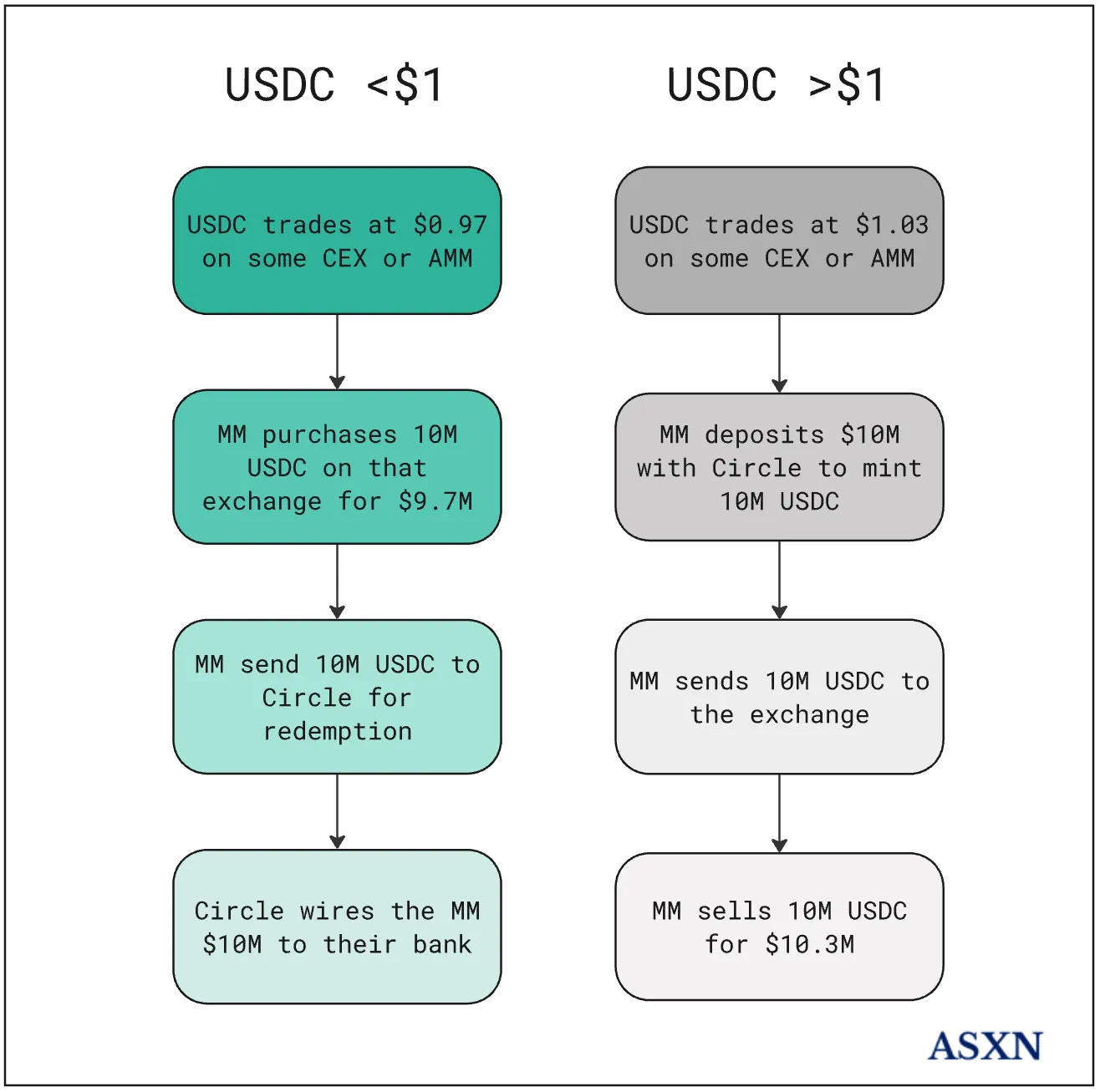
Stablecoin issuers primarily earn income by investing their reserves in interest-bearing US debt instruments. For example, Tether earned approximately $7 billion in 2024 from holding US Treasuries and repurchase agreements. Therefore, stablecoin issuers have an incentive to expand their supply, allowing them to invest more capital and capture yields close to the federal funds rate (currently around 4.25%).
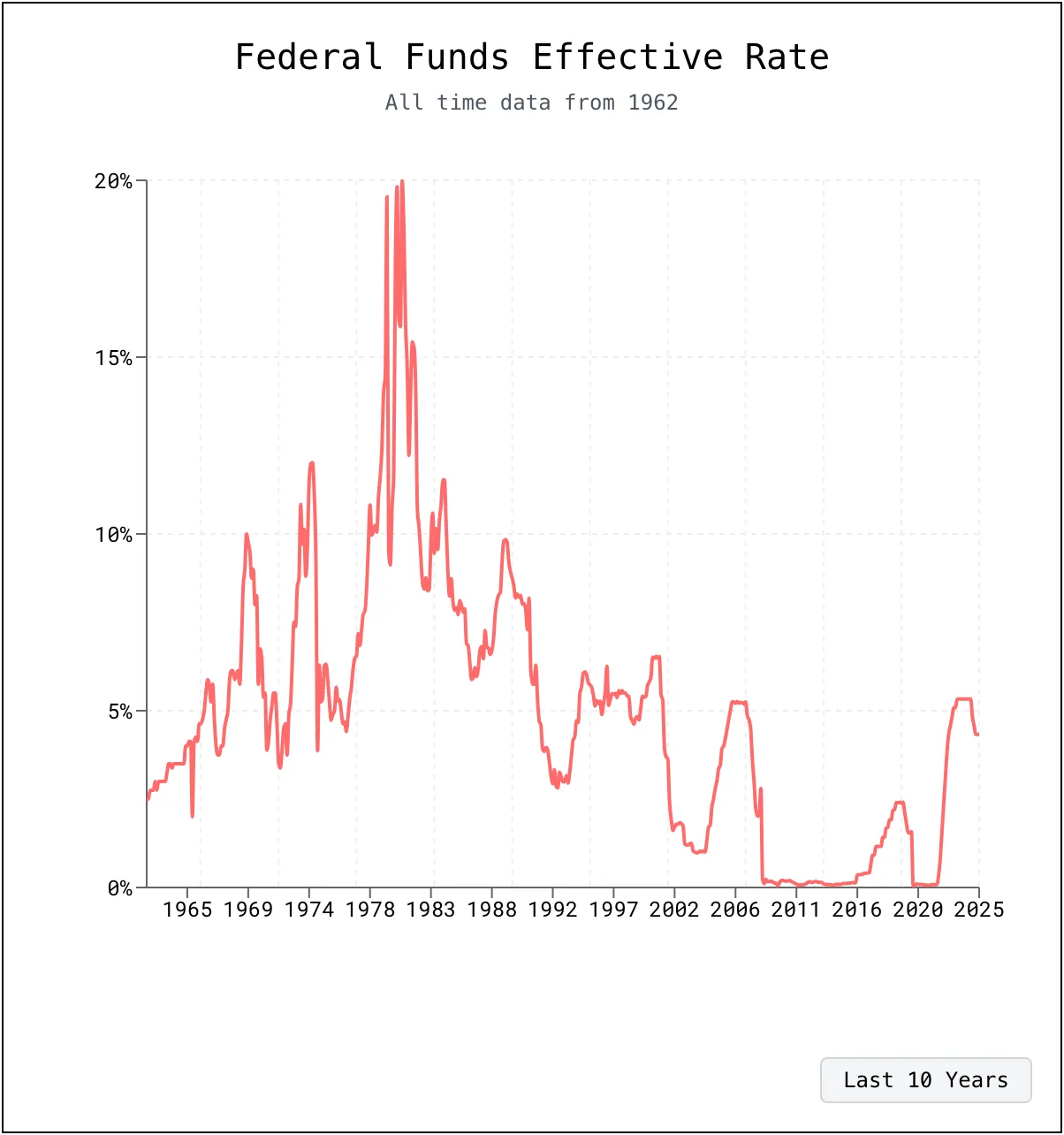
Fiat-backed stablecoins bear strong similarities to money market funds (MMFs). After the Great Depression, the Glass-Steagall Act of 1933 aimed to prevent commercial banks from engaging in risky behaviors that could lead to bank failures, one provision of which, the "Q Regulation," limited the deposit rates banks could offer. As market interest rates exceeded the deposit rate ceiling, depositors missed out on earning opportunities. Bruce Bent and Henry Brown launched the first money market mutual fund in 1971, pooling cash from small investors to purchase short-term commercial paper and repurchase agreements. These funds were not subject to the Q Regulation interest rate ceilings (as they were managed by investment companies), allowing them to offer returns that banks could not match while maintaining a value of $1 per share.
The similarities between fiat-backed stablecoins and MMFs extend beyond structural design. Their regulatory and political debates are also highly similar. When MMFs first emerged, they faced criticisms similar to those currently directed at stablecoins, including concerns about financial stability, regulatory inadequacy, and systemic risk:
Financial stability risk: Money market funds (MMFs) do not have federal deposit insurance or central bank support, unlike regulated banks. This structural flaw makes them susceptible to liquidity crises and investor runs, as demonstrated during the 2008 financial crisis.
Regulatory arbitrage: MMFs effectively mimic core banking functions, such as providing stable dollar-denominated value storage, but are not subject to the stringent regulatory and capital frameworks that traditional deposit institutions face. This creates a parallel credit system with less regulation.
Erosion of monetary policy: The growth of MMFs may undermine the effectiveness of Federal Reserve policy tools. As assets shift from the regulated banking system to less-regulated instruments, the effectiveness of tools like reserve requirements diminishes, weakening the central bank's ability to control liquidity and credit conditions.
Although MMFs were introduced in the early 1970s, they only began to attract significant asset management scale after financial deregulation, legislative support, and technological advancements (such as electronic settlement systems and the internet) laid the groundwork. The Gramm-Leach-Bliley Act, passed in November 1999, was a pivotal moment, as it repealed key provisions of the 1933 Banking Act, removing long-standing legal barriers to the sponsorship and distribution of investment funds by commercial banks. This regulatory shift allowed banks to fully integrate MMFs into their product offerings, becoming part of the "financial supermarket" model. Banks quickly took advantage of these new powers, launching and distributing their own MMFs as part of core deposit accounts and yield products similar to Treasuries, attracting record amounts of funding from institutional and retail investors. By the end of 1998, before the Gramm-Leach-Bliley Act was passed, the US MMF industry had reached approximately $1.4 trillion in assets. Despite the turmoil caused by the 2008 financial crisis, MMFs continued to grow, reaching approximately $3.8 trillion in assets under management by the end of 2008. In many ways, their growth pattern is similar to the current trajectory of stablecoins, which also benefit from structural tailwinds and the evolution of financial infrastructure.
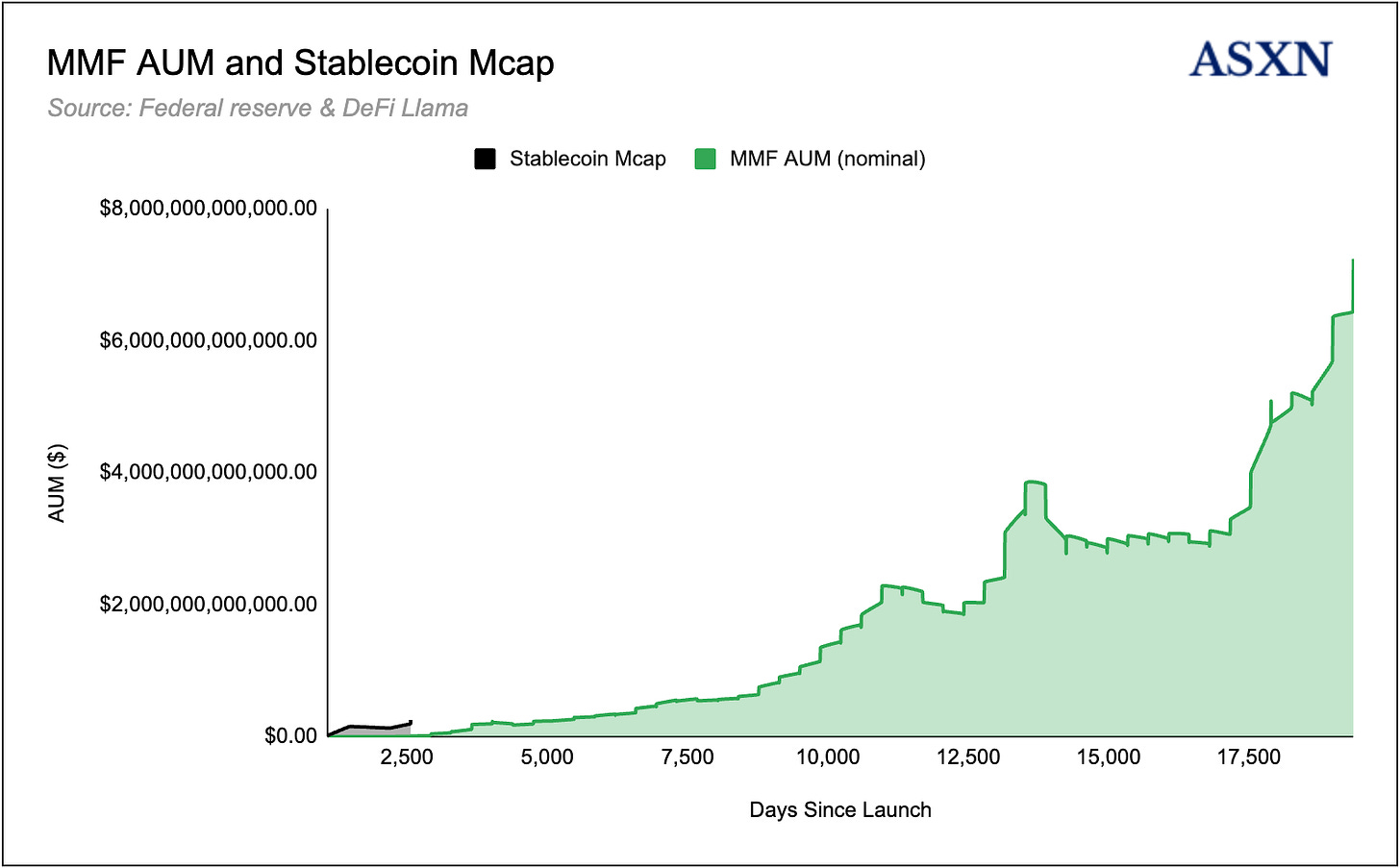
The assets under management of MMFs have now exceeded $7 trillion and continue to grow steadily. In contrast, seven years after the launch of MMFs, the assets under management were only $12.8 billion, which adjusts to about $62.8 billion in today's dollars. By this measure, stablecoins have outpaced MMFs by nearly four times at the same stage in their lifecycle. Observing the inflation-adjusted asset management scale trajectory of MMFs, the growth path of stablecoins is strikingly similar. Over the next 15,000 days (approximately 41 years), the actual assets under management of MMFs grew 55 times, driven by broader distribution, regulatory clarity, and technological advancements in financial infrastructure.
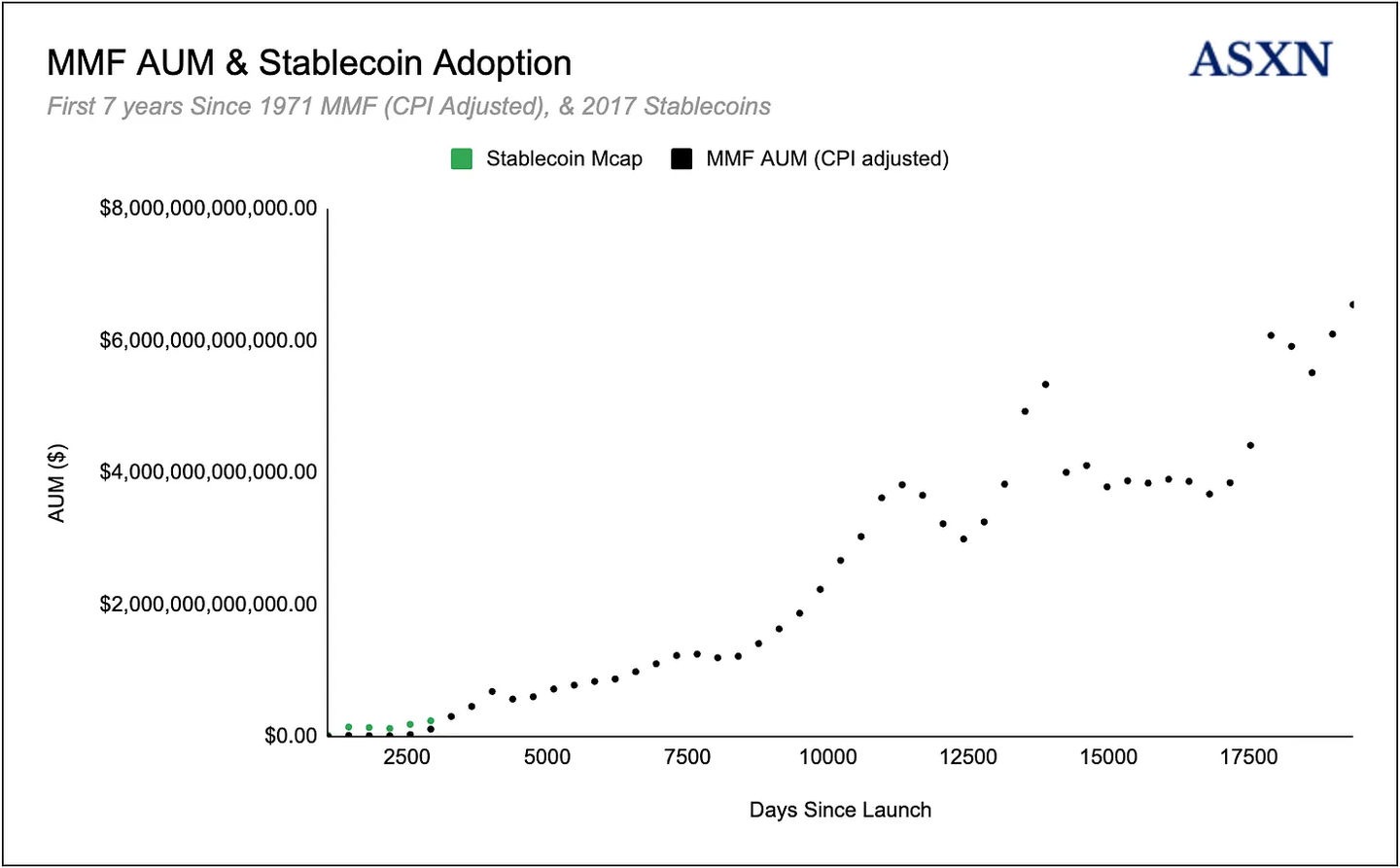
Cryptocurrency-Backed Stablecoins
Cryptocurrency-backed stablecoins are very similar to private banknotes from the era of free banking in the United States (1837-1862), which predates the National Banking Act of 1863-64 and the Federal Reserve Act of 1913. In the absence of federal regulation, states enacted "free banking" laws that allowed groups meeting minimum capital and collateral requirements (usually state bonds) to open banks. By 1860, over 8,000 different banknotes were in circulation, each trading at a discount or premium based on the issuer's creditworthiness, the cost of redeeming gold and silver, and local market conditions. Similar to today's cryptocurrency-backed stablecoin issuers, these free banks accepted gold and silver coins and (in some states) short-term government securities as reserves, then issued their own notes based on these reserves while extending loans under a fractional reserve system.
This mechanism of money creation still exists today, operating as follows:
A customer deposits $1,000 in a checking account, creating $1,000 in assets (reserves) and $1,000 in liabilities (deposits) on the bank's balance sheet.
Regulators require a 10% reserve ratio, for example, so for the $1,000 deposit, the bank holds $100 in reserves and can lend out $900.
Each time a loan is issued and redeposited in another bank, the process repeats, multiplying the original base money into a larger total of bank-created deposits. In fact, most broad money (M2) is created in this manner.
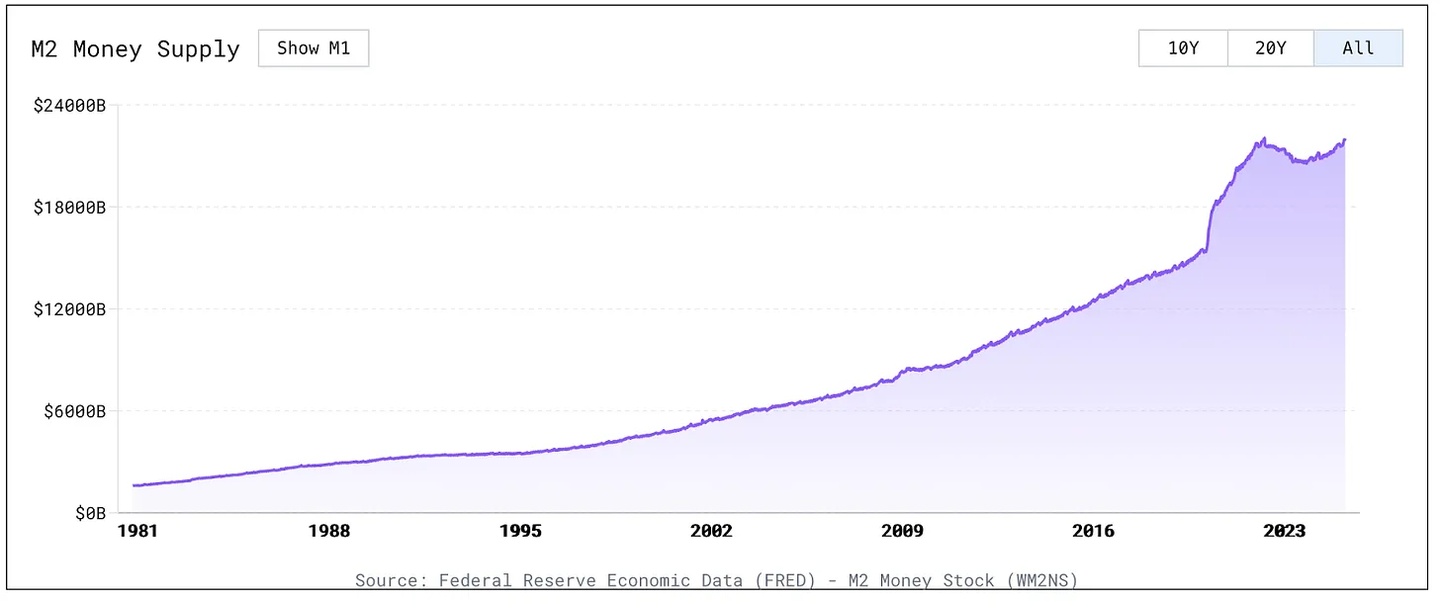
Cryptocurrency-backed stablecoins operate in a similar manner but mostly adopt an over-collateralized loan system due to their decentralized/KYC-free nature. Typically, users deposit collateral (e.g., BTC worth $1,000) into a protocol, which can mint up to $800 in stablecoins, reflecting an 80% loan-to-value (LTV) ratio. To prevent the devaluation of collateral from leading to system insolvency, the protocol enforces liquidation thresholds. If the value of the collateral falls below the specified LTV ratio, the system automatically liquidates the user's BTC to cover the outstanding debt, thereby preventing the accumulation of bad debt.
Maker/Sky Protocol has issued the largest decentralized cryptocurrency-backed stablecoins (DAI and USDS) in the space, continuing since the launch of the single-collateral DAI in 2017. Users mint DAI by depositing accepted collateral (such as ETH, wBTC, stETH, rETH, USDC, GUSD, and other crypto assets, as well as tokenized real-world assets including US Treasuries, real estate-backed tokens, and loans) into Vaults (formerly CDPs). Each type of collateral must meet a minimum collateralization ratio (for example, 150% for ETH), and if the value of the Vault falls below this threshold, it will face liquidation to maintain system solvency. The process is as follows:
A user deposits 1 wBTC worth $100,000 into a Maker Vault as collateral. The wBTC Vault type requires a 150% collateralization ratio (66.67% LTV).
The user can mint up to 66,666 DAI ($100,000 * 66.67%).
If the user mints 50,000 DAI, leaving a buffer above the minimum ratio, the Vault will hold 1 wBTC as collateral against the 50,000 DAI debt, resulting in a collateralization ratio of 200% or 50% LTV.
If the value of wBTC drops below $75,000, the Vault's collateralization ratio will fall below 150%, and the Vault will become under-collateralized.
At this point, the Vault will face liquidation: part of the wBTC will be auctioned/sold to cover the DAI debt, plus liquidation penalties.
If the user wishes to unlock the collateral at any time, they must repay 50,000 DAI (plus accumulated stability fees) before they can withdraw the wBTC.
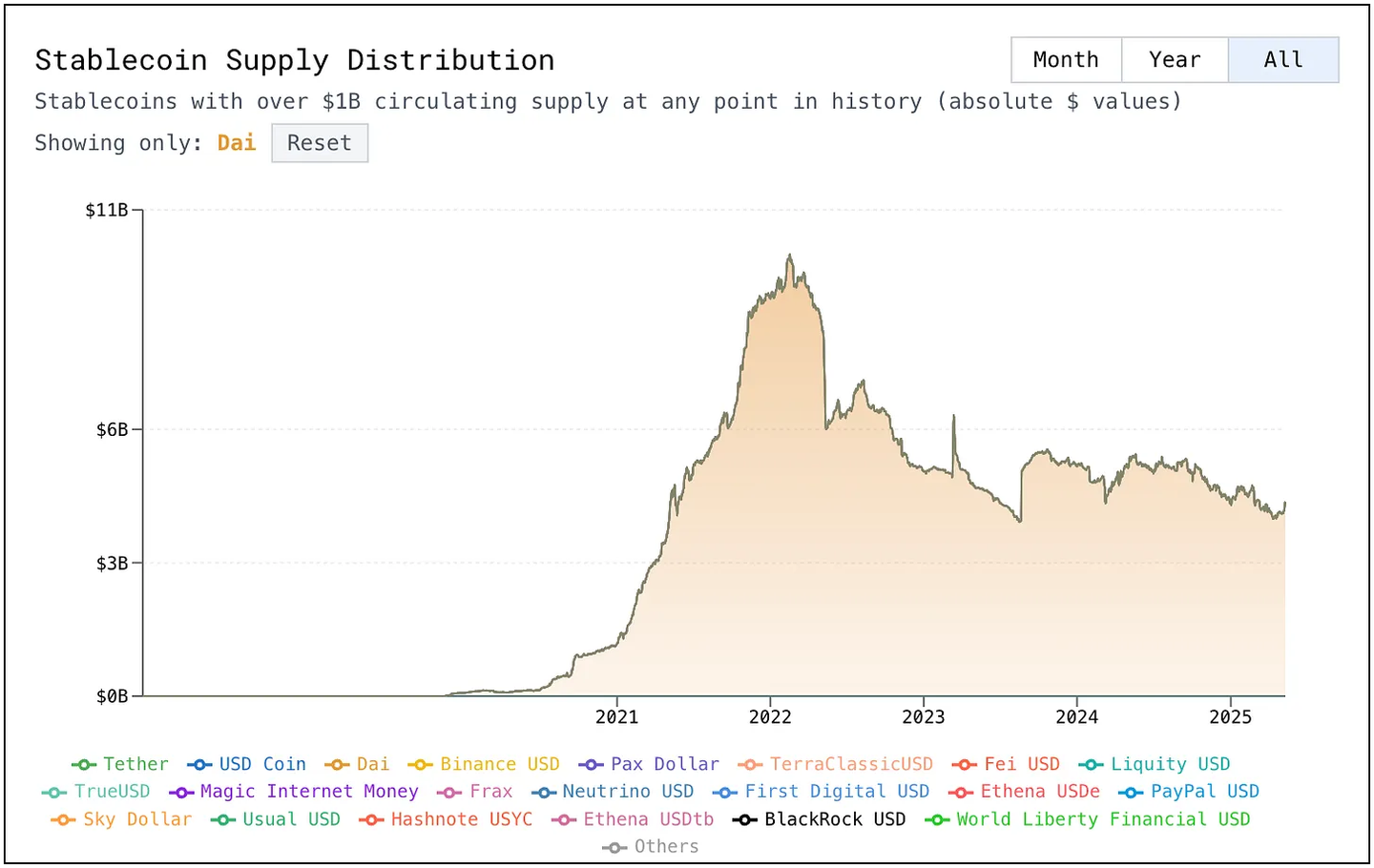
This is very similar to how banks create new money through loans, but using liquid on-chain collateral, with each stablecoin resembling different banknotes from the free banking era, where holders must assess stablecoin risks based on the following non-exhaustive factors:
The quality, liquidity, and volatility of the on-chain loan-backed collateral.
The protocol's ability to secure under-collateralized loans.
The security of the smart contracts and mechanism design.
For example, during the market crash in March 2020, ETH dropped 53% in two days, exposing a significant weakness in the DAI model that relied solely on ETH collateral. The sharp price drop triggered massive liquidations, leading to congestion on the Ethereum network and delayed oracle price feedback. As a result, DAI lost its peg, trading between $0.96 and $1.13 on March 13. This instability highlighted the risks of relying solely on ETH as collateral, prompting the DAI community to propose adding USDC on March 16, 2020, to diversify risk and improve peg stability. Since 2021, DAI has maintained relative stability.
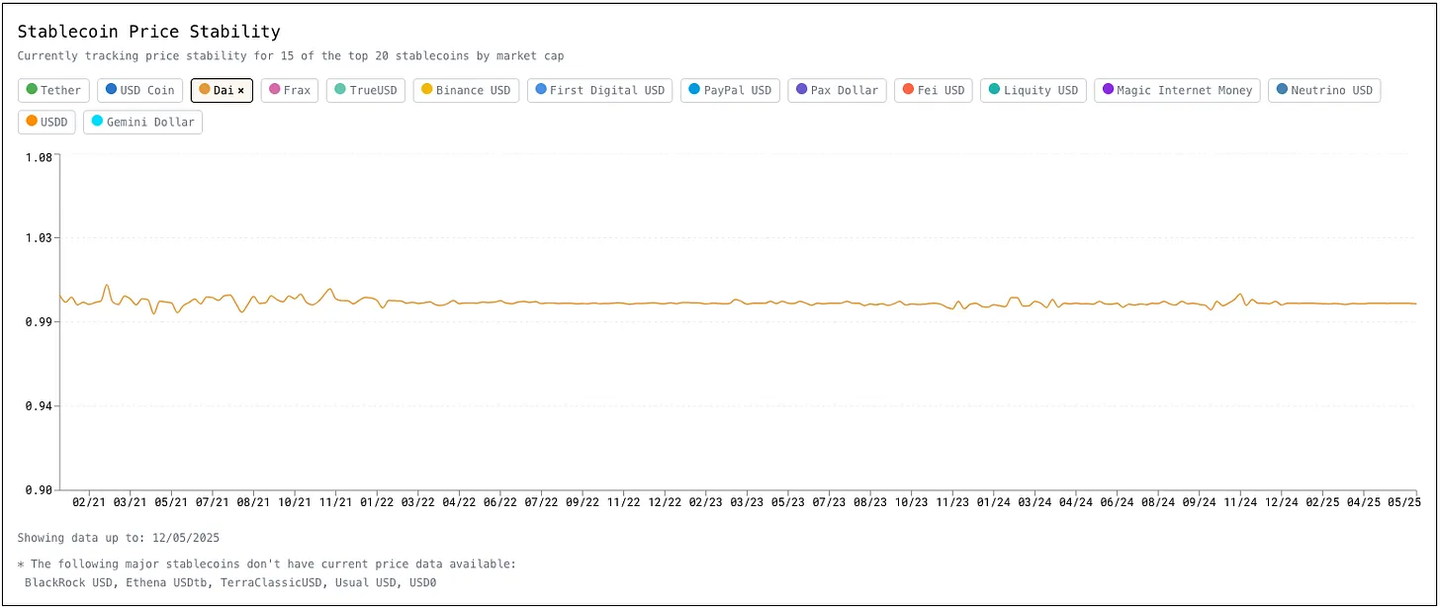
Algorithmic Stablecoins
Unlike fiat-backed and cryptocurrency-backed stablecoins, algorithmic stablecoins are not always backed by hard assets but use a combination of algorithms and smart contracts to maintain their peg. According to Kraken's analysis, we can further categorize algorithmic stablecoins into several models:
Seigniorage or Dual-Token Algorithmic Stablecoins
Seigniorage or dual-token algorithmic stablecoins use a dual-token system to maintain stable value. The first token is the stablecoin itself; the second is a bond or utility token, managed through incentive mechanisms and smart contracts to regulate supply and demand dynamics.
When the stablecoin trades above $1, indicating excess demand, the protocol mints new stablecoins and distributes them, typically to governance or bond token holders. This increase in supply aims to exert downward pressure on the price, guiding it back to the $1 target.
Conversely, if the stablecoin price falls below $1, the protocol contracts supply by allowing users to purchase bond tokens at a discount (e.g., $0.75). These bonds can be redeemed for $1 once the peg is restored. This mechanism incentivizes buyers and reduces the circulating supply of stablecoins, theoretically helping the price return to par.
Terra Luna and the UST stablecoin followed this model, with LUNA tokens being burned/minted to restore UST value to $1 during price fluctuations. However, in early 2022, UST lost its $1 peg due to a loss of trust in the system and hyperinflation of LUNA supply, leading to the protocol's collapse. Within days, UST's market cap evaporated by about $18 billion, and the price fell below $0.10.
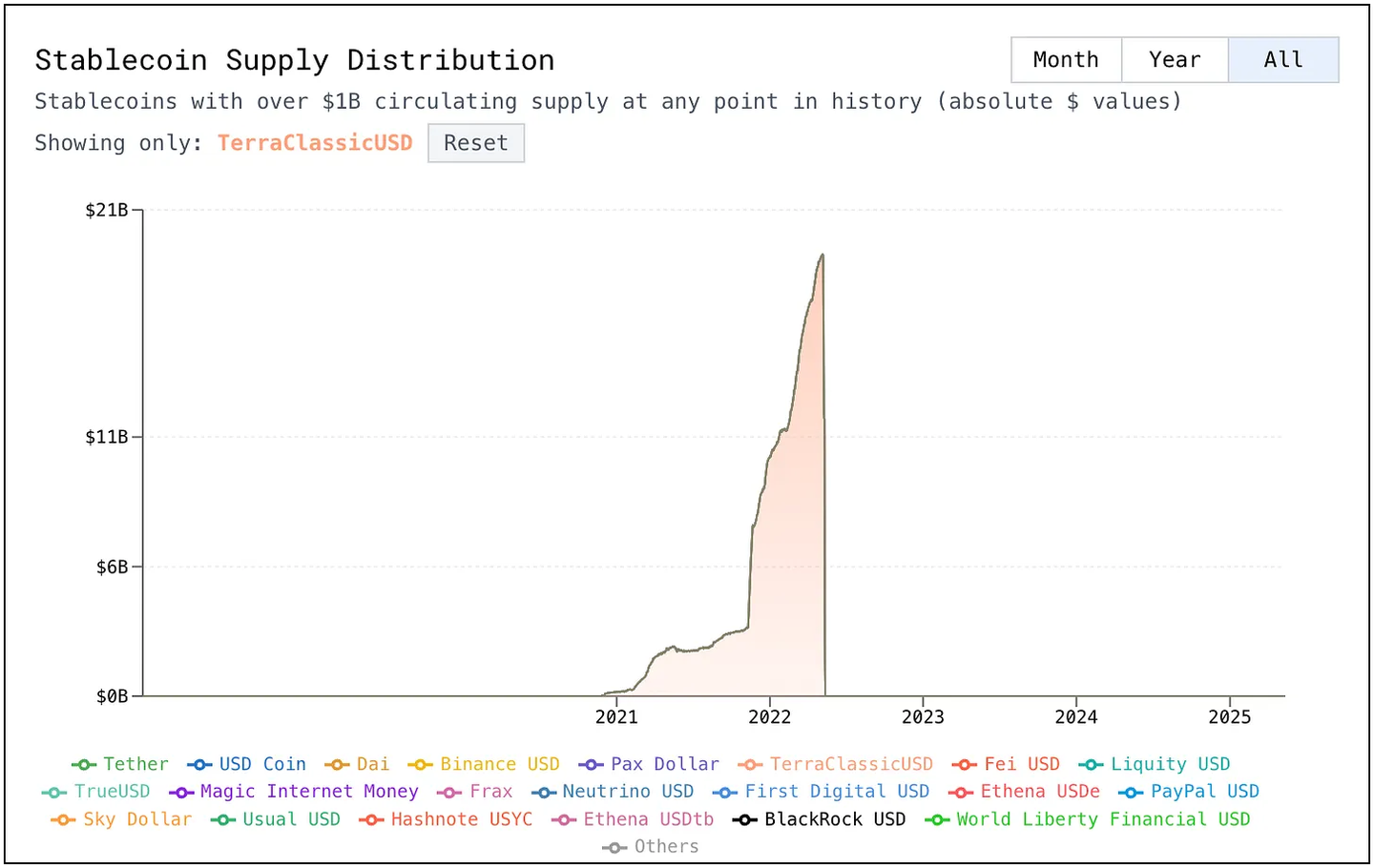
The other two categories of algorithmic stablecoins include:
Rebalancing Stablecoins: Rebalancing stablecoins maintain a $1 peg by directly adjusting the supply in users' wallets. When the price is above $1, the token balance increases proportionally; when the price is below $1, the balance decreases. This elastic supply model does not rely on minting or redemption mechanisms. Ampleforth (AMPL) is the most well-known example.
Partially Algorithmic Stablecoins: These stablecoins combine partial collateral support with algorithmic supply control. A portion is backed by assets like USDC or ETH, while the remainder relies on programmatic adjustments. The early FRAX adopted this model, maintaining a collateralization ratio below 100%, such as 90% backed by USDC.
Since the collapse of Terra Luna and UST, experiments with algorithmic stablecoins have sharply declined, with many projects (such as Frax Finance and Near Protocol) abandoning the model. This retreat is partly due to regulatory resistance: proposed legislation in the U.S. suggests a two-year ban on new algorithmic stablecoins, while the EU's Markets in Crypto-Assets Regulation (MiCAR) has outright banned such stablecoins, specifically targeting "endogenously collateralized" stablecoins. Although the appeal of decentralization and capital efficiency may drive some experiments to continue, we anticipate that algorithmic models will remain niche. The risks of de-pegging and an increasingly stringent regulatory environment may limit their role in the future growth of the stablecoin market.
Strategy-Backed Stablecoins
A new category of "stablecoins" has recently emerged—these tokens maintain a $1 valuation while embedding yield-generating investment strategies. These tools are more akin to dollar-denominated open-ended hedge fund shares than traditional stablecoins. This concept was proposed in March 2023 by BitMEX founder and perpetual futures contract pioneer Arthur Hayes, who introduced a hypothetical stablecoin, NUSD, structured as: 1 NUSD = 1 dollar of Bitcoin + shorting 1 BTC/USD inverse perpetual swap. Inspired by this, Guy Yang founded Ethena, whose strategy-backed stablecoin USDe has become a leading project in this emerging category.
Each USDe is minted by depositing an equivalent amount of dollars in crypto assets (such as ETH, BTC, or liquid staking tokens) while shorting an equivalent notional value through perpetual swaps or futures. This creates a "long + short" neutral basis trade, where the price fluctuations of the underlying asset are offset by the short position, keeping the net portfolio value around $1. This structure allows USDe to maintain a 1:1 full collateralization without the typical over-collateralization buffer seen in traditional cryptocurrency-backed stablecoins.
USDe also has yield-generating characteristics. The short position earns financing payments when the perpetual swap financing rate is positive. In this sense, Ethena effectively provides/funds leverage to the market, as the demand for leverage in the crypto market tends to be cyclical but high. Users can stake USDe to receive sUSDe (yield-bearing tokens) to capture this yield, with sUSDe functioning similarly to a savings tool, accumulating returns from financing rates, liquid staking rewards, and other protocol revenues, while the underlying USDe remains an interest-free stablecoin if idle. In 2024, the average annualized yield for sUSDe was around 19%, reflecting strong demand in the crypto market for leverage and staking rewards.
The launch of Ethena and USDe has sparked many other strategy-backed stablecoins, such as Resolv USD and the recent Neutrl, which tokenizes OTC arbitrage trades (long discounted OTC rounds, short perpetuals).
We refer to these strategy-backed stablecoins as dollar products or synthetic dollar products, but it is important to note that their risk characteristics differ from what many consider traditional stablecoins (i.e., those based on Treasuries or short-term government debt instruments).
Alright, I will continue the translation from the previous document you provided, starting from the "The Case for Stablecoins" section, maintaining the same style as before, ensuring accurate conveyance of the original content while keeping the language fluent and professional. If you have specific requests (such as translating to a certain section, providing a summary, or adjusting the depth of translation), please feel free to let me know. Here is the translation of the "The Case for Stablecoins" section, and I will continue to translate the subsequent content in order.
Use Cases for Stablecoins
Store of Value
While most investors, especially Bitcoin investors, recognize that the dollar is slowly losing purchasing power due to ongoing inflation and currency devaluation, as Ray Dalio aptly described, "the dollar is still the least dirty shirt in the laundry basket." In fact, over 20% of the global population lives under regimes with inflation rates of 6.5% or higher, and over 51% of the population faces worse inflation than the U.S. (2025 data). In countries suffering from hyperinflation, currency devaluation, or strict capital controls, citizens and businesses are initiating a grassroots financial transformation: increasingly turning to dollar-pegged stablecoins as a means of storing value. In economies such as Argentina, Turkey, Lebanon, Venezuela, and Nigeria, people choose to hold digital dollars (like USDT, USDC, or DAI) instead of rapidly depreciating local currencies. In these environments, stablecoins serve more as digital savings accounts rather than payment channels, providing a more stable purchasing power protection solution.

The effectiveness of currency as a store of value depends on several core economic fundamentals. When these fundamentals deteriorate, confidence in the currency gradually weakens. Key drivers include:
Inflation: Low and stable inflation is crucial for maintaining the value of currency. High inflation can quickly erode purchasing power.
Monetary Policy: If the market perceives a lack of discipline or independence from the central bank—such as financing deficits through money printing or implementing unorthodox policies—the value of the currency may plummet. Turkey is an example: despite an average inflation rate exceeding 40%, the central bank lowered interest rates in 2022-2023, undermining credibility and leading to a 300% decline in the value of the lira from 2020 to 2023.
Fiscal Discipline: Unsustainable fiscal policies can lead to currency devaluation. If a government runs deficits for an extended period and accumulates debt that investors doubt it can repay, it may resort to monetizing the debt (i.e., printing money). This expands the money supply, triggers inflation, and damages the currency's value. For instance, Lebanon's government debt default and deficit monetization in the late 2010s led to a currency collapse and triple-digit inflation.
Money Supply: The rate of money supply expansion relative to actual economic growth affects long-term value. If the money supply grows far faster than economic growth (common when central banks fund government spending or bail out banks), it typically leads to inflation and devaluation. For example, during hyperinflation in Venezuela, the money supply surged, leading to the collapse of the bolívar as a store of value.
Capital Controls and Convertibility: The attractiveness of currency as a store of value also depends on the ability to freely convert or transfer value. When governments implement capital controls—restricting access to foreign exchange, cross-border transfers, or fixing unrealistic exchange rates—the currency becomes "trapped," often overvalued domestically. This undermines confidence, as people worry about their inability to exit to stable assets when needed.
Political and Institutional Stability: Broader political risk factors also play a role. Regime instability, threats of expropriation or bank freezes, and a lack of rule of law can diminish confidence in local currency and banks. Lebanon's banking crisis is a typical example: from 2019 to 2020, banks implemented informal capital controls and froze deposits, destroying trust in holding wealth in local institutions.
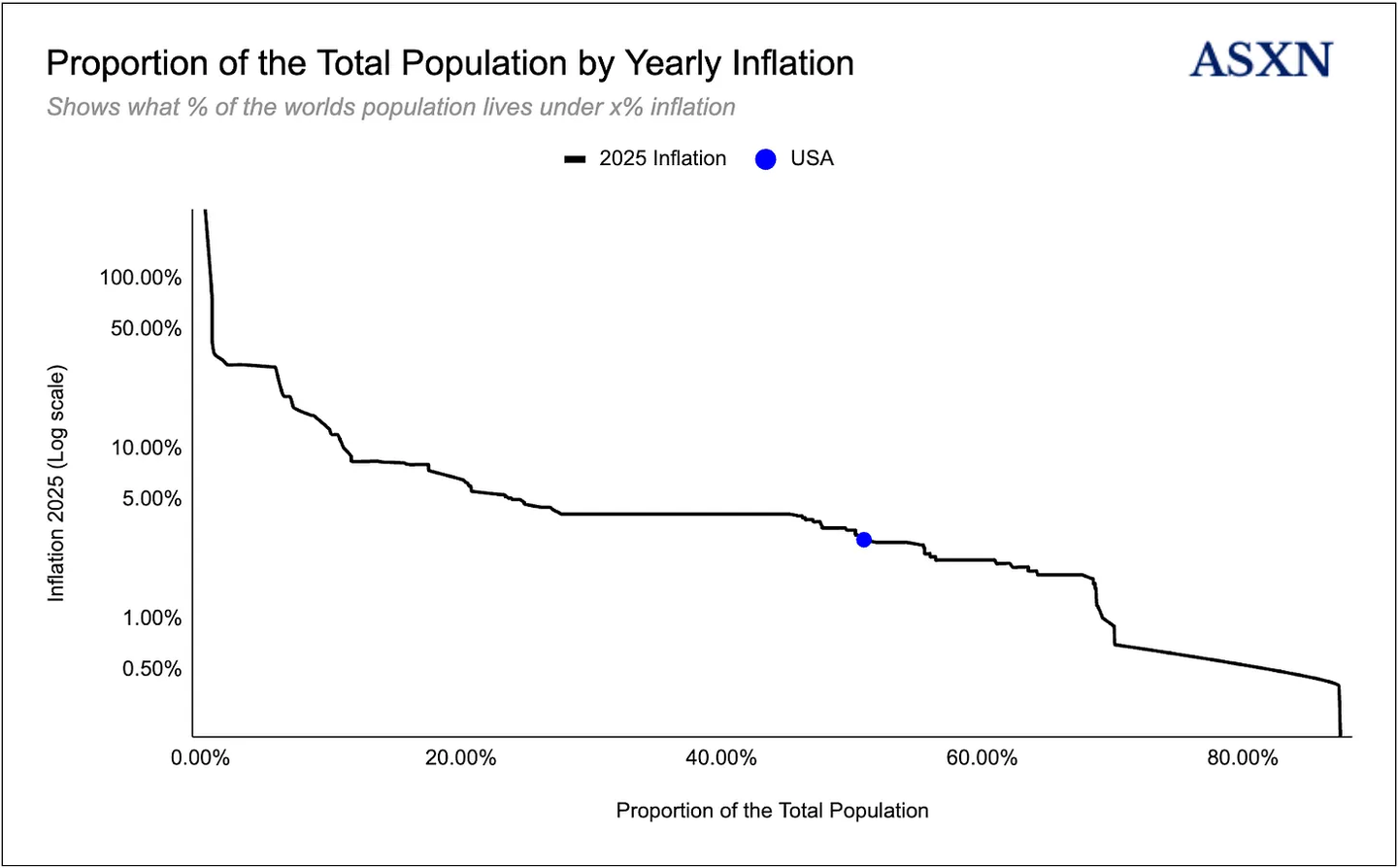
For many countries and the majority of the global population, the dollar has a relative advantage in the following key dimensions: lower inflation, fewer capital controls, and greater political stability. Additionally, the dollar provides access to the world's most liquid financial markets, supported by a (mostly) disciplined Federal Reserve that sets clear targets around core economic indicators.
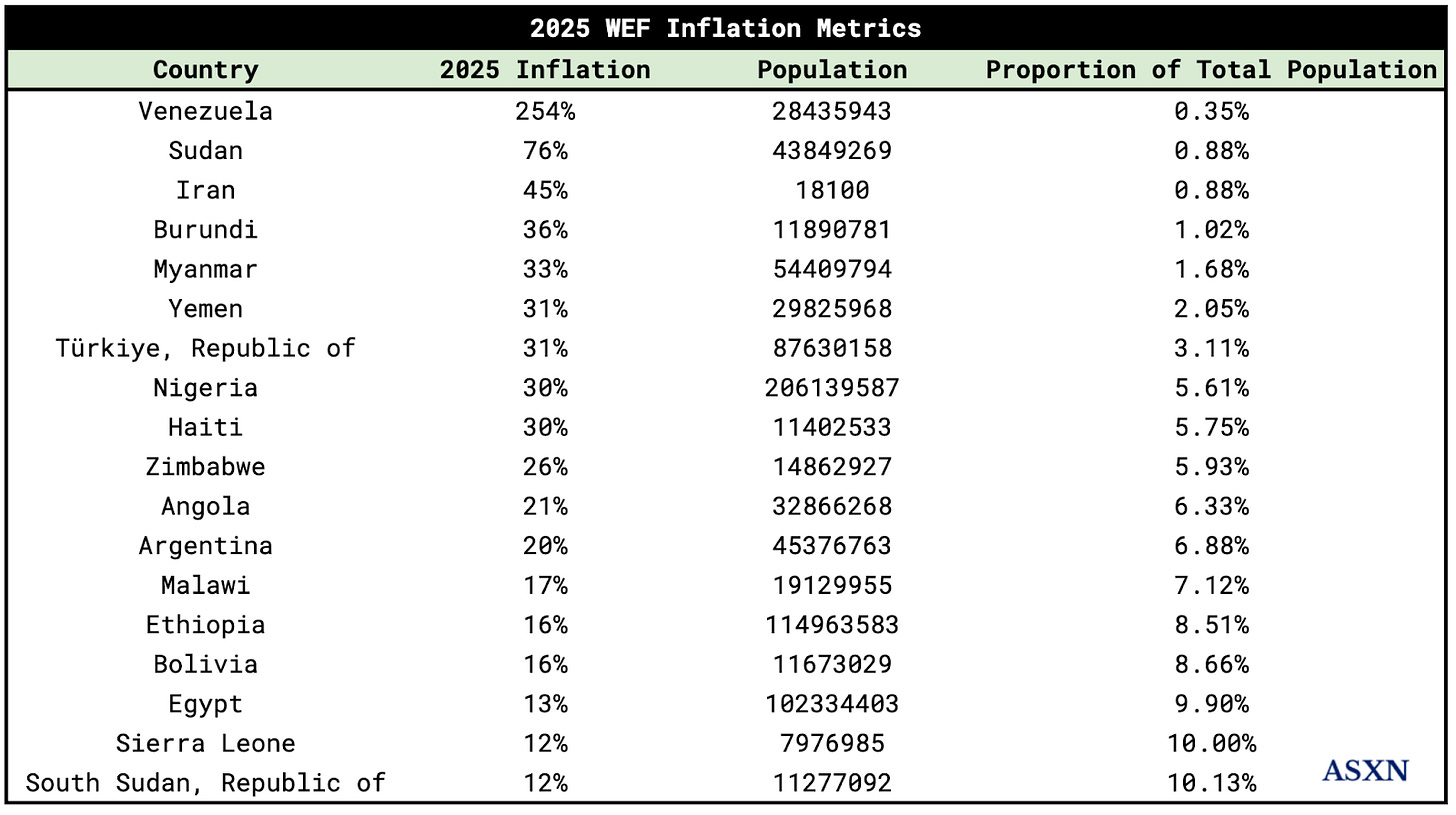
We can gain deeper insights into how citizens in emerging economies use stablecoins to protect their wealth through some case studies:
Argentina
Argentina is a typical case of capital fleeing to stable value through cryptocurrency. Decades of chronic inflation and repeated currency crises have eroded public trust in the peso. While the current inflation rate is around 20%, Argentina experienced inflation rates as high as 143% in 2023, pushing about 40% of Argentinians into poverty. In December 2023, newly elected President Javier Milei devalued the peso by 50%, calling it "shock therapy."
"To cope with this economic crisis, some Argentinians have turned to the black market for foreign currency, most commonly the dollar. This 'blue dollar' is traded at parallel, informal exchange rates, typically purchased through secret exchange houses known as 'cuevas' across the country. Others have explored dollar-pegged stablecoins, as reflected in our data.
We analyzed the monthly stablecoin trading volume against the Argentine peso (ARS) on Bitso, a leading trading platform in Latin America, and found that the persistent decline in the peso's value consistently triggered spikes in stablecoin trading. For example, when the ARS fell below $0.004 in July 2023, the following month's stablecoin trading value surged to over $1 million. Similarly, when the ARS dropped below $0.002 in December 2023 (when President Milei announced the devaluation), the next month's stablecoin trading value exceeded $10 million." — Chainalysis
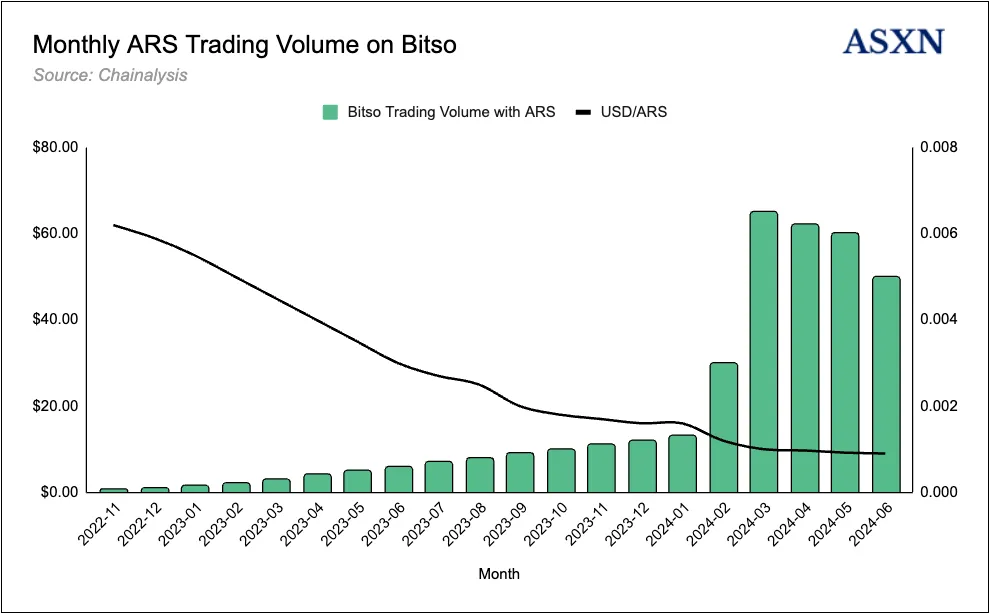
USDT is widely used in certain circles for everyday transactions, effectively becoming a parallel currency. Even the Argentine tax authorities have taken notice—Mendoza province began accepting stablecoin payments for taxes in 2022, legitimizing their actual role as currency. For ordinary Argentinians, stablecoins are a lifeline: a way to hold a "dollar" that won't rapidly devalue without special permissions.
Lebanon
Lebanon's financial collapse that began in 2019 illustrates why ordinary citizens turn to stablecoins when traditional financial systems fail. The Lebanese pound (LBP) lost over 98% of its value during the crisis, personal savings were destroyed, and by 2023, inflation exceeded 200%. Meanwhile, banks froze dollar accounts and imposed arbitrary withdrawal limits, effectively implementing capital controls that cut off depositors' access to their funds. In this financial paralysis, many Lebanese turned to crypto assets, particularly stablecoins, as a practical alternative to the dollar.
Tether USDT rapidly gained popularity in Lebanon, becoming the actual quoting currency for local currency exchangers and traders, forming a crypto-based parallel exchange market. One report described USDT as "the preferred cryptocurrency for bypassing bank restrictions." Its peer-to-peer transferability allows users to circumvent the frozen banking system and the official currency peg, trading USDT for pounds or other cryptocurrencies through Telegram groups or local brokers. Once holding USDT, users possess a stable store of value insulated from hyperinflation, enabling online purchases or cross-border transfers—functions that are typically blocked under capital controls.
Lebanon also highlights the trust advantage of stablecoins, especially when paired with self-custody wallets. Domestic banks are widely viewed as bankrupt and untrustworthy, and storing funds in personal crypto wallets provides users with a sense of control and security. Many Lebanese view stablecoins as digital savings accounts, holding USDT or USDC for weeks or months, only converting to LBP when needed for consumption.
Summary of Stablecoins as a Store of Value
For brevity, we have only listed a few case studies, but Chainalysis provides a good overview of similar trends in Latin America. Overall, dollar-pegged stablecoins (like USDT, USDC, DAI) have strong appeal in high-inflation, capital-restricted economies. The following factors make them an attractive means of storing value:
Purchasing Power Protection: For people in Argentina or Nigeria, shifting from currencies that lose 20-100% of their value annually to dollar-pegged stablecoins can immediately achieve dollarization, halting the erosion of purchasing power. Even with U.S. inflation around 3-4%, the comparison remains significant. Stablecoins inherit the relative stability and credibility of the dollar, making them an attractive alternative in countries where trust in local currency has collapsed.
Self-Custody: Users self-custody their crypto keys, meaning their assets are not subject to the solvency of local banks or government freeze orders. This is a powerful feature in places where banks may be bailed out or withdrawals arbitrarily restricted (like Lebanon, Nigeria). With stablecoins, users can store $100 or $100,000 in a secure hardware wallet or even a paper backup, without the risk of local authorities devaluing or seizing their funds, unless the global crypto network is compromised.
Liquidity: Holding stablecoins is not just for passive savings; they also have high liquidity in transactions. This makes them functional in daily life. Traditional ways of exposure to dollars (like offshore accounts or physical cash) cannot match this liquidity.
Censorship Resistance: Traditional dollar channels (banks or remittance services) are susceptible to monitoring, censorship, or political interference. Stablecoins, especially when traded on peer-to-peer or decentralized platforms, can offer greater privacy and censorship resistance.
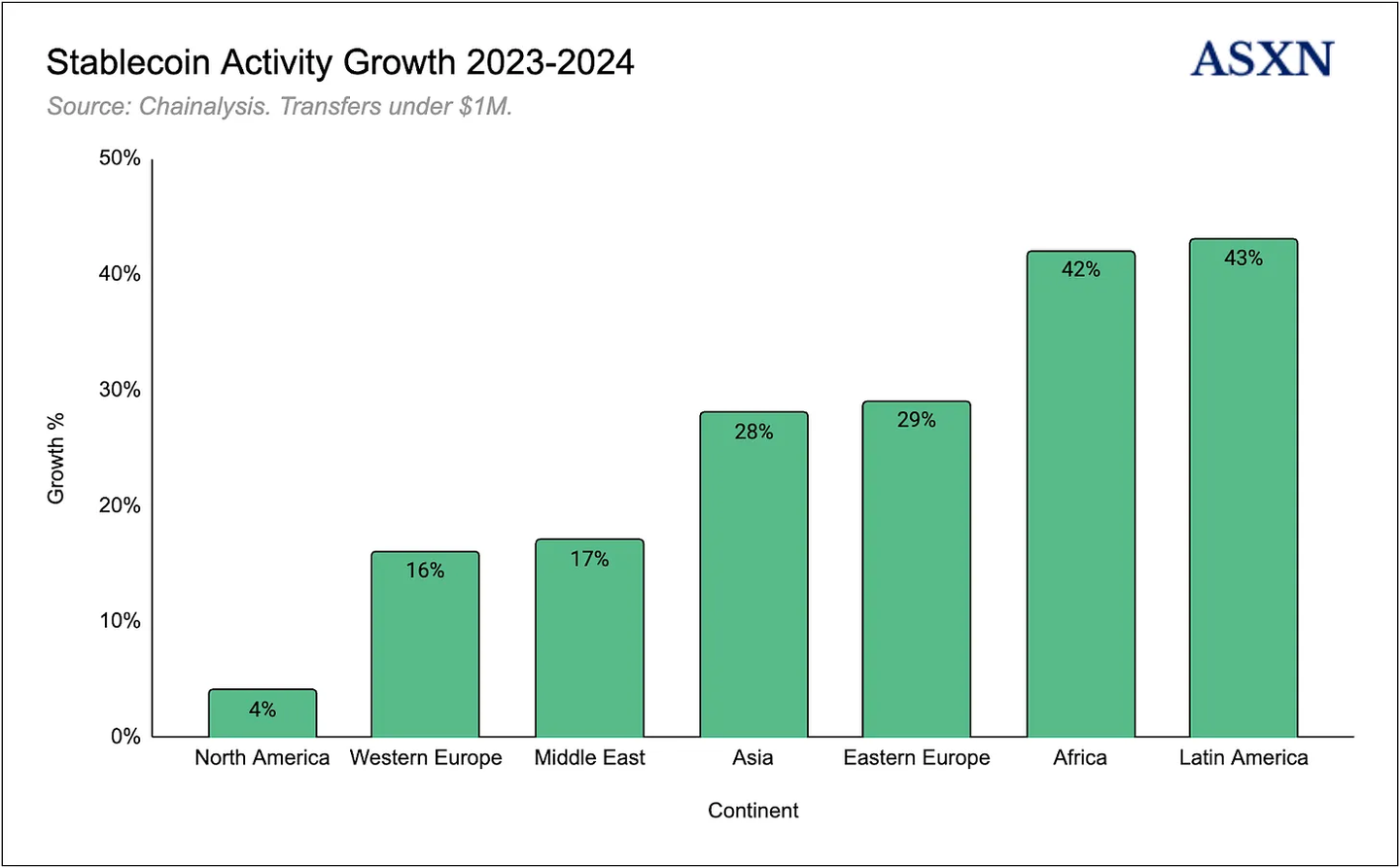
For these reasons, stablecoin activity is rapidly growing in Latin American and African countries. According to Chainalysis's de-anonymization software, transfers under $1 million have increased by over 40%.
Remittances
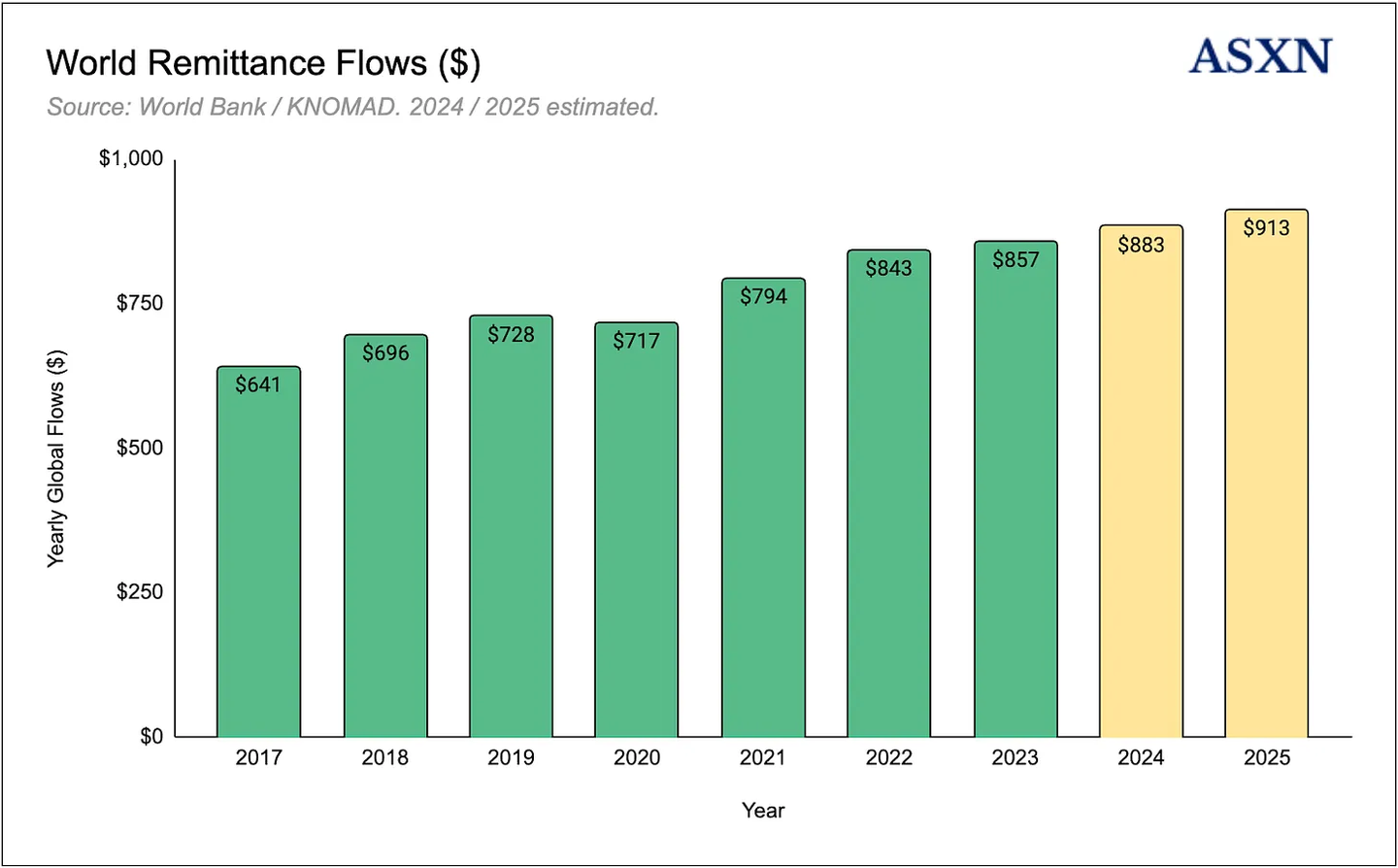
Remittances are one of the primary use cases for stablecoins. Every year, tens of millions of workers send part of their wages back home, supporting over 200 million beneficiaries globally. In 2024, global remittance flows reached approximately $905 billion, equivalent to the GDP of a medium-developed economy. This is expected to continue growing in 2025. About 76% (approximately $685 billion) flows to low- and middle-income countries (LMICs), where remittances often serve as a lifeline for household economies, covering basic needs such as food, education, and healthcare.
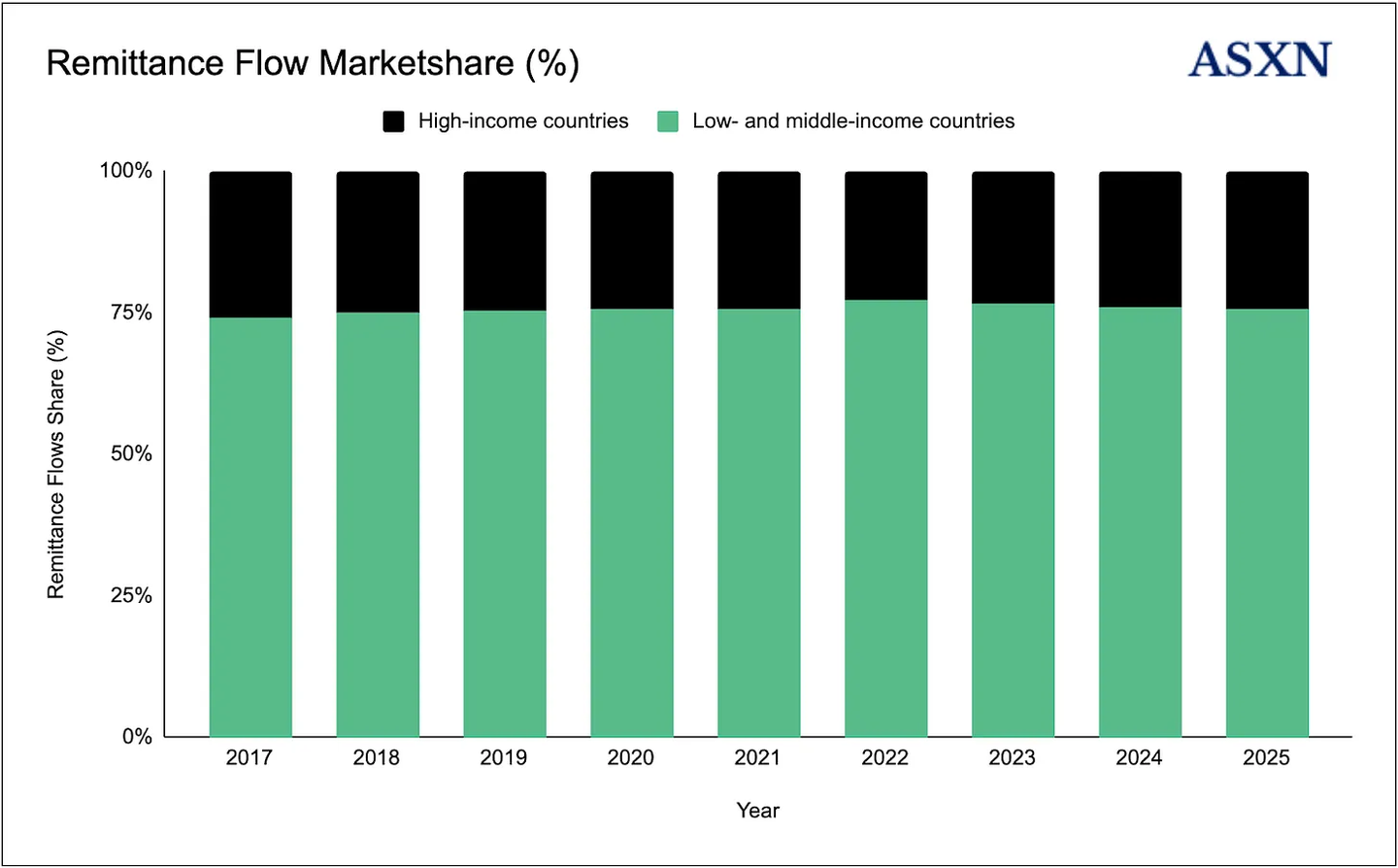
Remittances are highly concentrated in LMICs, which often face the value storage challenges we mentioned earlier, including weak local currencies, capital controls, and political instability. This makes cross-border inflows particularly susceptible to value erosion—providing a strong rationale for the adoption of stablecoins as a more resilient and efficient alternative.

Stablecoins are well-suited for remittances, not only because they provide a more stable store of value (especially dollar-pegged stablecoins) but also because they offer faster, cheaper, and safer cross-border transfers. Currently, most remittances are sent through traditional banks, money transfer operators like Western Union and MoneyGram, or mobile money platforms like M-Pesa in certain regions. Although these channels are widely used, they often involve high fees and delayed settlements. In the fourth quarter of 2023, the global average cost of sending $200 was about 6.4%. In some channels, this figure exceeded 10%. For budget-constrained individuals, losing such a large percentage in remittance costs is a significant burden. These costs resemble a regressive tax on the world's poorest workers, and although the 2030 Sustainable Development Goals aim to reduce global remittance costs to 3%, fees still grow at an annual rate of 3.2%.
In the major remittance channels, banks remain the most expensive, with an average cost of 12% in the fourth quarter of 2023. Post offices follow at 7.7%, money transfer operators average 5.5%, and mobile money services are the lowest at 4.4%. Despite mobile operators having the lowest costs, their share of total remittance volume is less than 1%. In addition to high costs, traditional remittance methods often involve delays. Recipients may have to wait 2-5 business days for funds to clear, as payments must go through multiple intermediary banks. Along the way, hidden fees and unfavorable exchange rate markups further reduce the final amount received.
Stablecoins for Remittances
Stablecoins and their operating cryptocurrency rails provide an internet-native alternative that optimizes speed, transparency, and low cost. Just as the internet revolutionized global instant information transfer, stablecoins have achieved a similar transformation for value transfer. Because they operate on public blockchains, transactions settle in seconds and are available 24/7.
While the global average remittance fee is 6.4%, on-chain transaction costs are often calculated in cents or even fractions of a cent, thanks to recent advancements in blockchain scalability. For example, the average transfer fee on Base over the past two weeks was only $0.00024, while Ethereum's was $0.155. High-throughput blockchains like Solana and the upcoming Plasma are expected to further reduce costs, with Plasma aiming for zero fees on USDT transactions.
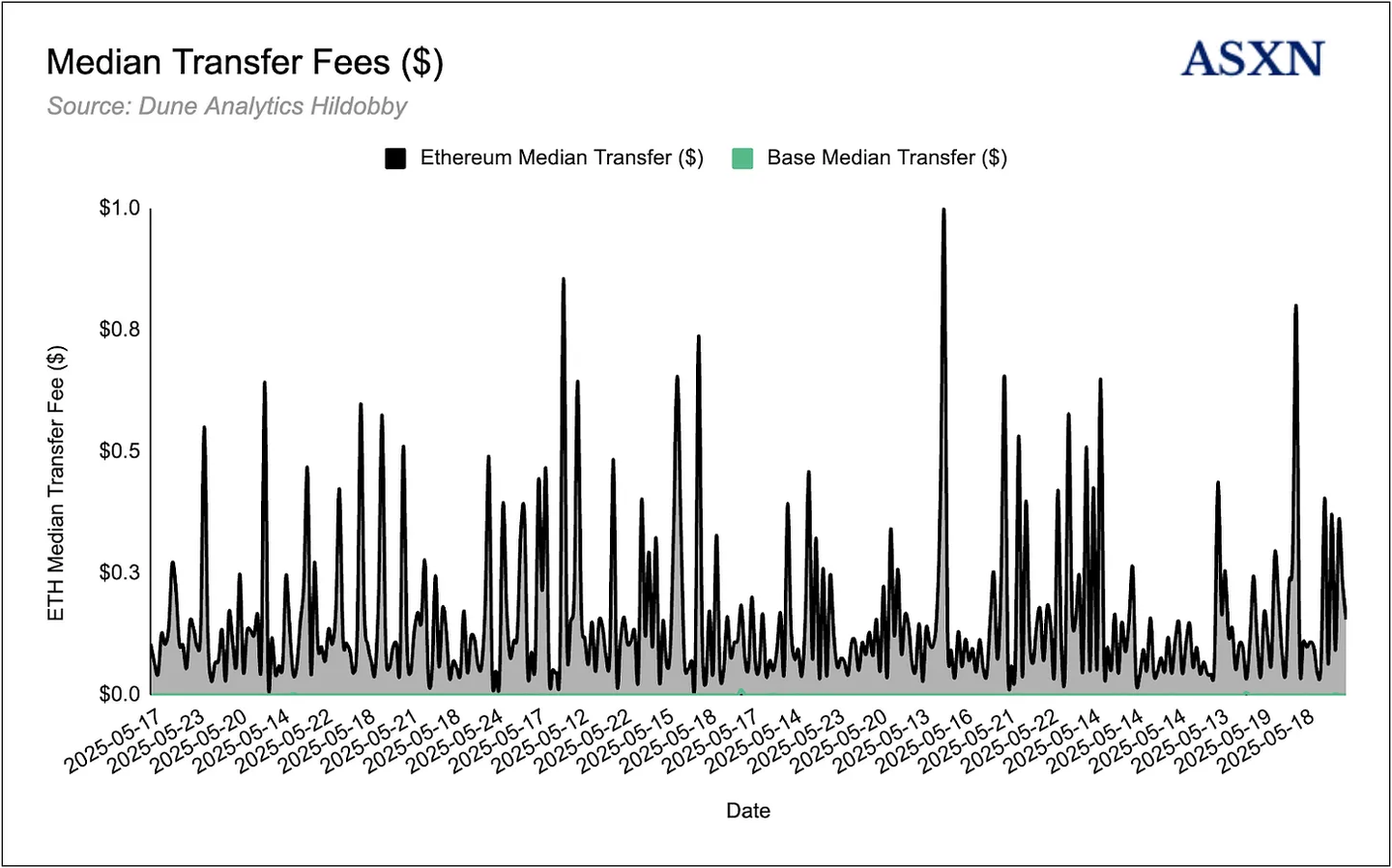
Moreover, the entire payment path is visible on the blockchain. There is no need for banking relationships or pre-existing accounts: anyone with an internet connection and a digital wallet can send or receive stablecoins, providing access to regions with limited or underdeveloped banking infrastructure. Senders can fund USDC or USDT through debit cards or bank transfers, almost instantly transferring these tokens across borders and exchanging them for local currency through local partner networks. Even accounting for withdrawal fees (which can be as low as 0-2% in competitive channels), total costs are typically below 2% of the transaction. This reduction in time and cost represents a significant improvement for families relying on remittances for their livelihoods.
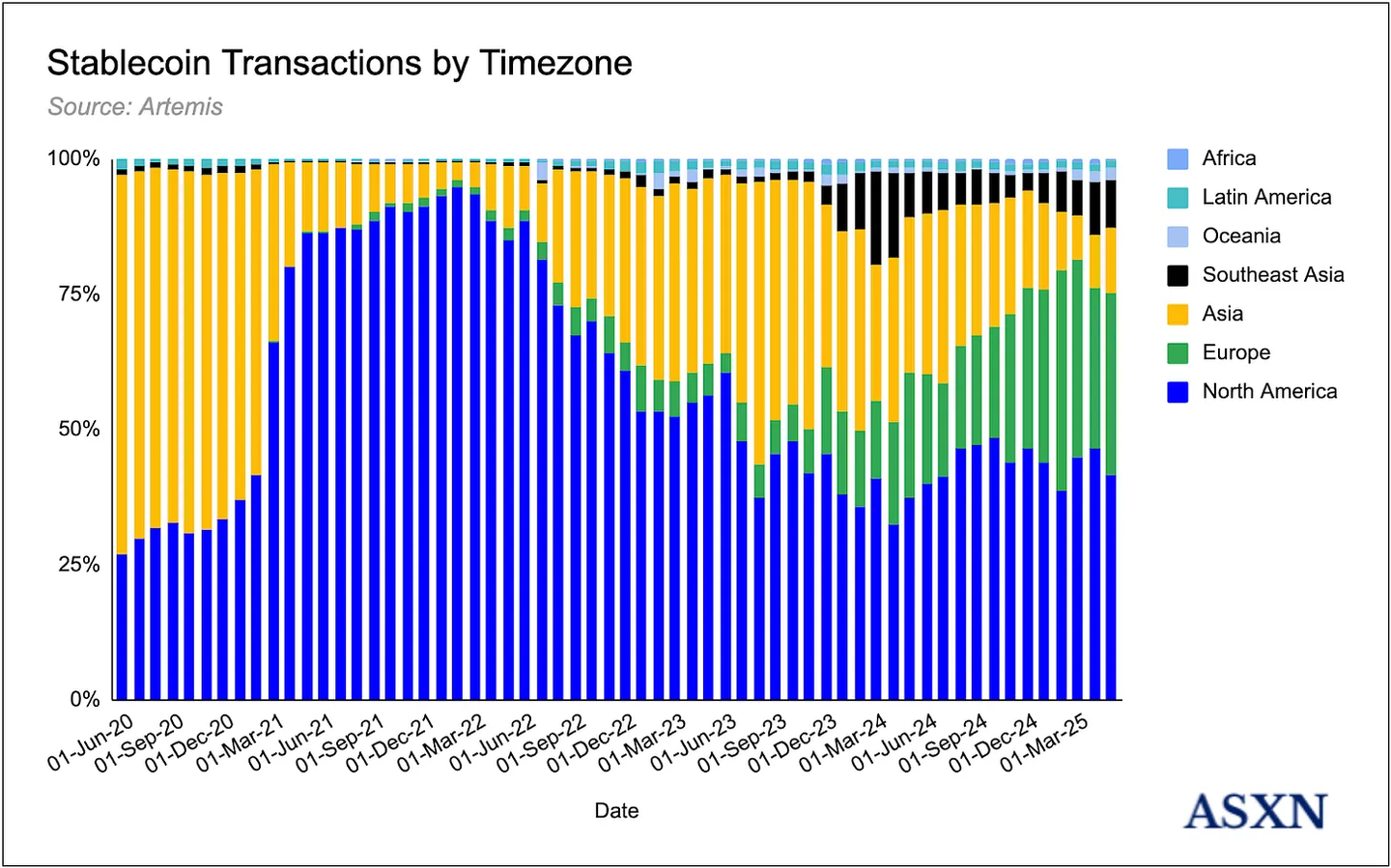
Payments
While remittances are a unique subfield, the broader global payment ecosystem—which encompasses consumer transactions, business-to-business cash flows, public sector and social spending, and emerging embedded rails—continues to struggle with the limitations of traditional infrastructure. Core limitations include high costs, slow settlement times, low transparency, and poor interoperability. Despite these structural inefficiencies, the global payments industry remains one of the largest in the world, processing 3.4 trillion transactions in 2023, involving $180 trillion in value and generating $2.4 trillion in revenue.
Let’s briefly look at the most commonly used payment rails today to understand how stablecoins and crypto rails can reduce fees and settlement times, thereby improving the profitability and operational efficiency of global businesses:
- Card Networks: Card networks and payment cards originated with the launch of the Diners Club credit card in 1950 and have since expanded to process over $40 trillion in transactions globally each year. Card payment systems are a multi-party network connecting four core participants: cardholders, merchants, issuing banks (which provide and authorize cards), and acquiring banks (which settle funds on behalf of merchants). These participants interact through open-loop schemes (Visa, Mastercard) or closed-loop networks (American Express). When consumers make a payment, data flows from the merchant's gateway (encrypting and routing information) to the payment processor, then through the card network to the issuing bank for authorization. Once approved, funds are captured and ultimately settled in bulk cycles. The fee structure—interchange fees charged by issuing banks, scheme fees charged by networks, and settlement fees charged by acquiring banks—is set by the card networks and varies by region and card type, typically ranging from 2-3% of the transaction plus a fixed fee (around $0.30). Modern payment service providers (PayFacs) and orchestration platforms simplify merchant access and optimize routing, improving acceptance rates and reducing costs.
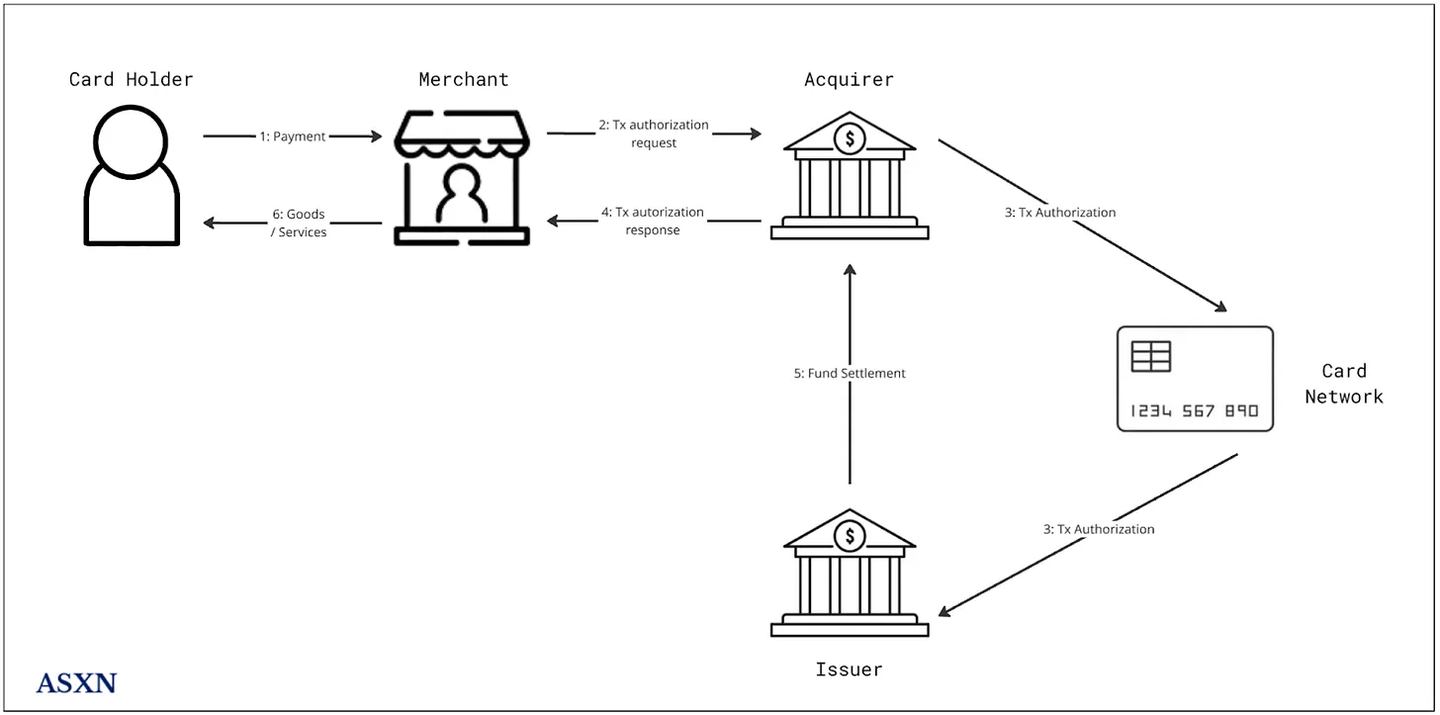
ACH (Automated Clearing House): ACH is the foundational payment network in the U.S., moving trillions of dollars annually between over 10,000 financial institutions. Originally developed in the 1970s to replace paper checks, ACH gained nationwide adoption when the federal government used it for social security payments. Today, it supports everything from direct deposits and utility bill payments to business vendor payments. The system processes credit ("push") and debit ("pull") transfers, operating in batches rather than in real-time. Each transaction involves the originator, their bank (ODFI), the operator (such as the Federal Reserve or a clearinghouse), and the receiving bank (RDFI). The originating bank assumes responsibility for the legitimacy of the transaction, especially in debit scenarios—hence the 60-day consumer dispute window. Same-day ACH, launched in 2015, allows for faster processing but still faces transaction limits and a lack of international coverage. Despite its age, ACH remains deeply embedded in the U.S. financial infrastructure due to its reliability, ubiquity, and relatively low cost compared to card networks ($0.21-$1.50).
Wire Transfers: Wire transfers are the backbone of high-value, time-sensitive payments in the U.S., primarily facilitated through the Fedwire and CHIPS systems. Fedwire, operated by the Federal Reserve, uses real-time gross settlement (RTGS) to process transactions instantaneously, crucial for securities settlements and large corporate transactions. CHIPS, owned by major U.S. banks and operated by a clearinghouse, serves fewer institutions and reduces liquidity needs through net settlement, with most transfers settling the same day. Once sent, wire transfers are typically irreversible, making them a reliable rail for final settlement. For international wire transfers, banks often rely on SWIFT, a secure global messaging network used by over 11,000 financial institutions to transmit instructions rather than direct funds. SWIFT-supported cross-border payments typically settle within one business day, but this depends on the chain of intermediary banks. Together, they move trillions of dollars daily, supporting the global payment infrastructure.
Payment Apps: Peer-to-peer payment apps like Venmo and PayPal allow individuals to digitally send and receive funds within a closed network, requiring users to create accounts and log in to transact. These platforms provide a seamless, low-friction user experience in developed markets, often allowing free personal transfers via linked bank accounts or balances, with settlement times being instant or less than a day. However, cross-border payments are more complex, involving additional fees, currency conversion, and regulatory friction. While peer-to-peer transfers may be free, business-related transactions typically incur fees of around 3%, which is attractive for personal use but can be costly for merchants or business transactions.
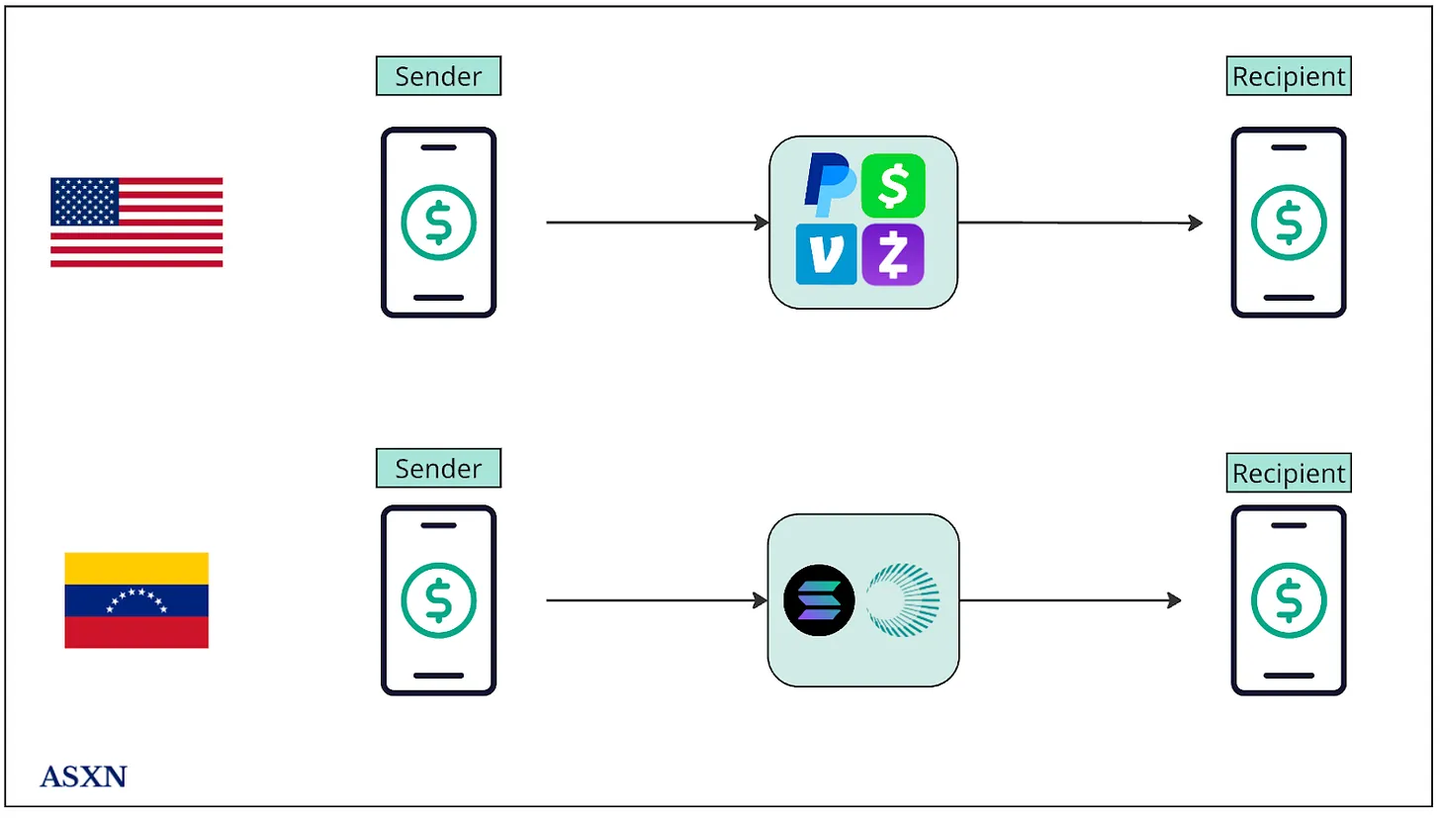
While the banking experience in the U.S. is seamless, stablecoins provide users in countries with high inflation and low trust in the banking system, like Venezuela, a secure way to transfer value.
A16Z provides a comprehensive overview of traditional payment methods, detailing associated costs, settlement times, and operational details. Compared to crypto rails, these traditional systems appear outdated—characterized by high transaction costs, slow settlements, return risks, closed networks, and limited accessibility.
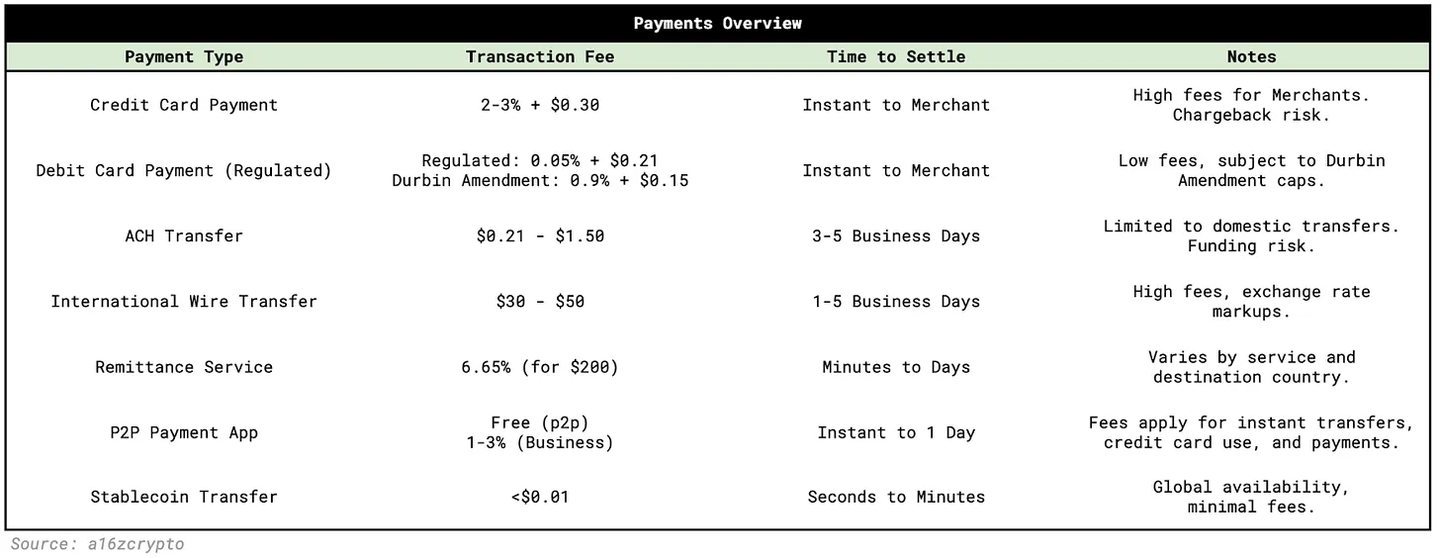
Merchants and Enterprises
In our view, stablecoin-based payments will have the most direct impact on U.S. businesses, particularly those targeting the U.S. as the world's largest consumer market. This is primarily due to the high credit card usage rate in the U.S. and its associated processing fees.
A16Z provides a compelling case study highlighting the profit potential of integrating stablecoin payment infrastructure into large U.S. enterprises. By reducing payment processing fees to 0.1%, the improvement in profitability is significant:
Walmart: Reporting revenue of $648 billion for fiscal year 2024, it may pay around $10 billion in credit card fees, while net income is $15.5 billion. Eliminating these fees could boost profits by over 60%, significantly enhancing valuation.
Chipotle: With revenue of $9.8 billion and net income of $1.2 billion, credit card fees are approximately $148 million. Reducing these fees could increase profits by 12%—no other line item on the income statement can match this increase.
Kroger: Operating on a profit margin of less than 2%, the potential card fees are comparable to its net income. For low-margin retailers like Kroger, stablecoin payments could double profitability.
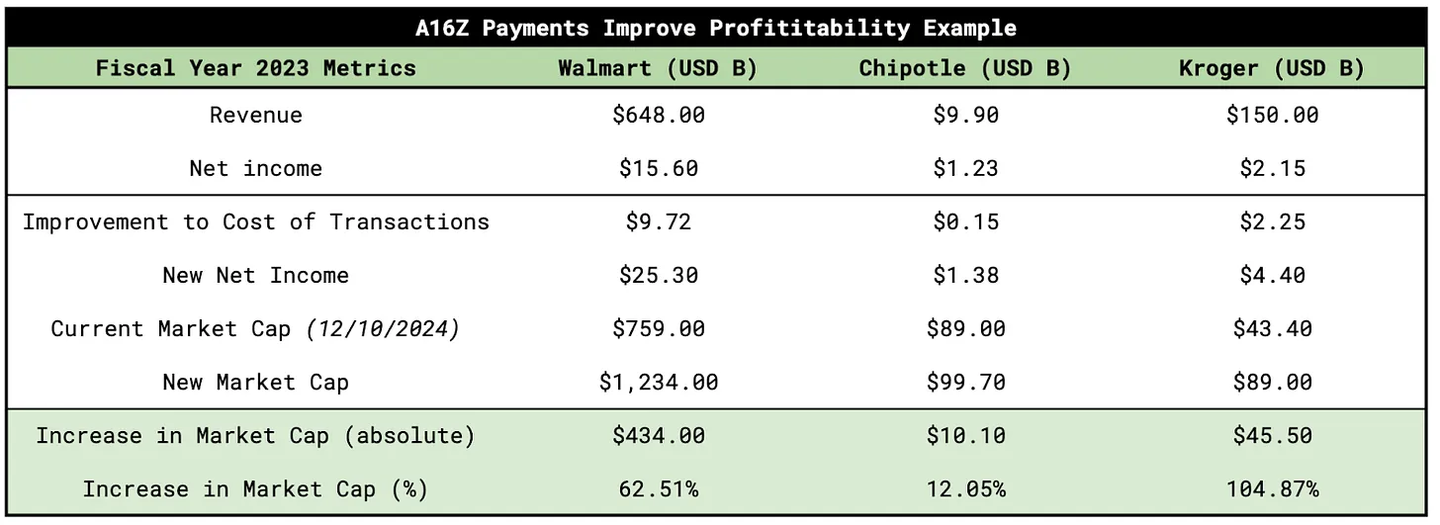
In short, for large U.S. enterprises facing significant burdens from payment processing costs, crypto-native rails—especially stablecoins—offer an underutilized opportunity to unlock margins and enhance enterprise value. According to a recent report by The Wall Street Journal, Walmart and Amazon are exploring issuing their own stablecoins.
Cross-Border Business Payments
Cross-border B2B transactions remain a significant bottleneck in global commerce. Even routine payments—such as a Kenyan distributor paying a Malaysian supplier—can pass through multiple banks and foreign exchange providers, each adding fees, delays, and settlement risks. What should be simple transfers often turn into multi-day processes, hampered by traditional infrastructure. Banks continue to dominate this space, handling about 92% of global B2B cross-border payment flows.
Payment service providers face similar challenges. Platforms like Stripe may take up to a week to complete international merchant payments, with funds tied up due to managing returns, currency risks, and settlement uncertainties. Shortening this cycle would free up substantial working capital and reduce systemic friction in the value chain.
This means that even a 1-2% reduction in transaction fees can significantly impact corporate profitability, as shown in previous case studies. Speed is equally critical: reducing settlement times from days or weeks to hours can greatly enhance working capital efficiency and improve overall cash flow management. You can learn more about B2B payments, cross-border vendor payments, accounts receivable, and foreign aid spending in Archetype's crypto rails report.
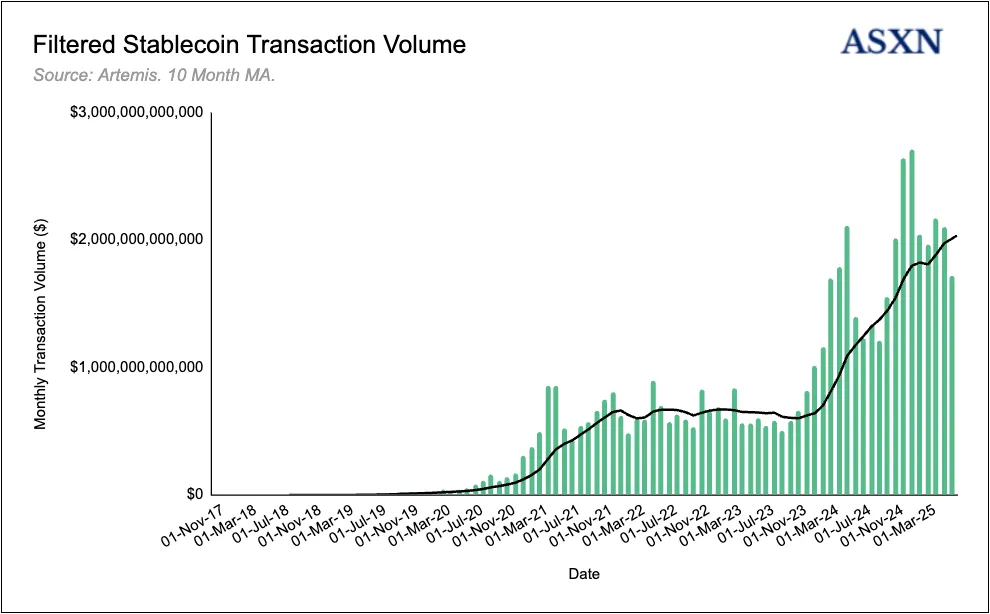
New Payment Use Cases
Stablecoin-based payments also open up entirely new use cases for internet-native payment infrastructure:
Instant Settlement and Availability: Stablecoins support near-instant transactions around the clock, suitable for time-sensitive payments that traditional financial rails cannot accommodate. Adoption is already underway: Robinhood CEO Vlad Tenev recently stated that the company "uses stablecoins to support our weekend settlements," which is not achievable with traditional infrastructure.
Programmable Payments: Stablecoins unlock more complex and automated payment processes through smart contracts and the inherently permissionless, composable nature of crypto infrastructure. Payments can be triggered by real-world events, executed conditionally, or streamed continuously—allowing backend payment processes to be fully automated and trustless. For example, Superfluid supports continuous salary streams paid per second, tied to active work sessions; while Centrifuge uses smart contracts to automatically release funds to vendors after verifying delivery milestones, with each transaction transparently recorded on-chain for real-time auditing.
AI Agents for Value Transfer: The ability of AI agents to transfer value is a foundational capability that will become increasingly important as these agents mature. In the short term, value transfer primarily supports the humans operating these agents—facilitating payments for services and products. However, as agents become more autonomous and capable, we expect a shift towards transactions between agents, independently executing tasks that coordinate, collaborate, and complete activities beyond individual scope. We believe a significant share of global value transfer will ultimately be executed by AI agents, with crypto rails serving as the natural infrastructure for this evolution. Unlike traditional banking systems, cryptocurrencies allow agents to create wallets and transfer value permissionlessly, without human-centered KYC processes, matching the speed, scale, and flexibility of agent-native economies. You can learn more in our AI thesis: [AI Thesis Link](https://stablecoins.asxn.xyz/ai-thesis).
Micropayments: Micropayments—typically defined as transactions under $1, sometimes just a fraction of a cent—are often used in digital-native use cases such as online tipping, in-game purchases, real-time royalties, and pay-per-use content. However, traditional payment rails are unsuitable for handling these transactions due to high fixed costs. For example, a $0.50 payment might incur a $0.30 fixed fee plus a 2% variable fee, resulting in a total cost of $0.31—over 60% of the transaction value. This cost structure makes micropayments economically unfeasible at scale. Stablecoins offer an appealing alternative, supporting low-cost, instant, and programmable settlements. By eliminating friction and overhead from traditional infrastructure, stablecoins unlock entirely new categories of applications based on micropayment models.
Shadow Monetary Policy Tools
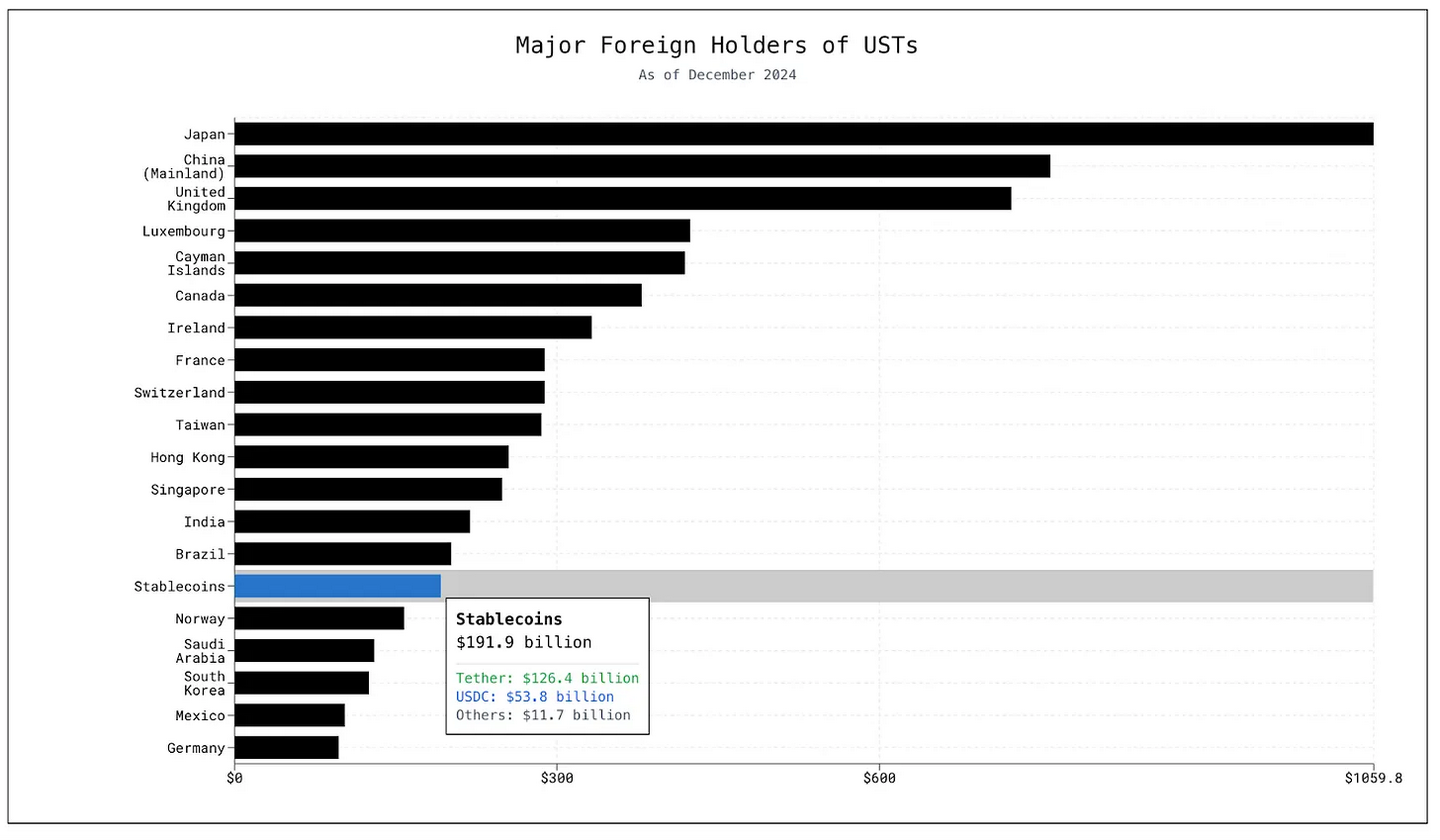
Stablecoins are becoming a powerful tool for shadow monetary policy, increasingly viewed by governments and treasury departments as a strategic tool for managing sovereign debt and promoting the influence of monetary and financial systems. In Washington, this use case is gaining focus as the U.S. government seeks innovative ways to control its debt burden. The mechanisms by which stablecoins help lower government borrowing costs are as follows:
As described in the stablecoin category section, fiat-backed stablecoins typically invest a significant portion of their reserves in short-term U.S. government debt instruments—primarily Treasury bills and repurchase agreements. This strategy allows centralized issuers to earn returns on customer deposits, serving as a revenue source or, in some models, passing it on to stablecoin holders.
As the market capitalization of fiat-backed stablecoins grows, demand for short-term U.S. government debt should increase roughly in linear proportion. Disclosures from leading issuers support this trend: Tether and Circle currently hold the majority of their assets in government-backed instruments. Circle reports that 88.5% of its reserves are held in U.S. Treasuries, while Tether holds approximately 82.2% in a combination of Treasuries, repurchase agreements, and money market funds.
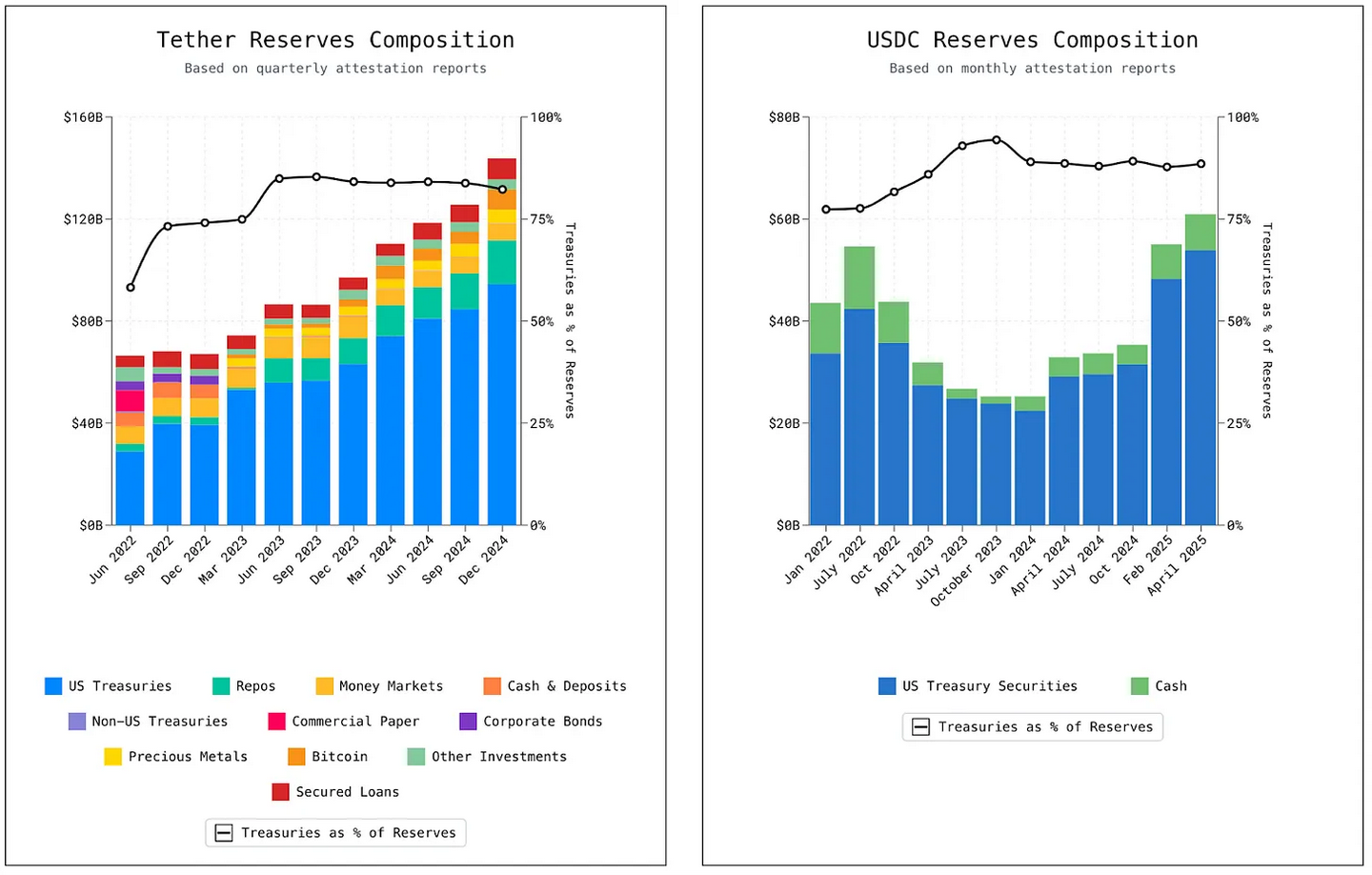
- This additional demand for government debt drives up bond prices, and given the inverse relationship between price and yield, this leads to lower yields. Consequently, the U.S. government can borrow at lower interest rates, reducing financing costs.
To fully understand the significance of this stablecoin use case, it is essential to grasp the current state of U.S. national debt and the trend of de-dollarization. These dynamics provide context for the potential role of stablecoins in consolidating the dollar's global dominance and creating sustained demand for U.S. government debt.
U.S. National Debt
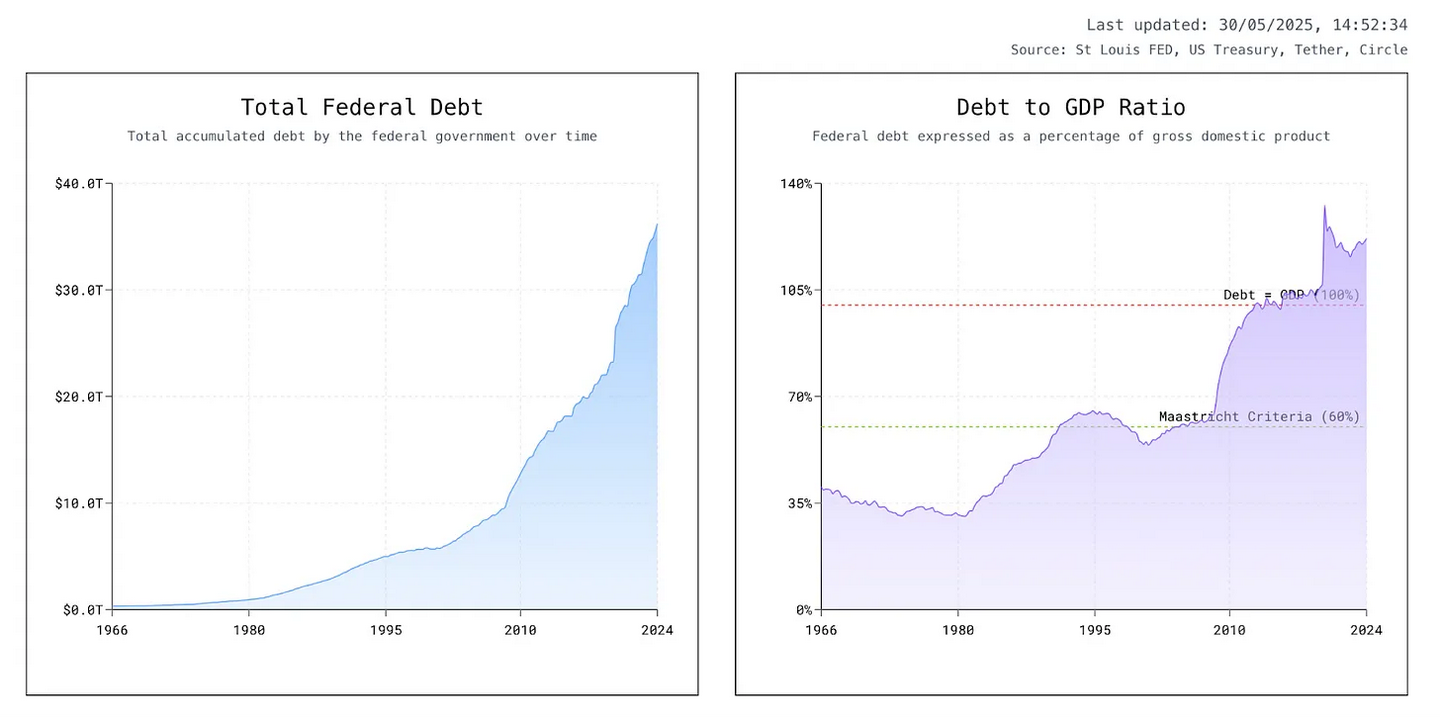
U.S. national debt has become a core political and economic issue over the past decade, with total debt reaching $36.22 trillion, approximately 123% of GDP. This growing debt burden presents a series of urgent and complex challenges. The economic agenda of the Trump administration was largely shaped by this reality. The Department of Government Efficiency (DOGE) was tasked with saving $1-2 billion annually by eliminating "fraud, waste, and abuse." At the same time, efforts to increase external revenue through tariffs and the External Revenue Service aimed to generate an additional $1-2 billion. Key figures like Bessent pushed to lower the yield on 10-year Treasuries while implementing deregulation and broad tax cuts to stimulate growth, helping the U.S. "grow out" of its debt problem.
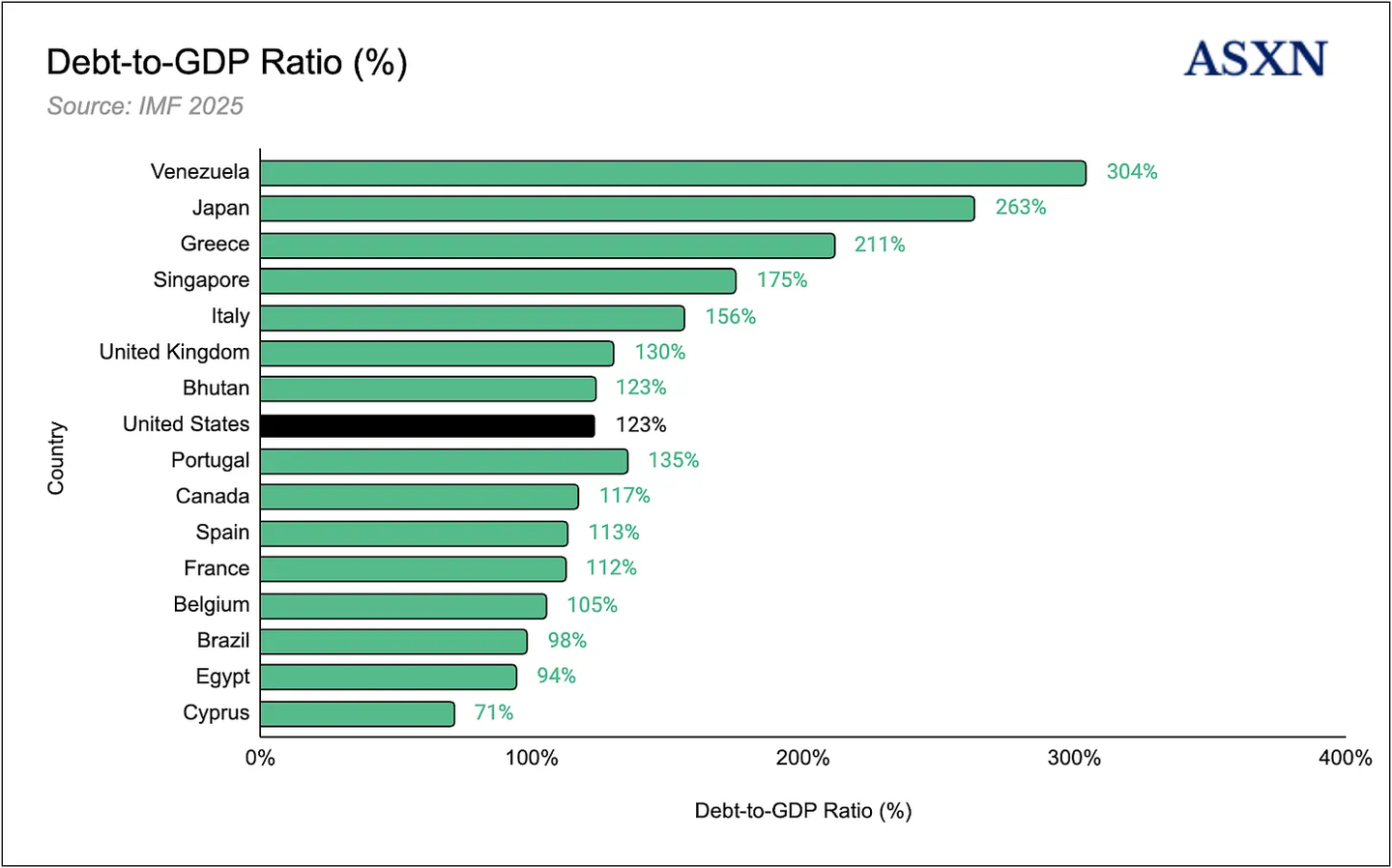
While the absolute level of U.S. government debt—now at $36.2 trillion, about 123% of GDP—is not uncommon for a global reserve currency, the speed of debt accumulation in recent years is concerning. The federal government has consistently run budget deficits, spending more than it earns. This structural imbalance was sharply exacerbated by the COVID-19 pandemic, as the government significantly expanded national debt through unprecedented fiscal stimulus measures like the CARES Act and the American Rescue Plan.
These interventions resulted in the largest deficit in U.S. history during peacetime, with the federal deficit reaching 14.67% of GDP in 2020. The long-term effects of this borrowing are now beginning to manifest. By 2025, $9.2 trillion of U.S. debt—approximately 25.4% of total debt—will mature or need refinancing. More than $6 trillion of this must be rolled over at rates significantly higher than those at the time of initial issuance.
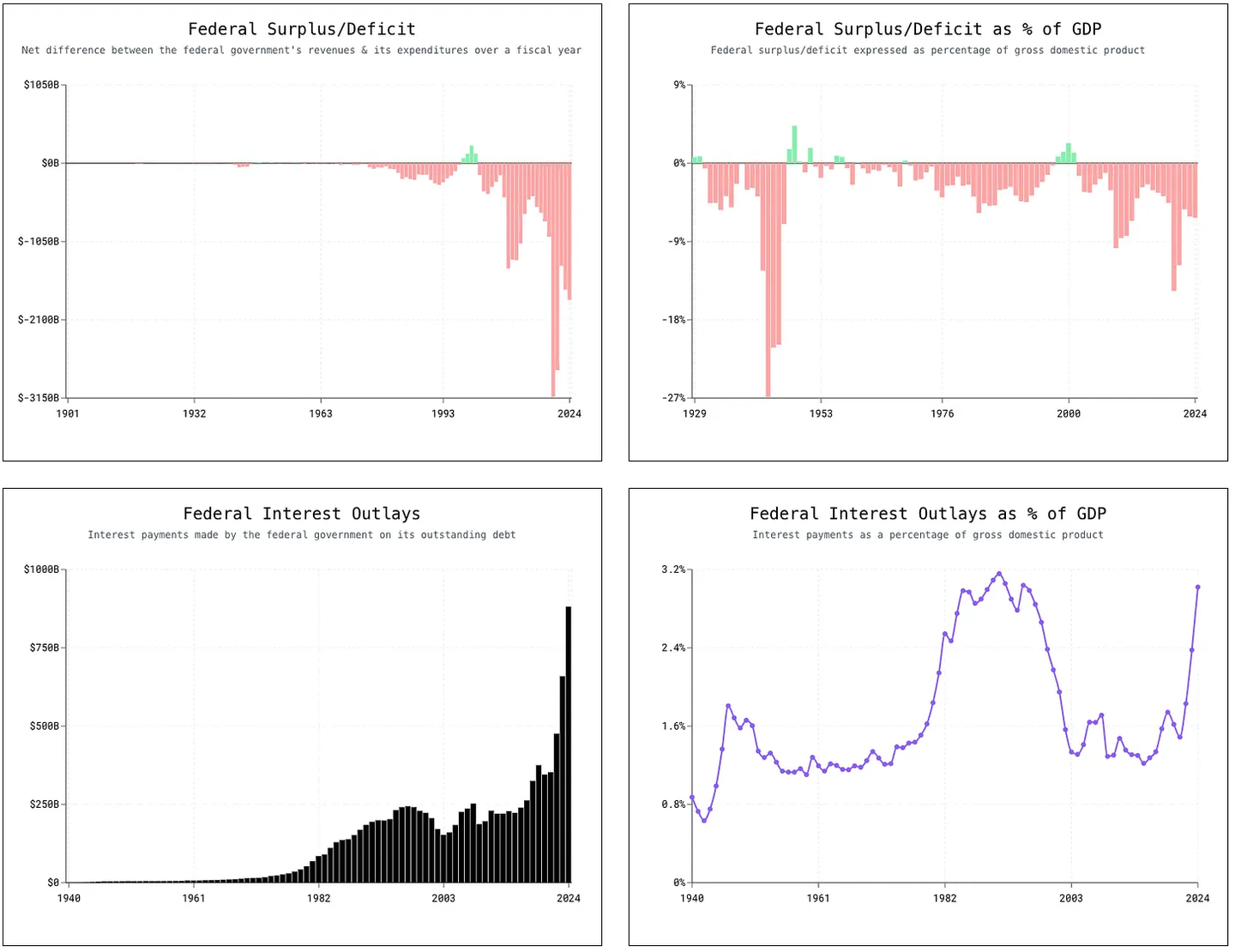
As a result, interest payments have surged, now becoming the second-largest expenditure in the federal budget, surpassing defense spending. The compound nature of federal debt adds pressure to an already strained fiscal situation and raises serious questions about the long-term sustainability of U.S. debt dynamics.
U.S. Treasury Market
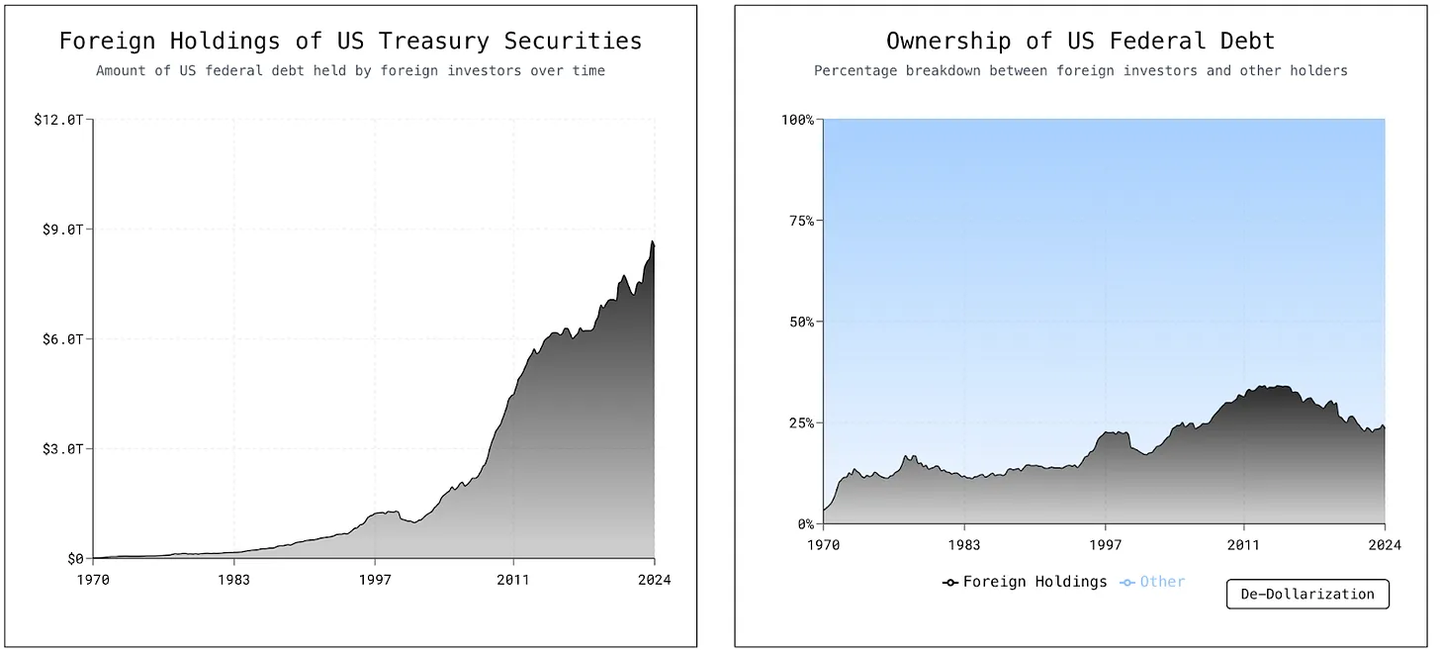
These growing debt pressures unfold against the backdrop of global de-dollarization and declining demand for U.S. debt from traditional buyers such as China and Japan. To understand how U.S. debt enters and circulates within the financial system, consider the following process:
The U.S. Treasury determines the issuance schedule, amounts, and types of securities based on government financing needs, choosing to raise capital through short-term instruments (like Treasury bills and short-term notes) or long-term bonds (like 10-year and 30-year Treasuries).
These securities are issued through Dutch auctions, where all successful bidders receive the same yield. Major market participants include large banks and financial institutions, the Federal Reserve, domestic investment funds (like pension and mutual funds), individual investors (directly or through brokers), and foreign governments and central banks.
After issuance, the Treasury records the official holders, who may be the ultimate investors, brokers, or clearinghouses.
The debt is then traded in the secondary market, similar to stocks, with bond prices fluctuating based on supply and demand. The Treasury regularly (usually semi-annually) pays interest to bondholders.
When existing debt matures, the Treasury typically issues new debt to refinance the principal—this process is commonly referred to as "debt monetization."
Demand for U.S. Treasuries
Since World War II, U.S. government debt has been a cornerstone safe-haven asset in global financial markets, with Treasury bills often referred to as the "risk-free rate." Historically, demand for U.S. debt has been strong, driven by domestic investors and foreign central banks and governments. However, over the past decade, traditional buyers—including the Federal Reserve, major U.S. banks, and foreign sovereign investors—have steadily reduced their purchases. Instead, relative value hedge funds registered in tax-advantaged jurisdictions like the UK, the Cayman Islands, and Luxembourg have become dominant players in the Treasury market. These funds have played a significant role in capping U.S. government debt yields, a trend highlighted in quarterly refinancing announcements for Treasuries, where they are the marginal buyers keeping yields in check. However, this dynamic is increasingly fragile. Rising repo rates and tightening margin requirements are beginning to limit hedge funds' ability to maintain these positions. If these pressures persist, they will pose an increasing risk to the stability of the Treasury market. You can learn more about relative value trading [here](https://stablecoins.asxn.xyz/rv-trade).
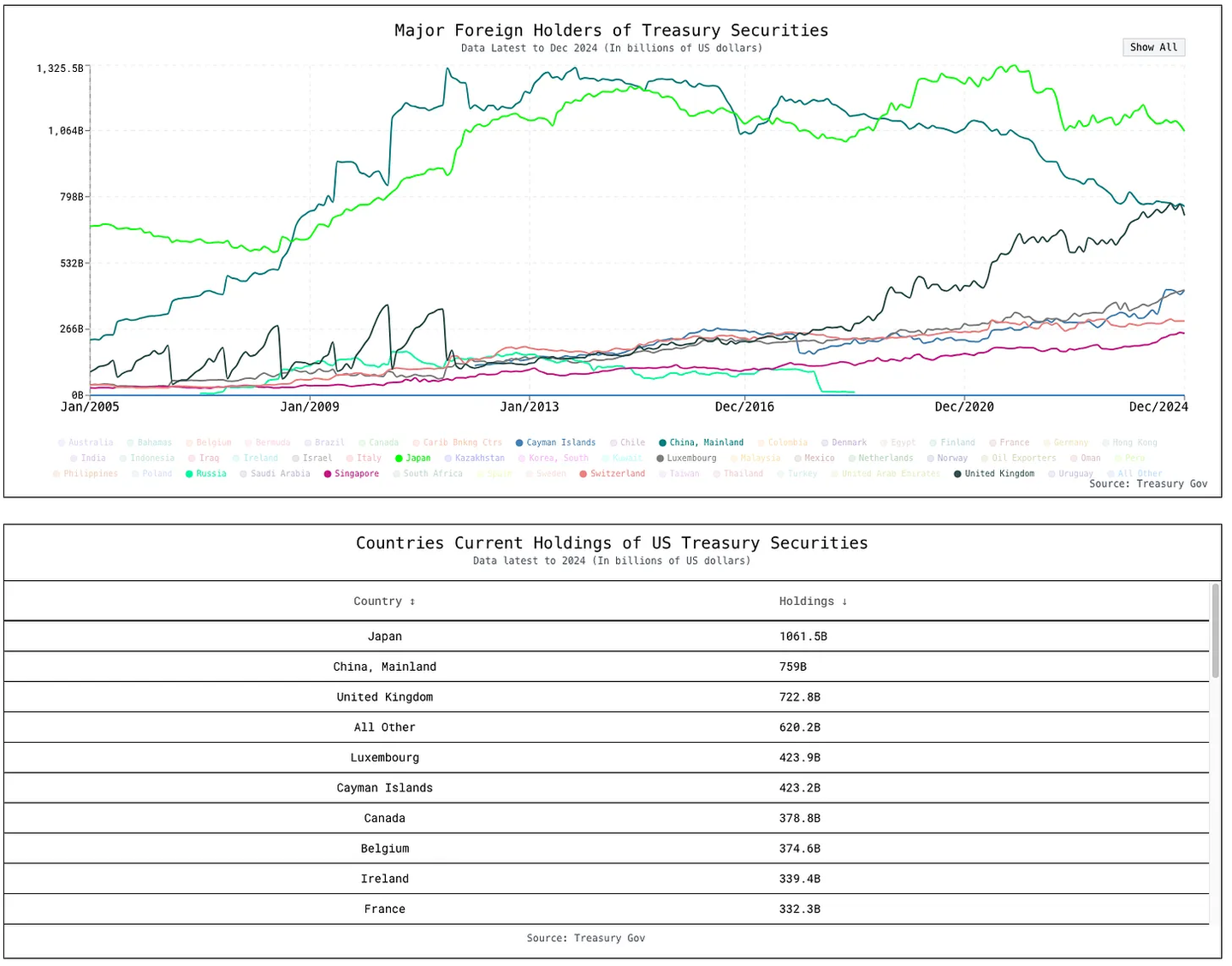
Japan, China, and oil-exporting countries have gradually reduced their holdings of Treasuries, while tax-advantaged countries with hedge funds have increased their holdings.
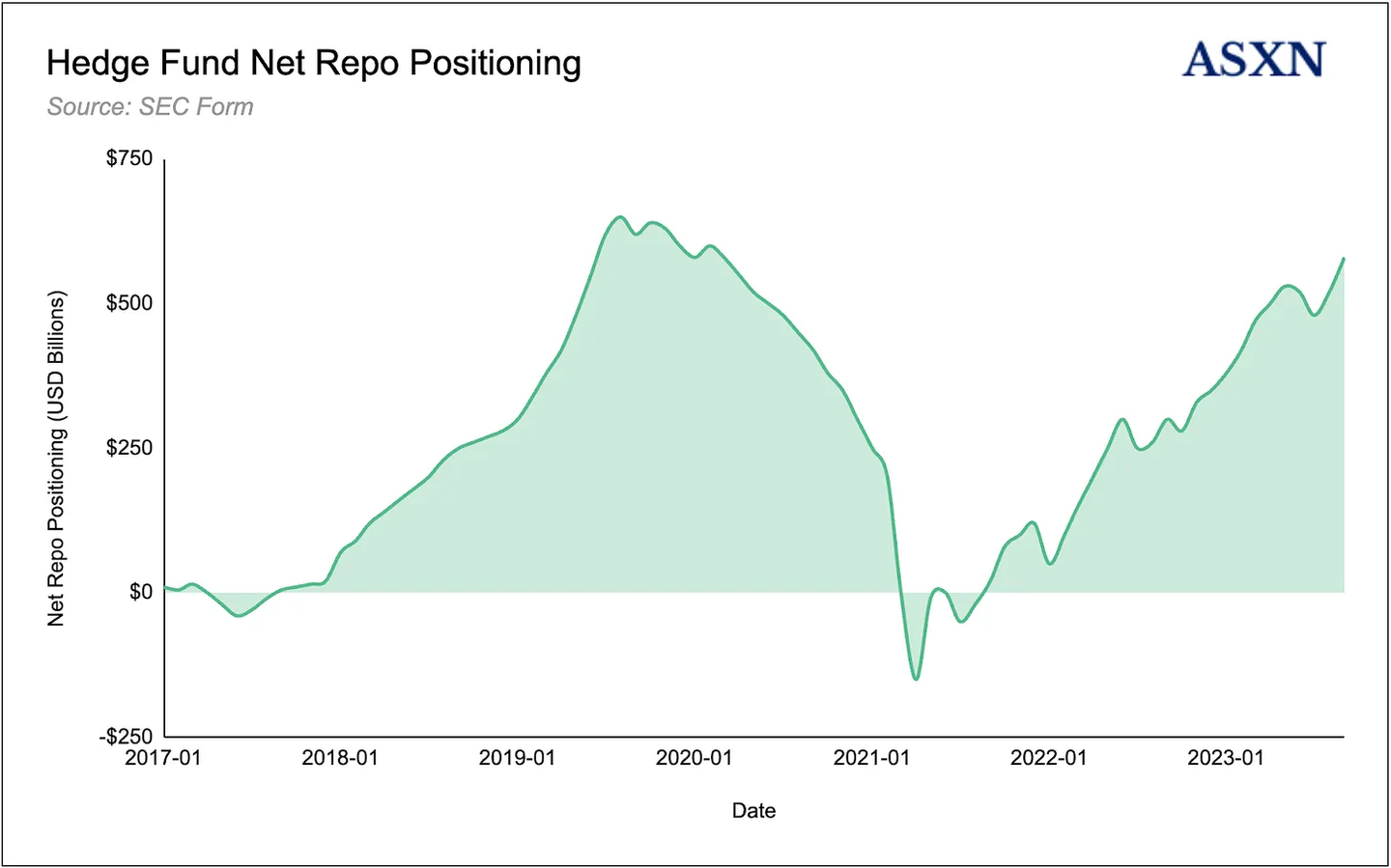
The increase in repo positions reflects the scale of basis trading positions in the market.
Major U.S. commercial banks were once the "natural" buyers of Treasury securities, but this role has been eroded by market value adjustment losses and post-crisis capital rules. Their combined holdings of Treasuries and agency bonds peaked at $4.69 trillion in February 2022, falling to $4.50 trillion by April 2025, as the fastest Federal Reserve rate hike cycle since the early 1980s pushed 10-year yields above 5%, forcing balance sheet contraction. The interest rate shock has left deep scars in capital: the FDIC's latest quarterly bank report shows unrealized losses on securities of $413 billion in Q1 2025, down from a peak of about $680 billion in Q3 2023, but still several times the pre-pandemic level. Compounding the valuation shock, each additional dollar of Treasury securities requires at least 3% Tier 1 capital (5-6% for globally systemically important bank subsidiaries) to support, according to the Basel III supplementary leverage ratio (SLR), making even "risk-free" Treasury bills expensive on balance sheets. Treasury Secretary Scott Bessent has therefore proposed exempting Treasuries (and reserve balances) from the SLR. In March 2025, he stated in a speech to the American Bankers Association: "Banks need capital requirements to buy Treasuries. If we eliminate this requirement… it could lower Treasury yields by 30 to 70 basis points. Each basis point saves $1 billion a year." Academic research from the Boston Fed confirmed the direction of this effect, finding that relaxing the SLR significantly enhances dealer balance sheet capacity and Treasury market liquidity. This policy would fill the widening demand gap—foreign official holders are retreating, and leveraged hedge fund "basis" traders are now setting marginal pricing—but it also increases systemic leverage: a $28 trillion market decline in yields by 50 basis points would reduce federal interest payments by about $140 billion annually, but thinner capital buffers could amplify losses in the next interest rate shock.
Foreign governments and institutions once held about one-third of circulating Treasuries, but Treasury Department data shows that by the end of 2024, their share had fallen to about 30%, the lowest level since before the global financial crisis. This demand traditionally came from surplus economies—oil-exporting countries like Saudi Arabia and (pre-sanction) Russia, as well as manufacturing powerhouses China and Japan—that recycled dollar revenues into U.S. Treasuries and bonds. However, this recycling mechanism is weakening. China is a case in point: despite a record merchandise trade surplus of $992 billion in 2024, its Treasury holdings decreased by about $10 billion to $759 billion, continuing a downward trend from a peak of $1.3 trillion a decade ago. A similar but smaller-scale reduction is evident among Gulf sovereign nations, which are diversifying their oil dollar inflows into sovereign wealth funds in multiple currencies.
The dollar still dominates global reserves, but its advantage is eroding: IMF data shows that in Q4 2024, the dollar accounted for 58% of allocated reserves, with the euro far below 20%. Meanwhile, an increasing amount of energy and commodity trade is being priced in renminbi, euros, or local currencies, with new bilateral clearing systems (such as the China-Saudi oil renminbi pilot and Russia's MIR card network) completely bypassing the dollar. These gradual "de-dollarization" steps have yet to produce a fully alternative reserve currency, but they explain why, even with a persistent global trade surplus, foreign demand for Treasuries is still flattening—making the U.S. increasingly reliant on domestic investors and leveraged hedge fund "basis" trading to finance its ever-expanding debt stock.
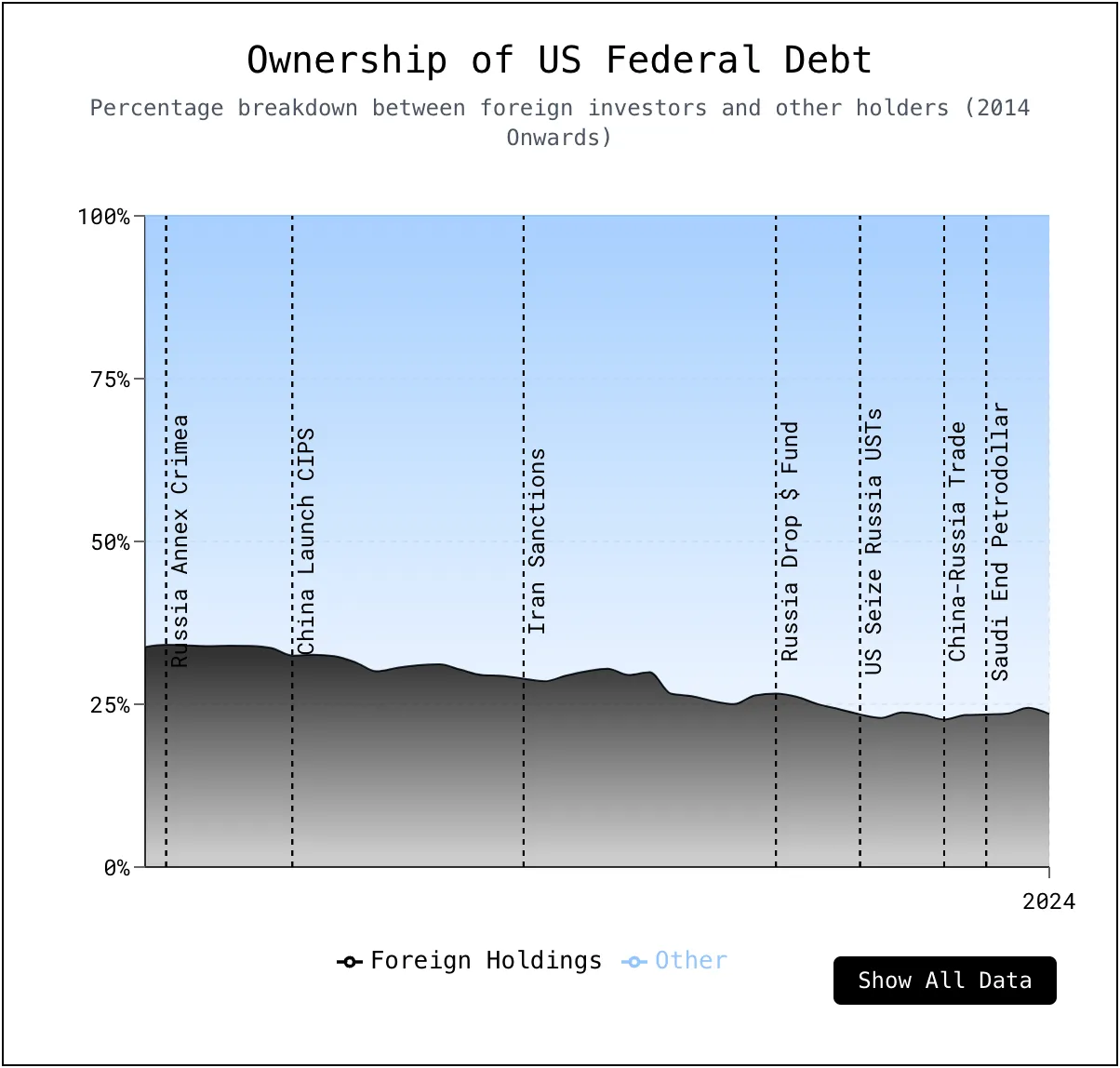
De-dollarization Trends
The trend of de-dollarization actually began in 2014, following the first sanctions against Russia. When we overlay key events of this trend with the proportion of foreign holdings of U.S. debt, a clear pattern emerges: the proportion of foreign holdings relative to total U.S. debt has gradually declined, with several key moments exacerbating this trend, including:
2014 – First Sanctions on Russia: Following the annexation of Crimea, U.S./EU sanctions prompted Moscow—and later Beijing—to reduce Treasury holdings, increase gold reserves, and sign large renminbi swap lines, marking the modern starting point of official de-dollarization efforts.
October 2015 – China Launches CIPS: Beijing's Cross-Border Interbank Payment System went live, providing banks with a renminbi-based clearing and messaging alternative to SWIFT, laying the groundwork for more trade to bypass the dollar.
February 2022 – $300 Billion of Russian Foreign Exchange Reserves Frozen: The West froze about half of Russia's hard currency reserves following its invasion of Ukraine, shocking global central banks, accelerating reserve diversification, and driving greater use of local currency swap lines. This effectively indicated that, regardless of who you are, property rights are not a right but a privilege, and the U.S. Treasury market could be weaponized to punish countries that do not align with U.S. interests.
2023-24 – Energy Trade and BRICS Push: Saudi officials expressed willingness to price oil in renminbi, Brazil established renminbi clearing arrangements for trade with China, and consecutive BRICS summits prioritized cross-border payment platforms to reduce reliance on the dollar.
Tariffs and Trade Imbalances
Since the Bretton Woods Agreement established the dollar as the de facto global reserve currency in 1944, demand for the dollar has remained strong, driven by global trade, financial stability, and central bank reserve accumulation. Today, the dollar still accounts for about 59% of global foreign exchange reserves, with approximately half of international trade conducted in dollars.
This sustained global demand for the dollar has triggered the "Triffin Dilemma" proposed by economist Robert Triffin in the 1960s: the issuer of a reserve currency must provide liquidity to the global system through persistent trade deficits, conflicting with the need to maintain long-term confidence in the currency's value. A strong dollar, while reinforcing its reserve status, makes U.S. exports more expensive and reduces the competitiveness of U.S. companies abroad, leading to a long-term trade deficit, particularly in commodities. Addressing this imbalance—especially the bilateral trade deficit with China—has been a focal point of the Trump economic agenda.
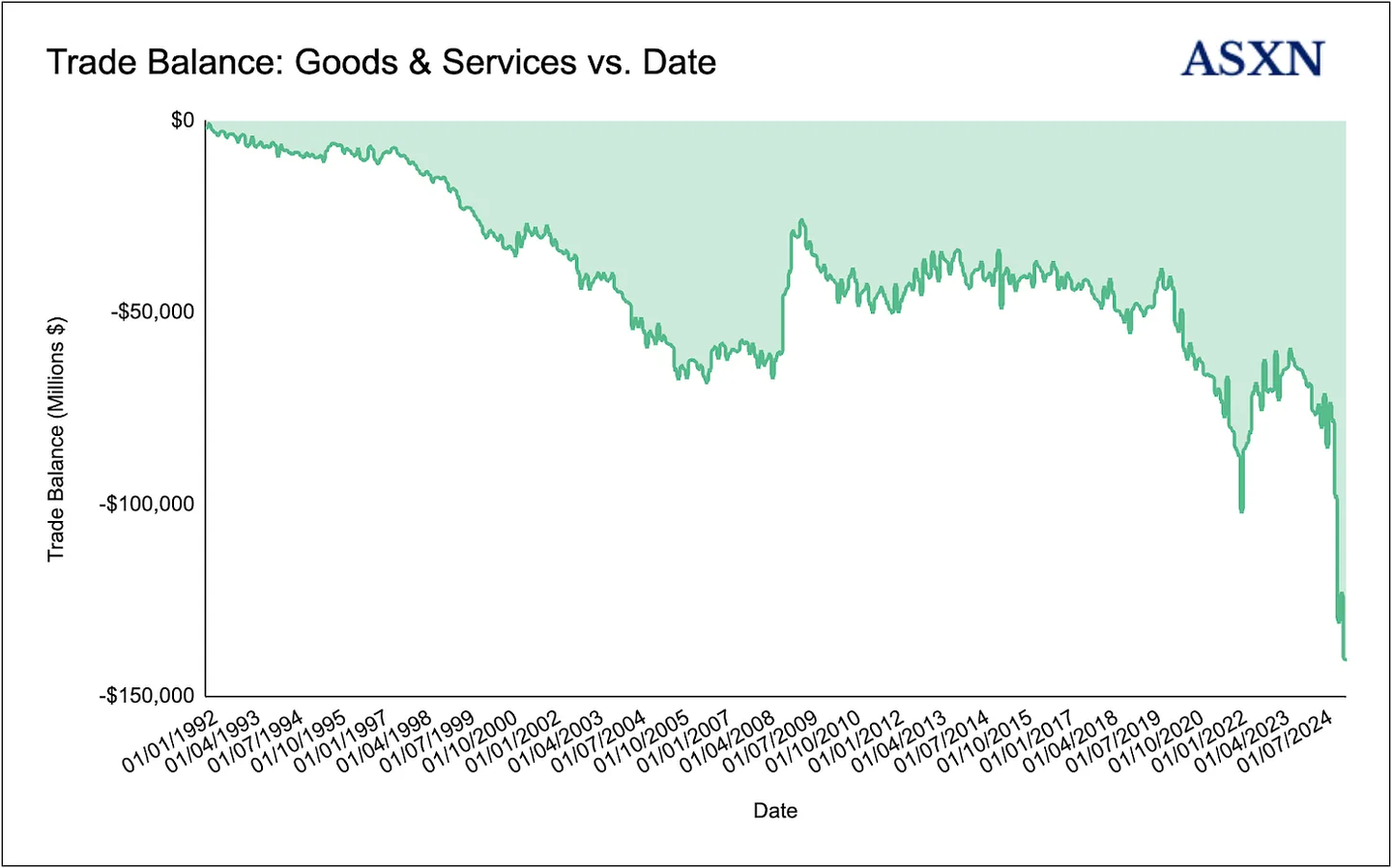
While a strong dollar exacerbates the trade deficit, it simultaneously brings significant benefits to U.S. capital markets. Foreigners accumulating dollar surpluses typically recycle these funds into U.S. assets—most notably Treasuries and stocks—driving demand for U.S. financial instruments. This process is often referred to as the "petrodollar recycling" when driven by oil-exporting countries.
The Trump administration's focus on eliminating trade imbalances inadvertently exacerbated the U.S. debt problem, reducing foreign demand for Treasuries. As trade surpluses shrank, the pool of foreign capital available for recycling into U.S. debt—traditionally viewed as a safe-haven asset—also diminished. The decline in demand pushed yields higher, compounding the burden of national debt.
Stablecoins as Marginal Buyers
U.S. national debt has reached unprecedented absolute levels, with a historic high relative to GDP and an unprecedented scale of peacetime budget deficits. This dynamic is driving the compound growth of the debt burden. Meanwhile, traditional Treasury buyers—such as foreign central banks and reserve managers—have significantly reduced their demand, making relative value (RV) hedge funds the buyers setting marginal prices. However, this mechanism is increasingly fragile. A notable example is during the post-Trump tariff war period, where rumors suggested many RV funds suffered significant losses, leading to rising 10-year yields even as the stock market declined.
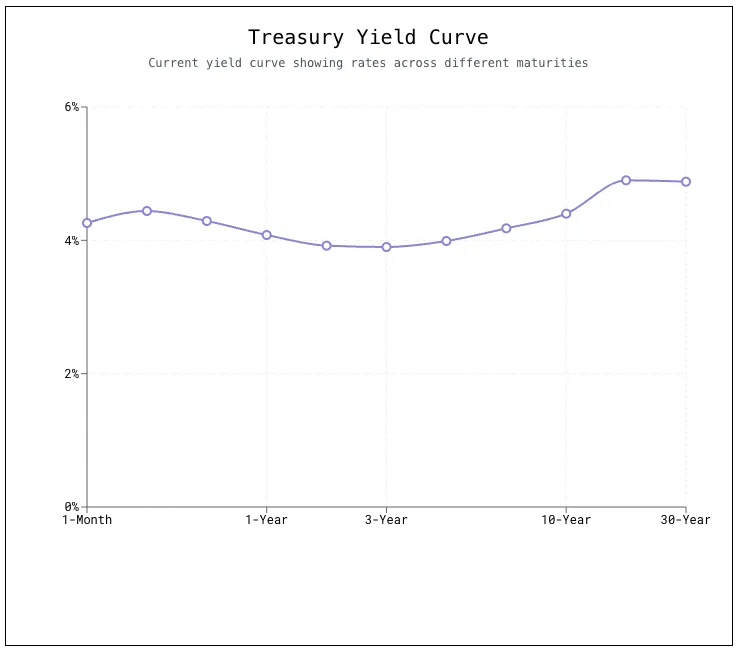
Looking ahead, the U.S. government faces significant challenges in maintaining strong demand for Treasuries to prevent destructive yield increases and unsustainable rises in interest costs. Several policy tools and structural shifts may help. Temporarily exempting large banks from supplementary leverage ratio (SLR) constraints should promote greater Treasury purchases and balance sheet capacity. In parallel, a similar proposal known as the "Mar-a-Lago Accords"—envisioning the issuance of ultra-long (century) bonds to countries under the U.S. security umbrella—could create a new source of strategic demand.
However, the most scalable and organic source of incremental Treasury demand may lie in the global growth of stablecoins. By embedding Treasuries within the reserve assets backing these digital currencies, the adoption of stablecoins could structurally enhance demand for Treasuries, diversify the buyer base, and help stabilize yields in the long term. In fact, when we look at major foreign holders of Treasuries, stablecoins have become the 15th largest holder, with $193.2 billion.
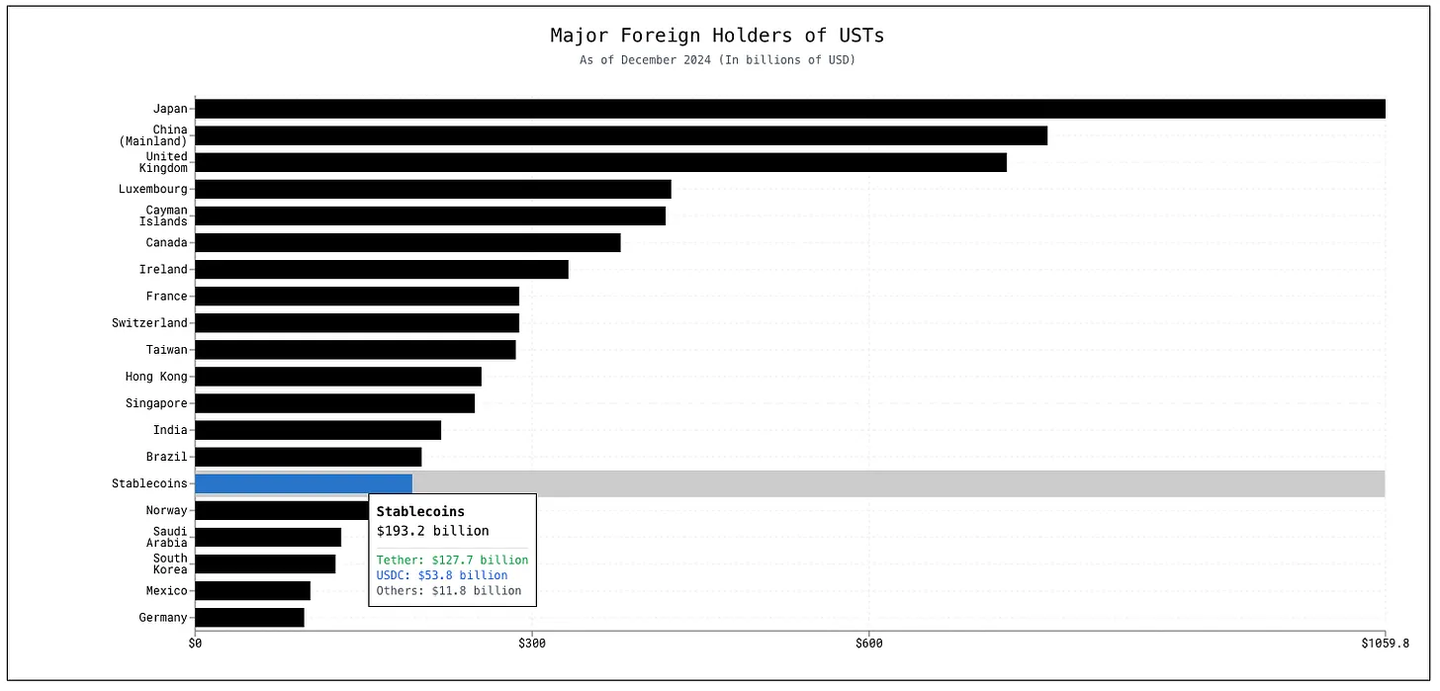
ASXN calculated stablecoin holdings by acquiring the holdings of Tether and USDC and estimating the proportion of Treasuries supported by fiat-backed stablecoin markets.
Over the past year, Washington has recognized the potential of stablecoins in promoting dollar hegemony and has formed a broad bipartisan consensus that dollar-pegged stablecoins require clear federal regulation. Both parties now view the industry as critical to payment competitiveness, consumer protection, and the dollar's dominance, softening traditional political divides. As a result, two companion bills—the House-led "STABLE Act" (H.R. 2392) and the Senate-led "GENIUS Act" (S. 394)—are advancing with strong bipartisan support, indicating that comprehensive U.S. stablecoin regulations are on the horizon. The "STABLE Act" was reported from the House Financial Services Committee in April, requiring that only federally or state-approved issuers may mint dollar-pegged stablecoins; mandating 1:1 full reserves in cash or high-quality liquid assets, with monthly disclosures; prohibiting marketing that implies sovereign backing; and directing the FSOC and Treasury to update technical standards and systemic risk studies. Meanwhile, the "GENIUS Act" passed the Senate procedural vote 66-22, creating a dual chartering system for banks and non-banks (providing optional state options for issuers below $10 billion); directing regulators to set tailored capital, liquidity, and recovery/disposal standards, prioritizing token holders in bankruptcy; clarifying that compliant payment stablecoins are not securities; and authorizing the Treasury and Federal Reserve to recognize equivalent foreign regimes for cross-border issuance.
The Trump administration played a key role in advancing stablecoin regulation, positioning this asset class as a core pillar of Secretary Bessent's strategy to reduce government debt and expand the global influence of the U.S. financial system and the dollar. The following quotes illustrate how the government views the strategic importance of stablecoins:
White House AI and crypto czar David Sacks: "Stablecoins have the potential to ensure the U.S. dollar's dominance internationally, expand the use of the digital dollar as the world's reserve currency, and create potential demand for U.S. Treasuries in the trillions of dollars."
U.S. Secretary of Commerce Howard Lutnick: "Dollar hegemony is crucial for the United States, which is why I support appropriately backed stablecoins. I support Tether and Circle. They drive demand for U.S. Treasuries, which is vital for the U.S. economy."
U.S. Treasury Secretary Scott Bessent: "As President Trump has directed, we will maintain the U.S. as the world's dominant reserve currency, and we will use stablecoins to achieve this goal." Bessent recently stated that stablecoins could provide $2 trillion in demand for Treasuries.
Yield Generation
In addition to serving as a reliable store of value and frictionless payment medium, stablecoins unlock a variety of yield-generating strategies for investors who cannot access traditional markets (including U.S. capital markets) without permission. The yield characteristics of each stablecoin are shaped by its selection mechanism and associated risks. Major sources of stablecoin yield include:
- Government Debt: A portion of the issuer's reserves is invested in short-term U.S. Treasuries, with the interest earned proportionally distributed to token holders. The yield here is driven by the current Treasury bill rates (i.e., market-set, short-term "risk-free" rates influenced by Federal Reserve policy), the chosen maturity (e.g., 4 weeks vs. 13 weeks), and any spread fees retained by the issuer.
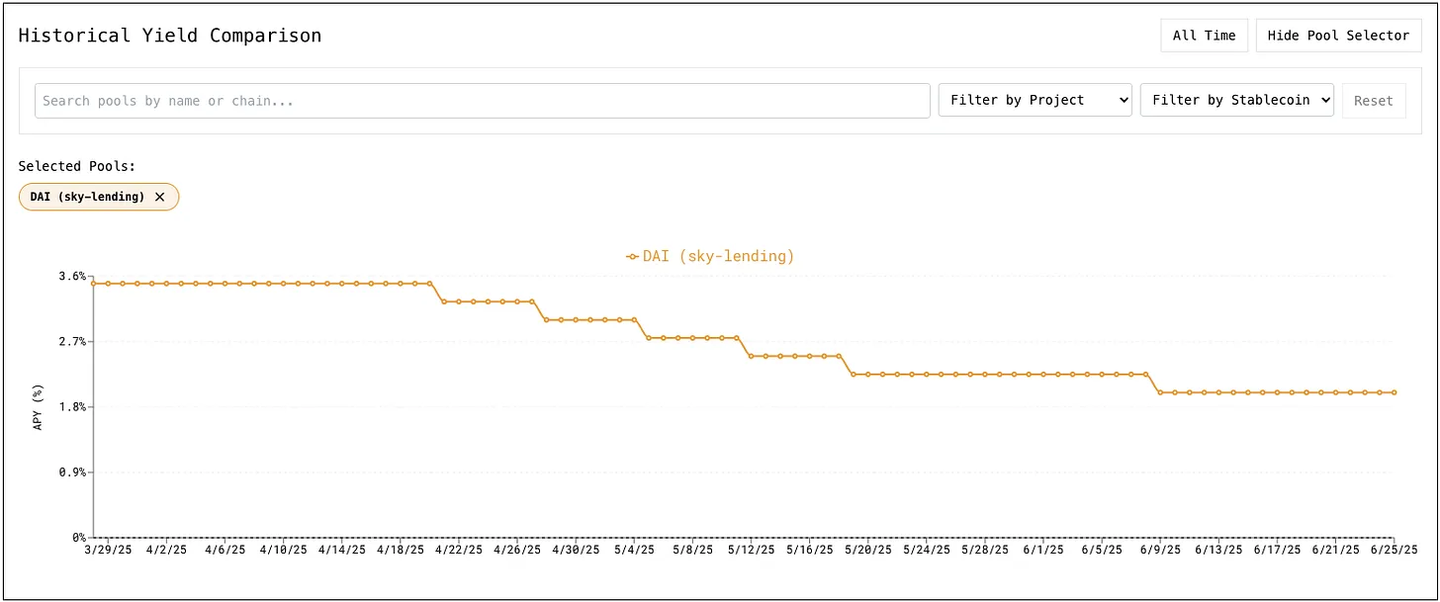
- Liquidity Provision: By providing liquidity to stablecoin pairs in automated market maker (AMM) pools (such as USDC/USDT on Curve or Uniswap), holders can earn a share of transaction fees each time the pool is used. The yield depends on the pool's trading volume, the fee rate per transaction (typically 0.01-0.04%), and the total locked value (TVL) in the pool, which dilutes the fee share for each LP. Since both assets are targeted to be pegged 1:1, as long as neither decouples, impermanent loss is minimal.
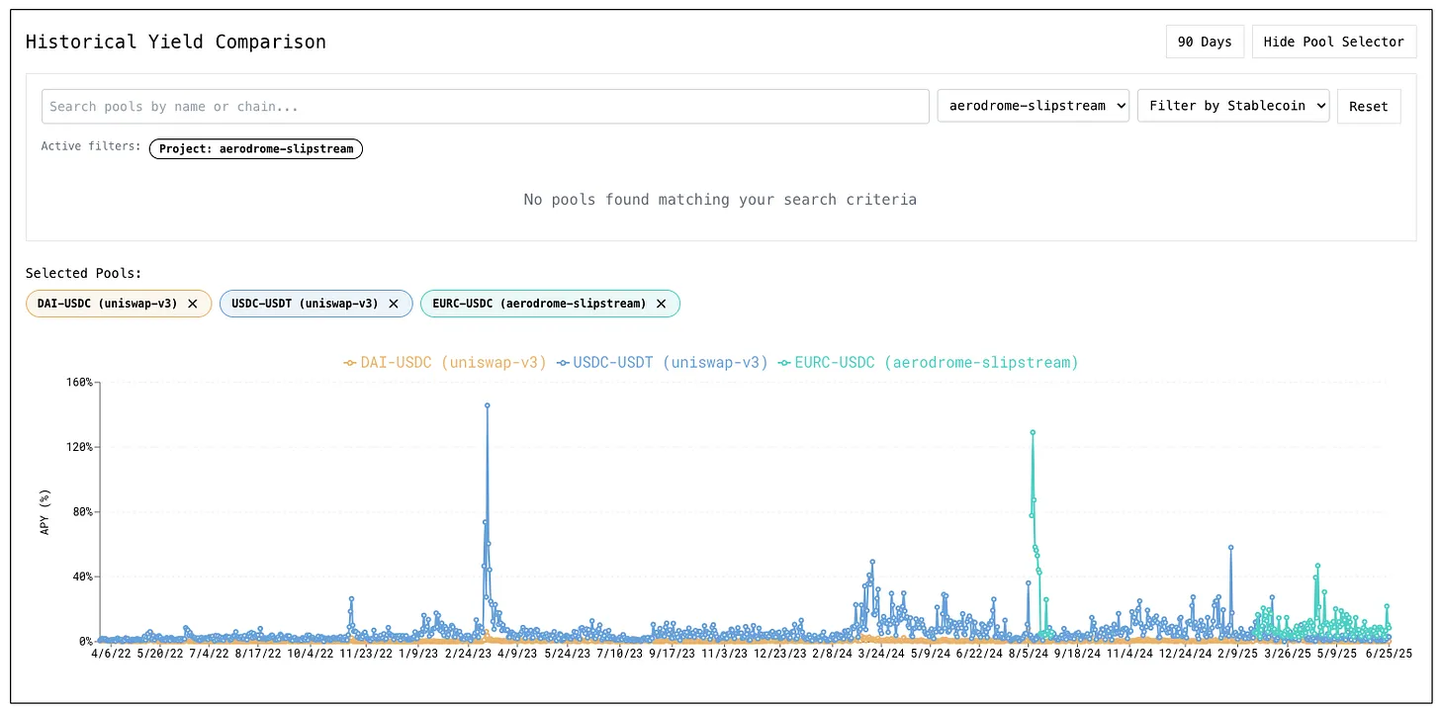
- Lending Markets: Platforms like Aave or Kamino allow stablecoin holders to lend directly to borrowers in exchange for a base annual percentage yield (APY). The interest earned here depends on the protocol's utilization rate (the ratio of borrowed to supplied assets), the dynamic interest rate curve parameters set by protocol governance, and any additional governance token incentives (e.g., reward emissions).

- Strategy-Supported Stablecoins: Stablecoins are actively deployed into yield-generating investments. For example, Ethena's USDe and Neutrl's nUSD capture financing rate returns by shorting positions in perpetual futures, while other fiat or crypto-collateralized tokens can be deposited into yield farming vaults. For instance, Hyperliquid's HLP accepts USDC deposits and automatically allocates funds to market making, financing rate arbitrage, and liquidation services, currently yielding an annualized return of 8%. You can view detailed risk metrics on the ASXN HLP risk dashboard.
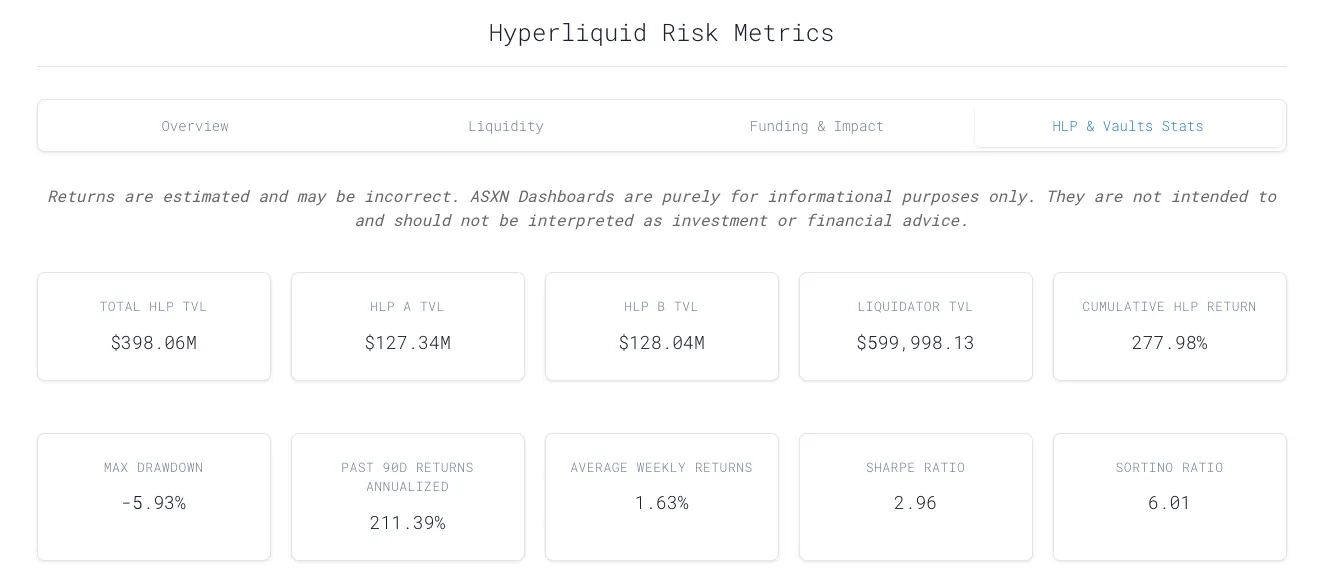
- Private Credit: Stablecoins can be directly deployed into on-chain private credit markets by lending to a single known borrower under transparent, borrower-defined terms (annual yield, term, reserve ratio, minimum deposit) and receiving tradable debt tokens that accumulate fixed interest. For example, on Wildcat Finance, a company might raise $2 million USDC at a 15% annual yield over 8 months, with a 10% collateral buffer; a lender depositing $100,000 USDC mints a debt token and receives about $110,000 USDC at maturity (reflecting the 15% annual yield), while on-chain reserves and optional off-chain legal agreements help mitigate default risk.
There are many yield opportunities with stablecoins, benefiting from the permissionless, global nature of internet capital markets and crypto rails. Each avenue has its trade-offs—credit and duration risks of government debt, smart contract and decoupling risks of AMMs, protocol and utilization risks in lending markets, and unique risks in more speculative yield opportunities. Investors should choose the most suitable yield source based on their risk tolerance and return objectives.
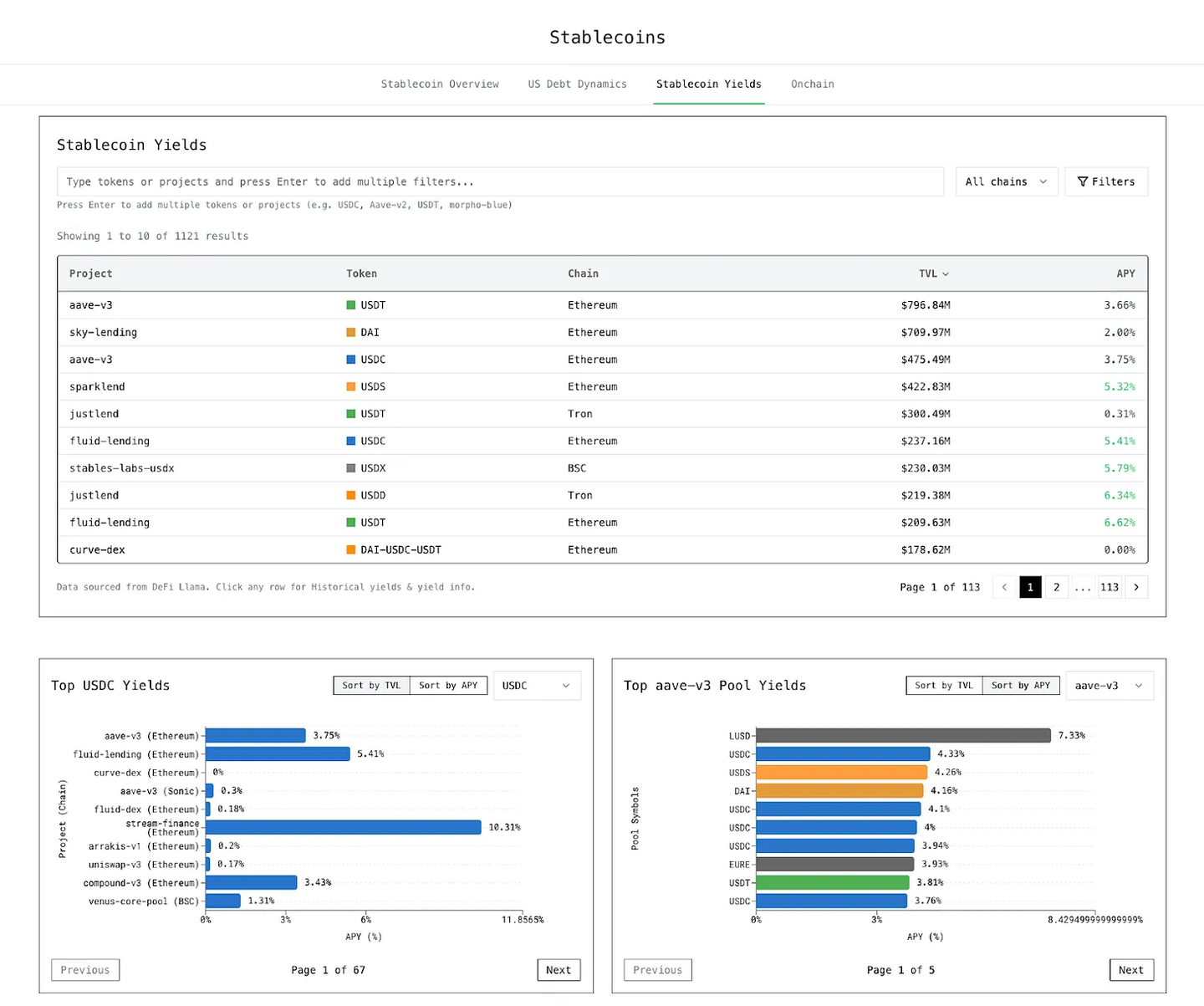
Crypto Trading
As mentioned in our overview of stablecoins, these tokens initially gained traction as crypto-native collateral and settlement rails, optimizing capital efficiency for market makers and arbitrageurs. Today, trading firms and liquidity providers hold large stablecoin balances on their balance sheets, while DeFi protocols embed stablecoins in collateral vaults, lending pools, and AMM trading pairs. Centralized exchanges are also shifting their perpetual futures from BTC or crypto-collateralized margin trading to stablecoin-based contracts—primarily USDT pairs (with USDC rapidly growing)—which now dominate trading volume and liquidity depth. In over-the-counter (OTC) trading desks, OTC desks often settle large trades in stablecoins, with dollar-denominated tokens becoming the preferred accounting unit for market-neutral and crypto credit/yield funds.
Total Addressable Market (TAM) for Stablecoins
Stablecoins serve multiple functions based on user demand. For individuals in authoritarian or high-inflation regimes, they provide self-custodied value storage and wealth protection. For others, they offer a fast, low-cost way to send remittances to family and friends across borders. For businesses, stablecoins act as financial "superconductors," enabling instant, round-the-clock cross-border settlements at a fraction of the cost of traditional payment systems, directly enhancing efficiency and profit margins. For governments—especially the U.S. government—stablecoins serve as a powerful tool for shadow monetary policy, extending financial influence and the global power of the dollar while creating new sources of demand for U.S. sovereign debt. Therefore, stablecoins touch multiple markets and sectors, and estimating their total addressable market (TAM) or market cap growth requires numerous assumptions. We can examine each sector and its potential penetration levels for stablecoins, particularly dollar-pegged stablecoins:
Offshore Dollars

The total amount of dollars held offshore is estimated at $23.5 trillion, distributed across the following major areas:
Physical dollar cash: Physical bills held overseas, primarily in emerging markets for savings, payments, and crisis hedging.
Official foreign exchange reserves: Dollar assets held by foreign central banks (mainly Treasuries, deposits, and dollar-denominated securities).
Eurodollars: Offshore dollar deposits, loans, bonds, and interbank financing—the core of the international dollar banking system.
Offshore dollar private sector securities: Dollar bonds and euro bonds held by non-U.S. private investors and institutions.
Remittances
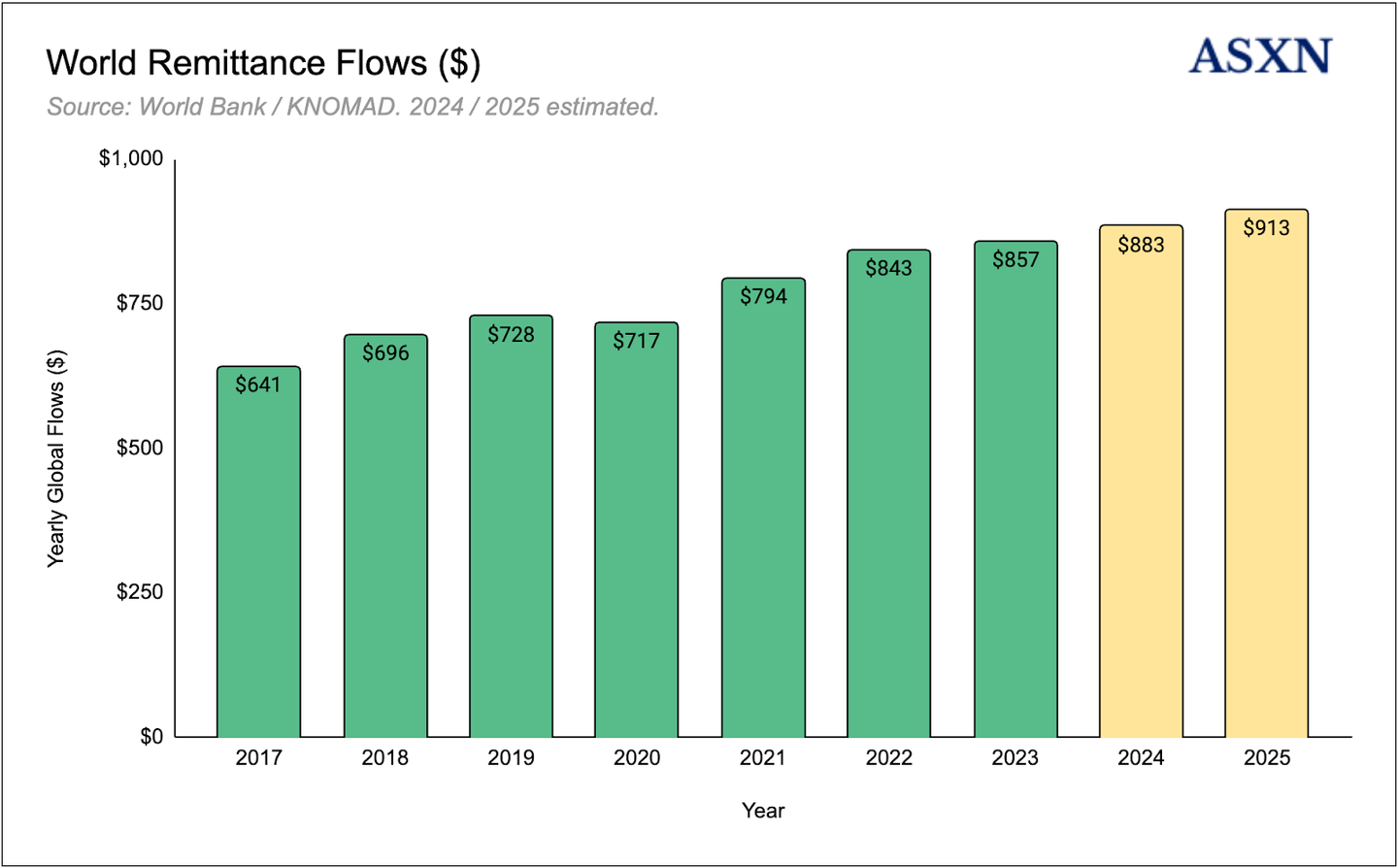
While annual remittance flows are estimated to be between $833 billion and $1 trillion, most of this is in local currencies. Dollar-denominated remittance flows are about $600-700 billion/year, with the U.S. being the largest remittance corridor to Mexico, India, the Philippines, Pakistan, and Saudi Arabia to India. To model the market cap growth of stablecoins, we need to make some assumptions about the velocity of remittance flows. We can refer to studies on remittance velocity:
Traditional money transfer operator (MTO) behavior (recipients cashing out within weeks): World Bank and IMF data show that most remittance funds are cashed out within 1-4 weeks of arrival, deriving a velocity of about 12-26 times per year.
Stablecoin-based remittance applications: Reports from Deloitte, the IMF, and BIS indicate that transferred funds typically hold dollars/stablecoins "for weeks to months" without immediate cashing out. ECB data shows that an increasing number of stablecoins are held for 1-12 months.
Dollarized economies (such as Lebanon, Argentina): Market and anecdotal reports suggest that users hold dollars for months, especially when local currencies are unstable—supporting a low velocity of 2-3 times per year.
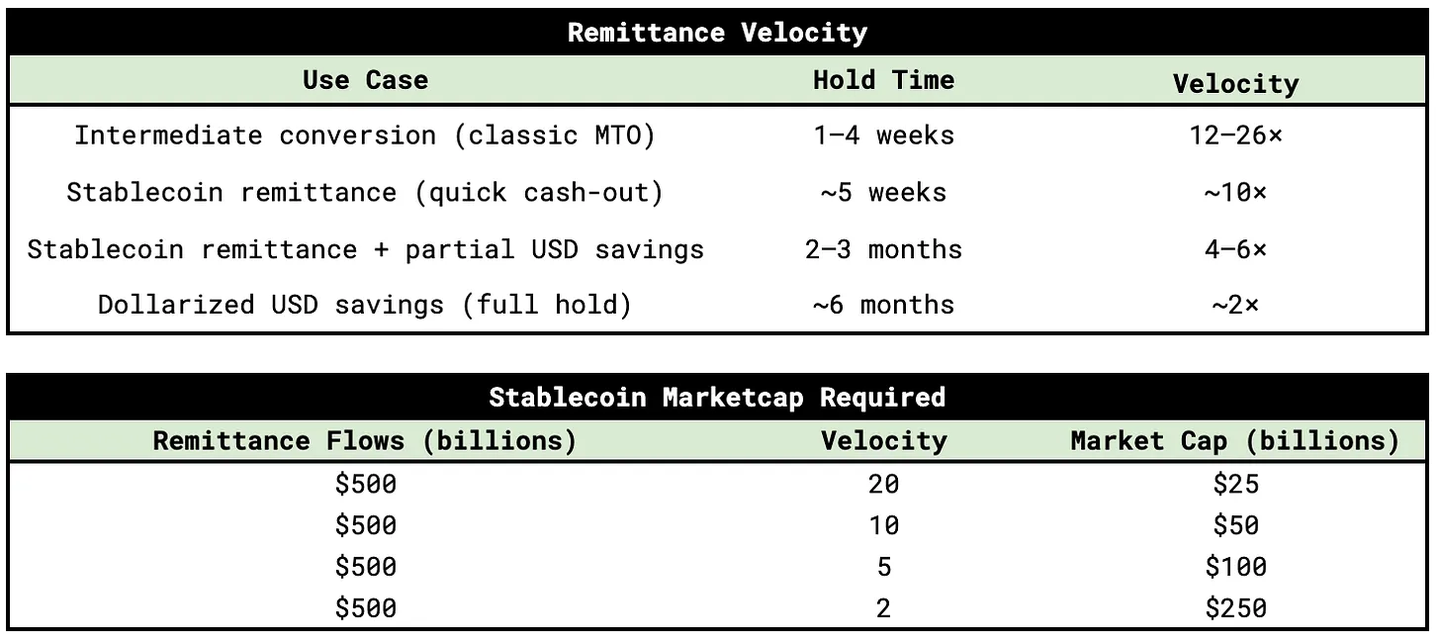
Considering the velocity of different types of remittances, we can estimate the market cap of stablecoins supporting these annual flows. For example, $500 billion in stablecoin-based remittances with an annual velocity of 10 times would require a market cap of $50 billion to support this activity.
Payments
The payments sector is vast—ranging from $4 coffee card swipes to trillion-dollar wholesale wire transfers—operating through various rails. Industry statistics (such as BIS CPMI "Red Book," McKinsey's 2024 Global Payments Report) indicate that approximately 34 trillion transactions were cleared in 2023, moving about $18 trillion in value.
These headline figures mix distinctly different pipelines and transaction sizes, making it impossible to illustrate the money stock or turnover velocity behind each rail. Operator disclosures show that the nine largest dollar payment rails processed about $29 trillion in total throughput in 2024. The McKinsey report for 2023 is $18 trillion, as it only counts each transaction once, removing duplicate hops (e.g., a single $100 million export payment appearing sequentially in SWIFT→CHIPS→Fedwire). Therefore, the aggregated operator disclosure data is higher.
Dividing the flow of each rail by the actual liquidity "float" (e.g., commercial bank deposits for ACH/Zelle/RTP, revolving card balances for card networks, Federal Reserve balances for Fedwire, interbank claims for CHIPS and SWIFT), and then weighting by flow share, yields a comprehensive turnover velocity of about 150 times per year—meaning an average reuse of one dollar every 2.4 days. Fedwire acts as a major accelerator at about 340 times; excluding it or assuming a larger working balance would sharply decrease the overall velocity.
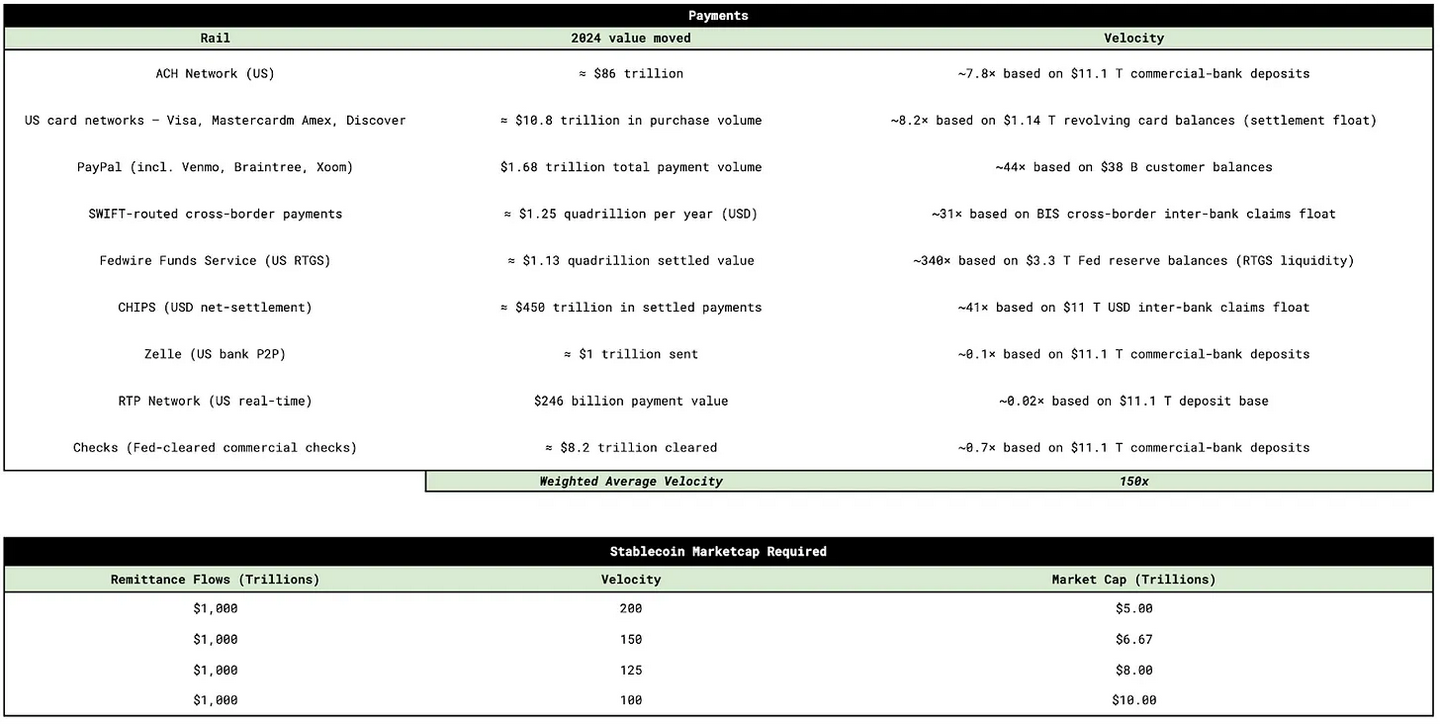
Applying this velocity of 150 times to stablecoins means that settling an annual transaction volume of $10 trillion would require about $6-7 trillion in float ($10 trillion / 150 ≈ $6.7 trillion). If the turnover rate of stablecoins in the real world is lower—such as 10-30 times for retail or remittance flows—the required float scales up proportionally, to about $33-100 trillion. In short, the velocity assumptions drive the market cap calculations for stablecoins, with high-frequency wholesale rails like Fedwire significantly boosting the overall velocity.
Money Market Funds
Money market funds (MMFs) are another area where stablecoins could potentially disrupt, as previously mentioned. Fiat-backed stablecoins operate similarly to MMFs, typically earning yields on their underlying assets—though this yield is often retained by the issuer. However, a new trend is emerging: yield-distributing stablecoins. For example, Circle and Coinbase now offer a 4.5% yield to USDC holders through the Coinbase platform, while Ondo Finance and Sky's USDSTokenized Treasuries allow stablecoins to gain exposure to real assets (primarily short-term Treasuries).
With increased regulatory clarity, we expect large traditional financial institutions to enter this market, issuing their own stablecoins and ultimately returning yields to users through optional vaults or other mechanisms. Although the current GENIUS Act explicitly prohibits yield distribution for payment stablecoins—Section 2 prohibits issuers from offering interest or yields to maintain their cash-equivalent status and avoid regulatory arbitrage—we believe this restriction may evolve over time. Alternatively, we anticipate growth in products specifically designed for tokenized MMFs, where users can deposit stablecoins to earn yields within a regulated wrapper—as demonstrated by BlackRock's BUIDL.
In fact, the U.S. Treasury sees this potential in its stablecoin report, specifically mentioning the benefits of tokenizing U.S. Treasuries:
Key Potential Benefits of Tokenizing U.S. Treasuries
Improved Clearing and Settlement: Tokenized Treasuries allow for more streamlined "atomic settlement," where all parts of a transaction involving Treasuries settle simultaneously among all relevant parties, reducing the risk of settlement failure.
Enhanced Collateral Management: Smart contracts directly programmed into tokenized Treasuries enable more efficient collateral management, including automatic transfers of collateral upon meeting preset conditions.
Increased Transparency and Accountability: An immutable ledger can provide greater transparency for Treasury market operations, reducing opacity and offering real-time insights into trading activity for regulators, issuers, and investors.
Composability and Innovation: The ability to bundle different tokenized assets may spur the creation of new, highly customizable financial products and services based on U.S. Treasury securities—such as derivatives and structured products.
Increased Inclusivity and Demand?: Tokenization could make Treasuries more accessible to a broader range of investors, including small retail participants (through fractionalization) and emerging market investors.
Increased Liquidity?: Tokenization could unlock new investment and trading strategies through seamless integration and programmable logic; tokenized Treasuries could trade around the clock on blockchain networks, although the net impact may be bidirectional.
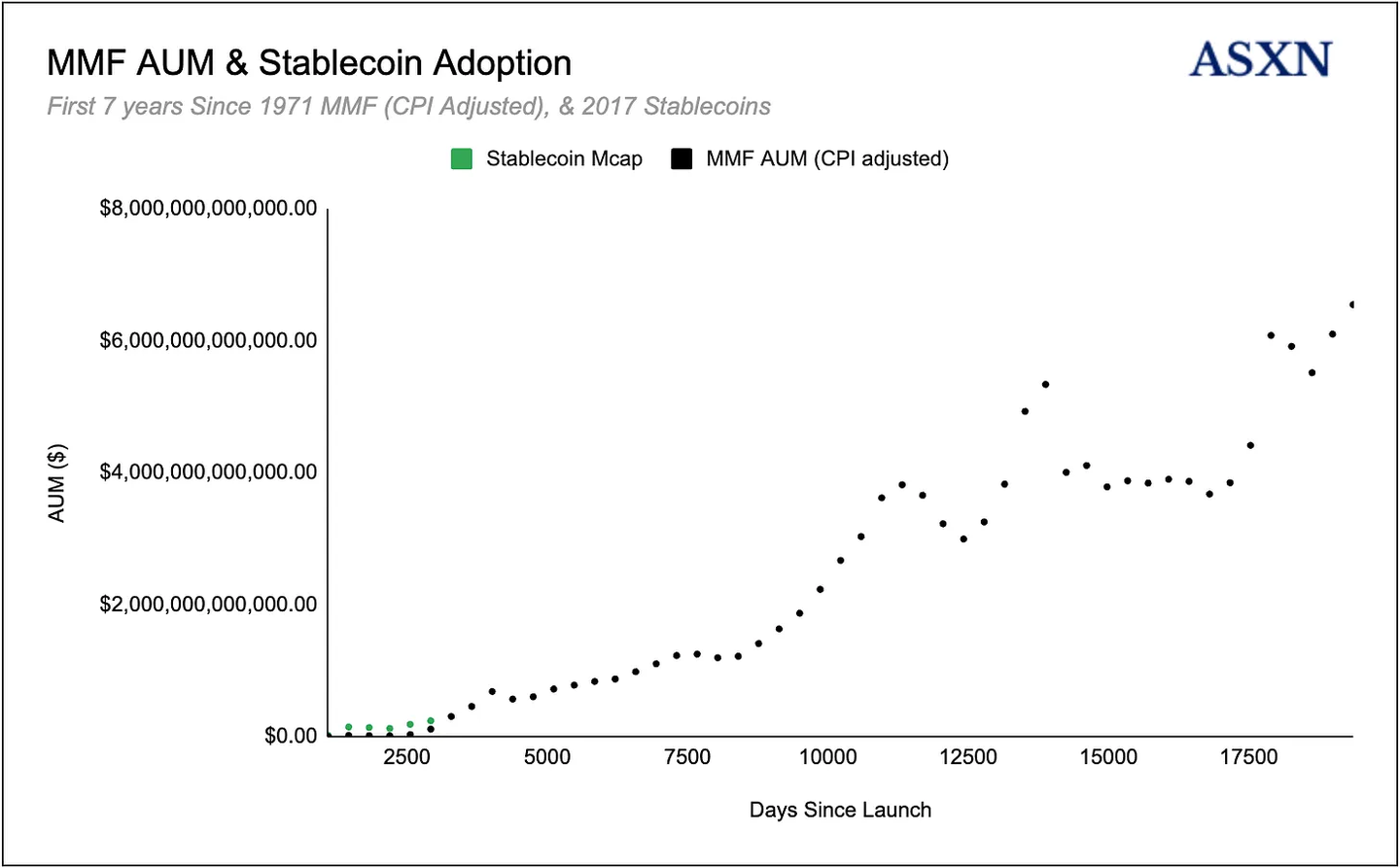
It is easy to see how the convenience of deployment, global accessibility, instant liquidity, and transferability of tokenized Treasuries could drive significant demand for stablecoins—potentially capturing a substantial share of the marginal flows currently going into money market funds. In fact, the U.S. Treasury cites a report from Bank of America estimating that stablecoins could generate up to $8 trillion in additional demand for U.S. Treasuries.
Stablecoin Market Cap Model
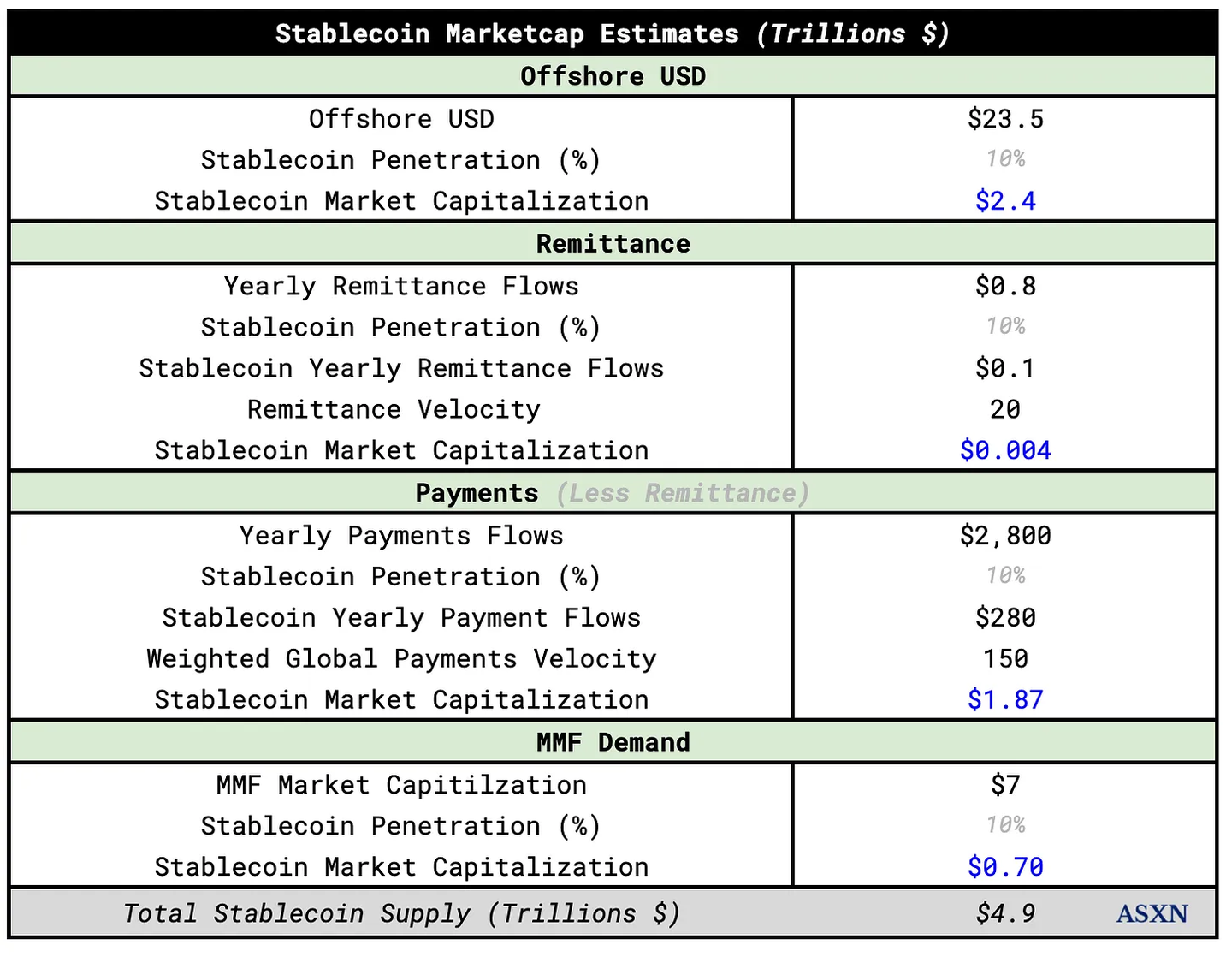
By aggregating the same use case and adopting reasonable assumptions for adoption levels in each sector (here at 10%), we can begin to estimate the potential scale of stablecoin supply as adoption grows. Focusing on offshore dollar demand, remittances, payments, and MMF alternatives, our analysis suggests that stablecoin supply could grow to approximately $4.9 trillion at moderate penetration levels.
This market cap would grow linearly with increasing market penetration rates in each sector, excluding more speculative stablecoin use cases, such as AI-native payments.
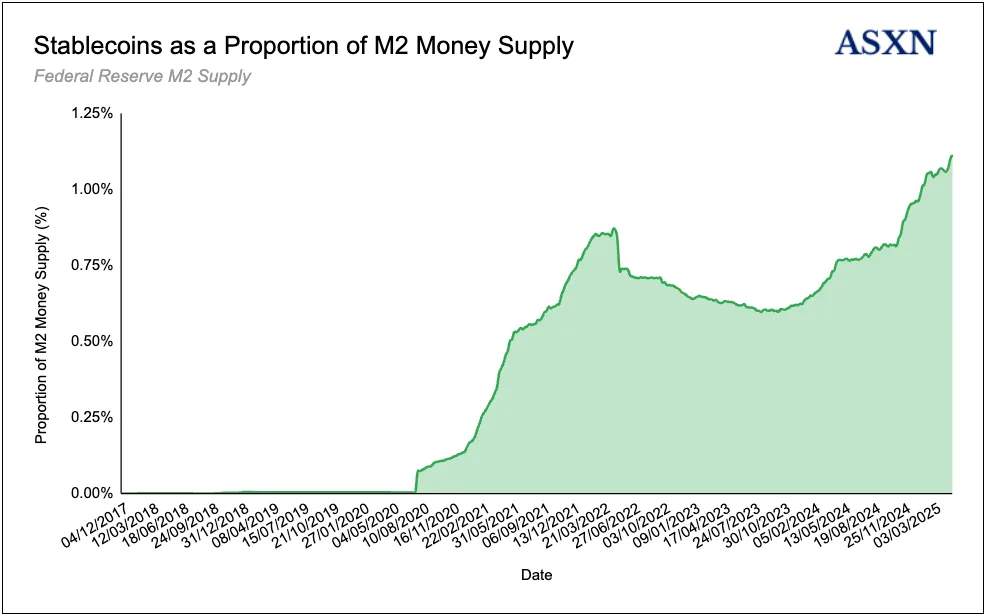
M2—the broadest measure of the U.S. money supply—includes M1 (currency in circulation and checking deposits) as well as "near-money" instruments like savings deposits, small time deposits (under $100,000), and retail money market funds. Currently, M2 is approximately $21.86 trillion, with stablecoins accounting for over 1.1% of it. With clearer regulatory guidance, stronger infrastructure, and a continued shift toward fully digital payments, we believe the share of stablecoins in M2 could grow tenfold over the next decade.

According to Artemis's methodology, excluding transfers within trading platforms and MEV-driven activities (such as flash loans), the average monthly transfer volume of stablecoins over the past 12 months was $1.85 trillion, annualized to about $22.2 trillion. In contrast, a 10% share of the global remittance and payments market corresponds to about $280.1 trillion in annual flow; based on current transaction volumes, stablecoin-based payments account for only 7.9% of that opportunity.
Current Landscape
Total Locked Value (TVL) of Stablecoins

As mentioned in the introduction, the vast majority of the total locked value of stablecoins comes from fiat-backed stablecoins, namely Tether and USDC, which account for 81% of the total stablecoin supply.
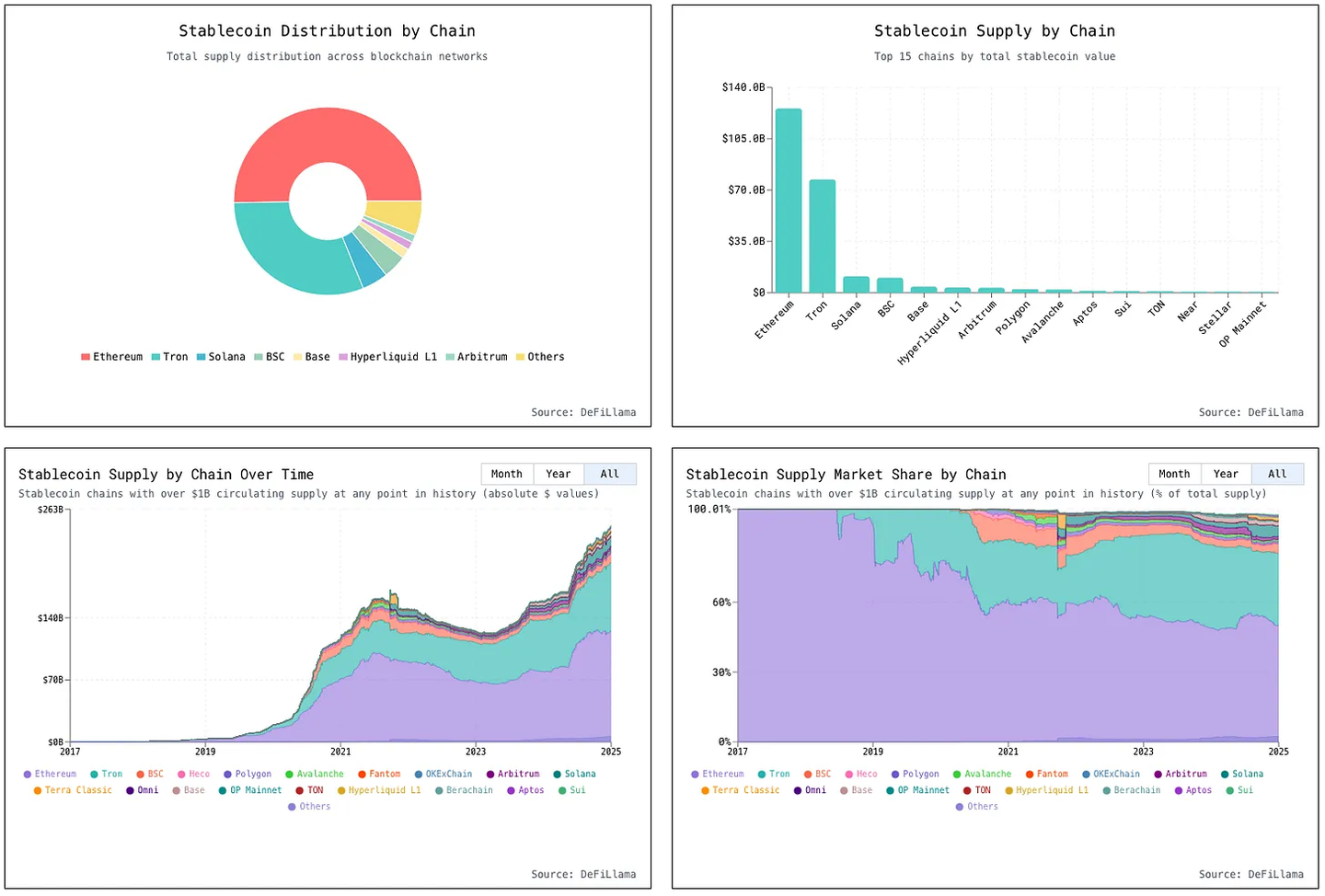
Over the past year, the stablecoin market has rapidly grown, with a market cap increase of $90 billion, a year-on-year growth of 56%. Tether continues to dominate the market, holding a 62% share of the total stablecoin market cap. However, new entrants are gaining traction: Ethena, in particular, has launched the fastest-growing stablecoin to date, reaching a market cap of $3 billion in record time.
Meanwhile, market dynamics are shifting among more mature participants. Over the past year, USDC has begun to reclaim market share from Tether as confidence in Circle gradually recovers following the disruptions caused by the SVB crisis. At the same time, algorithmic stablecoins have essentially disappeared from the market following the collapse of Luna and increased regulatory scrutiny.
Chain Distribution
In terms of the distribution of stablecoin supply by chain, supply is highly concentrated on two blockchains: Ethereum (50.2%) and Tron (30.94%). This reflects Ethereum's mature network trust and deep on-chain market, as well as Tron’s early distribution efforts and low transaction fees.
At the same time, Solana (4.5%) and Hyperliquid (1.4%) have rapidly gained share due to increased on-chain activity—particularly in trading and Hyperliquid being used as collateral for perpetual futures.
Since 2020, Ethereum's market share of stablecoin supply has gradually declined, attributed to Tron’s remarkable growth and the rise of alternative L1 and L2 solutions in 2020-2021. The next evolution of this trend may see stablecoins migrate to dedicated stablecoin chains, such as Plasma, Stable, 1Money, and Codex.
Currency Distribution
In terms of currency distribution of stablecoins, dollar-pegged stablecoins absolutely dominate with a 99.78% share of stablecoin market cap. The second largest is the euro, with only $361 million in market cap. Unlike foreign exchange reserves, the vast majority of stablecoins are dollar-denominated, providing a significant opportunity for the U.S. to promote dollar hegemony through upcoming regulations.
Stablecoin Ecosystem
The following section provides a high-level overview of the stablecoin ecosystem, showcasing selected projects and case studies from each category. We have published a stablecoin market map, which can be viewed here.
If you would like to add your stablecoin project to the market map, you can do so by filling out this form.
Blockchain
The current generation of blockchains has proven to be a reliable foundation for value transfer and stablecoin issuance, but we are now witnessing a shift toward application-specific blockchain spaces optimized for single high-value use cases. Hyperliquid's success as a trading-optimized L1 is a prime example. Beyond trading, we believe stablecoins represent the next clear product-market fit. Currently, the vast majority of stablecoins reside on Ethereum and Tron, but neither of these chains is designed for stablecoins: Ethereum has high fees, and Tron combines high fees with extreme centralization. This presents an opportunity to build an underlying chain specifically designed for stablecoins—embedding tailored functionalities and performance characteristics to unlock their full potential and overcome the limitations of existing platforms.
Several teams are working on this:
Plasma
Plasma is a high-performance, scalable, and secure L1 blockchain designed for hosting stablecoins and supporting applications that depend on them. Its core utilizes PlasmaBFT—a custom consensus protocol inspired by Fast HotStuff—providing fast finality and low-latency transaction throughput. Its execution layer is built on Reth (a modular, Rust-based Ethereum-compatible engine), introducing target performance optimizations while maintaining full EVM compatibility. To enhance security and interoperability, Plasma integrates a native, trust-minimized Bitcoin bridge that periodically anchors state differences to the Bitcoin network. In terms of stablecoins, Plasma offers several purpose-built features:
Custom Gas Token: Transaction fees can be settled using leading assets like USDT or BTC through an automatic swap mechanism, without the need to hold the native token.
Zero-Fee USDT Transfers: Simple USDT transactions incur no fees, balancing network load and user experience through adaptive priority.
Privacy Transactions: In the future, the network will hide transaction amounts and participants, preserving privacy without sacrificing auditability or compliance.
Plasma recently held a pre-issuance deposit vault for participants in its XPLToken ICO, quickly securing $1 billion in stablecoin deposits. You can view our stablecoin model: [Plasma Model].
And our Dune analysis dashboard showing vault details.
Stable
Details about the Stable chain are currently limited, and we expect these to be released when the external testnet goes live. What we know is that Stable is a new L1 blockchain where:
- USDT is the native gas token.
- Free peer-to-peer USDT transfers.
- USDT0 supports seamless cross-chain USDT transfers.
- Smart contracts run on stablecoins.
- Applications can provide a gas-free user experience.
- Native integration of fiat currency entry.
- Guaranteed throughput through enterprise channels.
1Money
The 1Money network is an L1 blockchain built for stablecoin payments and real-world assets (RWA). Co-founder and CEO Brian Shroder explained, "1Money will make stablecoin payments more accessible and practical for everyday use cases, from paying friends to e-commerce purchases and sending remittances." At its core, 1Money utilizes the Byzantine Consistent Broadcast (BCB) protocol, designed to mitigate network latency, reduce surge pricing fees, and prevent priority gas attacks. Each transaction is processed immediately with equal priority—no reordering or preferential execution. Transactions are expected to be confirmed in less than a second and paid directly in the stablecoin used at a fixed low fee. Additionally, the chain is designed to incorporate compliance, KYC/AML, and sanctions screening.
Codex
Codex is an API-first blockchain designed for B2B stablecoin trading, built on Optimism, combining an EVM environment with a smooth and predictable fee model that remains stable regardless of network congestion. This design ensures fast, reliable, and cost-effective stablecoin movement, enabling businesses to automate and scale on-chain financial workflows without worrying about surging gas fees or unpredictable delays.
In addition to core chain functionalities, Codex offers a suite of programmable services: RESTful APIs for cross-border stablecoin transfers and a self-sufficient forex liquidity venue providing real-time forex execution without relying on intermediaries. Integrated withdrawal partners—from crypto exchanges to local fiat brokers—allow organizations to exchange stablecoins for local currency on demand. Codex incorporates selective privacy features while leveraging the transparency of public ledgers, allowing users to mask sensitive transaction details when necessary.
Converge
Ethena is building Converge, a new chain focused on introducing tokenized real-world assets (RWA) and connecting them with DeFi and cryptocurrencies (hence the name Converge). Tokenization is still an emerging field but has the potential for exponential growth. Currently, many chains (including permissioned and permissionless ones) are competing to attract tokenization to their networks, some offering KYC, AML, and full control stacks (Avalanche subnets, L2s, and other institutional chains), while others provide composability, thriving DeFi, and proximity to cryptocurrency issuance and activities (Solana, Ethereum, etc.). As discussed later in the report, Converge aims to provide control and composability for institutions looking to tokenize assets.
Converge is envisioned as a high-throughput, low-latency chain compatible with EVM. The chain will launch with a block time of 100 milliseconds, aiming to reduce it to 50 milliseconds by Q4 2025. The chain's goal is to achieve at least 100 million gas units per second, with a capacity to process approximately 1 billion gas units per second. For comparison, Ethereum processes about 15 million gas per block (around 100 million gas per minute).
Architecture
Converge is built on the Arbitrum Orbit stack, using Celestia as the data availability layer. It employs an optimized Arbitrum-based sequencer (Conduit G2) for transaction execution and ordering. Converge runs the Arbitrum Nitro stack (providing fraud-proof security and EVM compatibility) but uses sequencers and configurations tailored for high throughput.
For data availability, Converge will initially publish data to Celestia, allowing for high-capacity, low-cost data block publishing. Celestia's architecture supports super-sized data blocks (its recent testnet demonstrated 128MB data blocks and approximately 21MB/s throughput, with a roadmap goal of 1GB blocks). Through Celestia, Converge can parallel publish large amounts of transaction data, unaffected by Ethereum's current data throughput limitations.
Transaction ordering on Converge is handled by the Conduit G2 sequencer, a high-performance sequencer implementation from Arbitrum responsible for collecting transactions, executing them, and proposing blocks at a rapid pace. The target block interval is about 100 milliseconds, generating an average of 10 new blocks per second (sometimes referred to as mini-blocks or flash blocks). Converge plans to further reduce block time by introducing a continuous mini-block flow and improved RPC processing, aiming for block times below 50 milliseconds by Q4 2025.
Converge Validator Network (CVN) and Security
A key component of Converge is the Converge Validator Network (CVN), a dedicated validator layer. The CVN is a permissioned set of validators that acts as a "security council" with discretionary power. The validator set can intervene in emergencies (pausing the chain, rolling back in the event of significant hacks or errors, etc.). Unlike typical validator sets that only handle block production or ordering, the CVN's role is to provide security safeguards for the network's economic integrity and user funds.
For example, the CVN can restrict or block malicious cross-chain messages bridged to prevent bridge-based attacks. It can also trigger protocol-level circuit breakers (pausing specific contracts or the entire chain) if oracle manipulation, critical smart contract errors, or other economic anomalies that could lead to fund loss occur. In extreme cases, the CVN even has the authority to dispute the finality of the chain or coordinate network pauses/forks to protect users. These powers are designed as a last resort, providing a safety net for institutional users (who often require risk mitigation) without fundamentally compromising the chain's decentralization or activity.
Execution
Converge implements a multi-threaded execution pipeline that can process transactions in parallel where possible, leveraging multi-core CPUs. Unlike traditional single-threaded EVMs, this design concurrently executes independent transactions while maintaining strict determinism of results.
The sequencer does not produce a single block at longer intervals but continuously emits small "flash blocks" (micro-blocks) as transactions come in. Validator nodes can incrementally execute and validate these mini-blocks without waiting for a complete block. This reduces propagation latency in the network, maintaining high responsiveness even under heavy load. Essentially, block production becomes more continuous, smoothing transaction bursts and reducing the time new transactions take to reach validators.
To handle the rapid state growth brought on by high TPS, Converge uses a path-based flat state storage model supported by a high-performance database. This improves the efficiency of reading and writing contract states. The storage engine supports concurrent read and write operations, meaning multiple parts of the state tree can be accessed/updated in parallel without conflict. It also includes online state pruning capabilities, discarding old states when necessary. These features are crucial for driving a chain that currently achieves 10x throughput, preventing the state database from becoming a performance bottleneck or growing unmanageably.
Converge itself is a permissionless foundational layer: anyone can bridge assets, and any developer can freely deploy smart contracts. However, it supports an ecosystem where some applications may enforce their own permissions at the application layer, particularly those dealing with regulated assets. Converge is expected to host two parallel types of applications: (1) fully permissionless protocols and (2) regulated or permissioned applications for traditional financial use cases. Importantly, both can interact. Permissioned RWA platforms can benefit from the combination of on-chain liquidity and DeFi primitives (e.g., bond tokens can serve as collateral for DeFi borrowing pools), as long as these interactions comply with the required regulatory rules. The design of Converge does not enforce global permissions; access control decisions are made by application developers or asset issuers at the smart contract layer.
You can read our complete Ethena report here: [Ethena Report].
Issuers
Stablecoin issuers are the entities that mint and redeem tokens—whether fiat-backed, crypto-backed, strategy-backed, or algorithmically backed—detailed in the stablecoin category section at the beginning of the report.
Cap Money
Cap is a stablecoin protocol that provides transparent, code-verifiable financial guarantees through two types of tokens:
- cUSD: A dollar-pegged token on Ethereum, fully backed 1:1 by blue-chip stablecoins (USDC, USDT, pyUSD, BUIDL, BENJI). By pooling compliant reserves into a fund, cUSD acts as an on-chain neutral bridge—supporting rapid, secure, 24/7 exchanges of any underlying asset at par, without preference.
- stcUSD: A yield-bearing token minted by staking cUSD. Autonomous operator pools self-select based on the protocol's threshold interest rates to generate yields, while smart contracts ensure complete downside protection for users.
Cap operates as a three-party market, driven by economic incentives. It outsources the yield generation of stcUSD to a diversified network of institutional operators—banks, high-frequency trading firms, and market makers—whose "shared security network" ensures sustained, competitive yields under any market conditions.
Recently, Cap announced PayPal USD as the first partner in its stablecoin network (CSN), establishing an open, interoperable institutional settlement layer—supporting 1:1 collateral exchanges, transparent on-chain guarantees of active yields, and foundational yields on idle reserves.
M^0
M^0 is an immutable decentralized coordination layer compatible with EVM, allowing permissioned participants to generate and manage $M stablecoins. The protocol will launch on the Ethereum mainnet on May 7, 2024, as infrastructure for building dedicated stablecoins backed by U.S. Treasuries held in special purpose vehicles.
The core protocol mechanism revolves around three types of permissioned participants approved through a governance process. Minters act as authorized entities that can mint and burn $M tokens through collateral deposits, operating within a strict collateral ratio of 100% to 650%. Validators, as independent entities, provide cryptographic proof of off-chain collateral value using EIP-712 structured data signatures, with collateral updated every 30 hours. Yielders are approved addresses that earn yields on their $M balances through an automatic rebalancing mechanism.
The protocol implements a dual balance accounting system within the $MToken itself. The non-yield balance remains static as a standard ERC20-style token balance, while the yield balance automatically increases through continuous compounding. This architecture allows the same token to serve both traditional DeFi applications that require static balances and yield-generating applications that need dynamic balances.
M^0 generates income through the interest rate differential between collateral returns and distributed yields. Minters pay interest on outstanding $MToken based on a dynamic interest rate model, while approved yielders receive allocated yields through a rebalancing mechanism. Excess yields flow into the DistributionVault, distributed to ZEROToken holders.
Wallet Infrastructure
Wallets are the primary entry point for end users to interact with the blockchain, allowing them to self-custody and trade stablecoins at will. Wallets range from "hot" wallets (accessible via mobile apps or browser extensions) to "cold" solutions (such as Ledger hardware devices). Since managing private keys is fundamentally different from using bank accounts, the wallet user experience (UX) is crucial for attracting non-technical users: the fear of funds being hacked or losing keys remains a major barrier. Fortunately, an increasing number of providers are bridging this gap with familiar Web2-style logins and biometric passkeys (such as Face ID), enabling users to securely self-custody stablecoins without the steep learning curve of traditional key management.
Privy
Privy (recently acquired by Stripe) provides APIs for building crypto rails. Users can create white-label, hardware-secure wallets (registered via email, SMS, social logins, passkeys, or existing crypto wallets). The platform uses SOC 2-compliant, trusted execution environment (TEE)-based hosting, employing distributed key sharding and optional hardware token support for security. Programmable policies allow for KYC/AML checks or daily transfer limits to be enforced on stablecoin redemptions, while built-in gas abstraction and meta-transaction support enable fees to be paid in stablecoins. All operations run in a hardware-isolated TEE, supporting wallet group management, automating on-chain operations, and accessing real-time webhooks and SDKs with enterprise-level reliability and millisecond performance.
Deposit and Withdrawal Channels
Robust deposit and withdrawal infrastructure is crucial for achieving real-world liquidity and utility for stablecoins. Deposit channels seamlessly convert fiat currency into blockchain-native stablecoins, empowering users and businesses to access digital markets and DeFi applications. Conversely, withdrawal channels exchange stablecoins back into local fiat currency, maintaining liquidity, ensuring compliance, and allowing value to flow smoothly between traditional and decentralized finance. A diverse ecosystem of centralized exchanges, mobile wallets, and region-specific gateways is actively building these bridges.
MoonPay
MoonPay operates as a gateway between fiat currency and digital assets, providing users access to cryptocurrencies. MoonPay supports major payment methods, including debit and credit cards as well as Google Pay, serving over 30 million accounts in more than 180 countries. The platform has processed over $9 billion in transaction volume for more than 500 businesses.
Coinbase
In addition to more specialized deposit and withdrawal services, centralized exchanges are the backbone of fiat-to-stablecoin flow, handling the majority of transaction volume. On platforms like BN, Coinbase, and Kraken, users can buy and sell stablecoins using various payment methods (including cards, bank transfers, and digital wallets) and withdraw fiat currency back to their bank accounts. By 2024, stablecoins accounted for over two-thirds of cryptocurrency transaction volume, with USDT alone making up nearly 80% of stablecoin transaction volume.
Trading platforms also serve as powerful distribution channels: Tether solidified its lead through early integration with BN, while USDC has expanded to a supply of $60 billion—transaction volume even exceeding USDT in August 2024—partly due to a revenue-sharing agreement with Coinbase, granting Coinbase 50% of USDC reserve yields, making USDC the native stablecoin for Coinbase and its Base L2 network.
Cards
Crypto cards (typically issued as Visa or Mastercard debit cards) allow users to spend cryptocurrencies (Bitcoin, Ethereum, or stablecoins) at places that accept cards by automatically converting cryptocurrencies to fiat currency at the point of sale. They exist in both physical and virtual forms, often linked to mobile apps for real-time balance management, and may offer benefits such as cashback rewards for cryptocurrency payments.
Gnosis Pay
Gnosis Pay is a self-custody crypto payment platform and API that allows businesses to issue Visa debit cards based on stablecoins, supported by Monerium's regulated euro electronic currency token EURe, enabling users to spend digital euros anywhere Visa is accepted while retaining full on-chain custody in a hardware-secure Safe smart contract wallet. It bridges traditional rails (SEPA IBAN, Visa settlement) with on-chain settlement, enabling instant, low-cost stablecoin payments, equipped with built-in KYC/AML processes and programmable compliance policies that meet SOC 2 and TEE security standards.
Bybit Card
The Bybit Card is a Mastercard-branded debit card that converts crypto holdings, including Bitcoin, Ethereum, and major stablecoins, into fiat currency usable at over 90 million merchants worldwide. By directly linking to users' Bybit funding accounts, it provides a withdrawal channel while allowing ATM withdrawals. The Bybit Card offers up to 10% cashback on purchases and 100% discounts on subscriptions for services like OpenAI, Netflix, and Amazon Prime.
B2B
Acctual
Founded in 2023, Acctual is a digital asset accounting platform that integrates into ERP workflows in minutes, allowing teams to issue and manage invoices in fiat currency and stablecoins (USDC, USDT) across 129 countries. It supports crypto-to-crypto, fiat-to-crypto, and crypto-to-fiat transactions—clients processed over $25 million in USDC as of October 2024—and synchronizes with QuickBooks and Xero for real-time ledger updates. Acctual also provides built-in fraud protection and multi-level approval workflows to streamline digital currency accounting.
Stripe
As one of the largest traditional payment providers, Stripe has solidified its role in the stablecoin infrastructure space through strategic initiatives and by leveraging crypto rails to enhance payment services. In October 2024, Stripe acquired the API-based stablecoin orchestration platform Bridge for $1.1 billion, completing the transaction in February 2025, enabling it to control the end-to-end process of minting, custody, conversion, and settlement of dollar-pegged tokens through a single API. In June 2025, Stripe deepened its crypto toolkit by acquiring hardware-isolated wallet provider Privy, accelerating Stripe's ability to embed secure, TEE-based wallets and transaction signing into any application.
Based on these capabilities, Stripe launched a private preview of stablecoin financial accounts, enabling businesses in over 100 countries to hold, send, and receive funds via ACH/wire (USD), SEPA (EUR), and USDC on major blockchains, equipped with Bridge custody and soon to support Bridge's closed-loop USDB token. Through Bridge and Stripe Issuing, developers can now issue Visa debit cards priced in USDC—initially launching in Latin America and expanding to Europe, Africa, and Asia—where stablecoins convert to local fiat currency at the point of sale. Through Stripe Connect, platforms like Shopify can instantly enable USDC payments for their users—by June 2025, Shopify merchants in 34 countries began accepting USDC on Base—while offering options to pay in local currency or directly in USDC. Bridge's USDB stablecoin—1:1 backed by cash and short-term money market funds—provides developers and end users with closed-loop, yield-sharing settlement options, supporting low-cost on-chain transfers.
Peer-to-Peer (P2P)
Peer-to-peer stablecoin payment applications allow users to send and receive dollar-pegged tokens instantly and at low cost—without banks, wire fees, or waiting days. By leveraging on-chain rails, these applications eliminate foreign exchange friction and settlement delays, making global peer-to-peer transfers as simple as sending a message over the internet.
PayPal
Since 2020, PayPal's wallet has supported the buying, selling, holding, and use of cryptocurrencies—including Bitcoin, Ethereum, and the fully reserved, 1:1 dollar-backed stablecoin PayPal USD (PYUSD), issued in partnership with Paxos Trust Company since August 2023. PYUSD exists on Ethereum and Solana, can be sent on-chain to external wallets, and moves freely between PayPal and Venmo accounts. To drive adoption, PayPal partnered with Coinbase—waiving PYUSD transaction fees and enabling direct dollar redemptions—and integrated PYUSD into merchant and cross-border processes through Fiserv, all accessible via its developer API.
Sling Money
Sling Money is a Solana-based peer-to-peer payment application that supports instant, fee-free transfers of USDP (Pax Dollar) and EURC (Euro Coin). It provides virtual dollar (ACH) and euro (SEPA) accounts, with received funds automatically converted to on-chain stablecoins through Bridge's orchestration API, allowing users to hold, send, or withdraw stablecoins globally. Under the regulation of the U.S. FinCEN and the Dutch AFM, Sling supports self-custody through any Solana wallet and offers free transfers in over 145 countries.
Business Orchestrators
Stablecoin orchestrators are an infrastructure layer for developers that abstracts and automates the entire lifecycle of stablecoin transactions through a single unified API—minting, custody, conversion, cross-chain transfers, compliance checks, fee management, and settlement. Businesses do not need to build and maintain their own on-chain integrations, regulatory workflows, and fiat-crypto rails; they simply call the orchestration API to:
- Move and accept stablecoins globally at internet speed, with built-in gas management and on-chain security.
- Store and custody balances under professional, compliant custodial arrangements.
- Automatically convert and settle between stablecoins and fiat rails (ACH, SEPA, card networks).
- Enforce KYC/AML, programmable transfer limits, and other compliance policies without custom code.
Bridge
Bridge's orchestration API allows users to mint, custody, convert, and settle USDC, USDB, or any dollar-equivalent token. Bridge handles regulatory and compliance requirements, on-chain gas management, and cross-chain transfers. In addition to simple transfers, Bridge's issuance API enables users to launch stablecoins in minutes, with reserves invested in U.S. Treasuries, and yields returned to applications. Bridge's currency transfer service supports instant, low-cost cross-border payments and bank-style accounts in dollars and euros, serving global consumers and businesses.
Currently, Bridge supports various use cases, such as the repatriation of Argentine pesos from Starlink sales, Nigerian consumers paying for YouTube Premium with stablecoins, and U.S. small and medium-sized enterprises accepting cryptocurrencies globally.
Lending
Stablecoins—cryptographic assets pegged to fiat currencies (like the U.S. dollar)—have become the backbone of DeFi lending due to their price stability and deep liquidity. In established money markets like Aave, depositing USDC or DAI mints interest-bearing aUSDC or aDAI tokens, which automatically rebalance to reflect earned yields, while borrowers can choose between variable or "stable" rate loans based on collateral. Syrup Finance (initially a licensed, under-collateralized credit layer for Maple) transformed into a permissionless stablecoin yield protocol in early 2024: users now deposit USDC into the SyrupUSDC pool on Maple, minting SyrupUSDC tokens and accumulating interest from over-collateralized institutional loans, with SYRUP tokens providing governance rights and revenue-sharing incentives.
In addition to these open, variable-rate services, a growing area of DeFi focuses on borrower-led fixed-term credit markets. Wildcat Finance is an Ethereum-based platform that allows approved borrowers to launch customized stablecoin credit markets by defining interest rates, reserve ratios, lock-up periods, and withdrawal cycles. Each market operates as a direct credit line between borrowers and lenders—supporting under-collateralized or even zero-reserve lending against USDC, DAI, or USDT—while Wildcat only verifies borrower eligibility and deploys market controllers, not assuming credit risk. Lenders deposit stablecoins into these custom markets, receiving tradable debt tokens that accumulate returns at the annualized yield specified by the borrower. Markets can be configured for fixed terms (typically 30-90 days) or rolling terms, allowing borrowers to adjust flexibly based on their cash flow needs. Wildcat's on-chain transparency ensures lenders can monitor borrower solvency and market health in real-time, while smart contracts enforce default protection mechanisms, such as automatic liquidation when collateral value falls below predetermined thresholds.
Centrifuge
Centrifuge is another platform focused on on-chain credit, particularly for loans backed by real-world assets (RWA). It allows businesses to create stablecoin-based credit markets by tokenizing invoices, receivables, or other assets as collateral. Borrowers (typically businesses) tokenize assets and deposit them into Centrifuge's pools, generating tradable NFTs that represent the value of the underlying assets. Lenders can then deposit USDC, DAI, or other stablecoins into these pools, earning fixed-rate returns supported by interest paid by borrowers and cash flows from on-chain assets. Centrifuge's decentralized governance and on-chain audits provide transparency, while its integration with protocols like Aave enhances liquidity and composability. For example, a Centrifuge pool might be collateralized by tokenized small business invoices, promising an annualized yield of 8-12%, with lenders receiving USDC principal plus interest at maturity.
Summary of Lending Use Cases
The stablecoin lending market offers unique opportunities at the intersection of traditional finance and DeFi. They enable businesses to access liquidity at low costs while providing lenders with higher returns than traditional savings accounts or bonds. Key advantages include:
- Transparency and Automation: On-chain smart contracts provide real-time audits and automatic execution, reducing the need for intermediaries and lowering default risk.
- Global Accessibility: Anyone with a stablecoin wallet can participate, without the need for traditional bank accounts or credit checks, broadening the investor base.
- Flexibility: From over-collateralized DeFi loans to fixed-term RWA-backed markets, stablecoin lending caters to diverse risk and return preferences.
However, risks still exist, including smart contract vulnerabilities, collateral volatility (for crypto-backed loans), and borrower defaults (for unsecured or low-collateral markets). Users should carefully assess the security of protocols and the quality of underlying assets.
Regulation and Compliance of Stablecoins
The rapid growth of stablecoins has drawn close attention from global regulators, particularly in the U.S., EU, and other major jurisdictions. Regulatory frameworks aim to balance innovation with financial stability, addressing issues of consumer protection, systemic risk, and illicit finance. Below is an overview of the regulatory landscape for stablecoins, focusing on trends in the U.S. and globally.
U.S. Regulatory Landscape
Progress in U.S. stablecoin regulation has significantly accelerated over the past year, reflecting bipartisan consensus on leveraging stablecoins to solidify the dollar's dominance and promote financial innovation. The STABLE Act (H.R. 2392) and the GENIUS Act (S. 394) are core legislative proposals shaping the U.S. stablecoin ecosystem.
The STABLE Act: This act requires stablecoin issuers to obtain federal or qualified state charters, ensuring 1:1 full reserves (cash or high-quality liquid assets) and mandating monthly disclosures of reserve status. It also prohibits issuers from implying that their tokens have sovereign backing and requires the Financial Stability Oversight Council (FSOC) and the Treasury to regularly update systemic risk assessments and technical standards. The act aims to enhance consumer trust through stringent reserve and disclosure requirements while preventing regulatory arbitrage.
The GENIUS Act: This act complements the STABLE Act in a more flexible manner, creating a dual chartering system for bank and non-bank issuers, allowing issuers with assets below $10 billion to opt for state-level regulation. It requires tailored capital and liquidity standards, prioritizes the protection of token holders' rights in bankruptcy, and clarifies that compliant payment stablecoins are not considered securities. Additionally, it authorizes the Treasury and the Federal Reserve to recognize equivalent foreign regulatory frameworks, facilitating cross-border issuance and interoperability.
These bills have received strong support from the Trump administration, with Treasury Secretary Scott Bessent viewing stablecoins as a strategic tool to reduce government debt costs and expand the dollar's global influence. In March 2025, Bessent stated in a speech to the American Bankers Association that stablecoins could "significantly reduce federal interest expenses by creating $2 trillion in Treasury demand." White House AI and crypto czar David Sacks further emphasized that stablecoins "extend the global dominance of the dollar into the digital realm," predicting their market capitalization could reach trillions of dollars.
U.S. regulators are also actively developing stablecoin guidelines:
- Financial Crimes Enforcement Network (FinCEN): FinCEN requires stablecoin issuers and related platforms to comply with the Bank Secrecy Act (BSA), including KYC/AML and suspicious activity reporting (SAR) obligations. In 2024, FinCEN proposed incorporating stablecoin transactions into the "convertible virtual currency" (CVC) regulatory framework, requiring detailed records for transactions exceeding $10,000.
- Securities and Exchange Commission (SEC): The GENIUS Act clarifies that payment stablecoins are not considered securities, but the SEC retains jurisdiction over potential investment contracts. For example, strategy-supported stablecoins (like Ethena's USDe) may face SEC scrutiny due to their yield-generating mechanisms.
- Commodity Futures Trading Commission (CFTC): The CFTC exercises jurisdiction over derivatives trading involving stablecoins (such as perpetual futures) to ensure market integrity and prevent manipulation. In 2024, the CFTC took enforcement actions against several unregistered crypto trading platforms, emphasizing the importance of compliance.
- Federal Reserve: The Federal Reserve is exploring the impact of stablecoins on monetary policy, particularly regarding shadow banking and money supply dynamics. A report in the first quarter of 2025 suggested that widespread adoption of stablecoins could undermine the effectiveness of traditional bank reserve requirements but support fiscal stability by increasing Treasury demand.
Global Regulatory Trends
Globally, stablecoin regulation varies by jurisdiction, reflecting different financial priorities and risk tolerances:
- European Union: The EU's Markets in Crypto-Assets Regulation (MiCAR) will come into full effect in 2024, imposing strict requirements on stablecoins. MiCAR classifies stablecoins as "asset-referenced tokens" (ART) and "e-money tokens" (EMT), requiring issuers to obtain licenses from EU financial authorities, maintain 1:1 reserves, and comply with stringent governance and disclosure standards. Algorithmic stablecoins are effectively banned due to their "endogenous collateral" mechanisms being deemed systemically risky. MiCAR also requires non-EU issuers to establish legal entities in the EU to serve European users.
- Singapore: The Monetary Authority of Singapore (MAS) regulates stablecoins through its Payment Services Act, requiring issuers to hold payment institution licenses and comply with reserve and reporting obligations. MAS takes a technology-neutral stance, encouraging innovation while ensuring financial stability.
- Hong Kong: The Hong Kong Monetary Authority (HKMA) launched a stablecoin regulatory framework in 2024, requiring issuers to obtain licenses, hold 100% reserves (cash or short-term government securities), and submit regular audit reports. Hong Kong aims to become a stablecoin hub in Asia, attracting issuers like Tether and Circle.
- United Kingdom: The Financial Conduct Authority (FCA) includes stablecoins in its e-money regulatory framework, requiring issuers to hold equivalent reserves and comply with anti-money laundering regulations. In 2025, the FCA proposed allowing yield-bearing stablecoins but with higher capital requirements.
Global regulatory coordination is still in its early stages, but international organizations like the Financial Stability Board (FSB) and the Bank for International Settlements (BIS) are pushing for cross-border standards. The FSB's 2024 report recommends that countries prioritize reserve transparency, anti-money laundering compliance, and systemic risk monitoring to prevent fragmentation of the stablecoin ecosystem.
Regulatory Challenges and Opportunities
Stablecoin regulation faces several key challenges:
- Systemic Risk: Large-scale stablecoin depegging (like Terra UST in 2022) could trigger market contagion, affecting the traditional financial system. Regulators are exploring stress testing and liquidation mechanisms to mitigate these risks.
- Regulatory Arbitrage: Regulatory differences across jurisdictions may lead issuers to migrate to more lenient areas, undermining global standards. International coordination is crucial to prevent "race to the bottom" competition.
- Balancing Innovation and Compliance: Overly strict regulations could stifle innovation, while overly lenient regulations could jeopardize consumer protection. Flexible frameworks (like the dual chartering system in the GENIUS Act) aim to address this dilemma.
Despite the challenges, regulatory clarity presents significant opportunities for the stablecoin ecosystem. With clear rules, issuers can build consumer trust, attract institutional investors, and expand market penetration. The U.S. is particularly well-positioned to leverage its regulatory framework to solidify the dominance of dollar-pegged stablecoins, enhancing its influence in global finance.
Risks and Challenges of Stablecoins
While stablecoins offer significant benefits, they also come with a range of risks that must be carefully managed to ensure long-term stability and adoption. Below is an overview of the main categories of risks:
Depegging Risk
The 1:1 peg of stablecoins is their core value proposition, but market pressures can lead to depegging:
- Fiat-backed stablecoins: These tokens rely on the issuer's creditworthiness and the quality of reserves. If the market loses confidence in the convertibility of reserves (such as cash or government bonds), it may trigger a run, causing the price to fall below $1. In March 2023, USDC briefly depegged to $0.87 due to exposure of some reserves following the collapse of Silicon Valley Bank (SVB), but it recovered quickly through Circle's intervention.
- Crypto-backed stablecoins: These tokens are susceptible to collateral volatility. In March 2020, DAI depegged due to a 53% drop in Ethereum's price, leading to massive liquidations and network congestion. Improved collateral diversification (such as adding USDC) has mitigated this risk, but volatility remains a concern.
- Algorithmic stablecoins: These tokens are the most prone to depegging because they rely on market mechanisms rather than hard assets. The collapse of Terra UST in 2022 is a typical example, where a loss of trust led to excessive inflation of LUNA supply, causing UST's price to drop below $0.10.
- Strategy-backed stablecoins: Tokens like Ethena's USDe rely on complex financial strategies (such as perpetual futures short positions) to maintain their peg. Adverse market conditions (such as reversals in financing rates or collateral liquidation failures) may lead to depegging risks.
Smart Contract Risks
Stablecoin protocols, especially decentralized or algorithmic stablecoins, rely on smart contracts to execute minting, redemption, and peg maintenance functions. These contracts may contain vulnerabilities or design flaws that could be exploited by malicious actors. For example, in 2021, a DeFi protocol lost hundreds of millions of dollars in stablecoins due to a smart contract error. Regular third-party audits and formal verification can mitigate these risks but cannot eliminate them entirely.
Regulatory Risks
Regulatory uncertainty poses significant risks to stablecoin issuers and users. In the U.S., enforcement actions by the SEC and CFTC may target stablecoins viewed as unregistered securities or derivatives. The EU's MiCAR ban on algorithmic stablecoins has forced some projects to exit the European market. Additionally, global anti-money laundering and KYC requirements may increase compliance costs, limiting access for smaller issuers or users.
Operational Risks
Centralized stablecoin issuers (like Tether and Circle) face operational risks, including poor reserve management, fraud, or cybersecurity vulnerabilities. In 2021, Tether was fined $41 million by the CFTC for insufficient transparency regarding its reserve disclosures. Although Tether later increased the frequency of its disclosures, such incidents highlight the vulnerabilities of centralized issuers.
Systemic Risks
The widespread adoption of stablecoins could have ripple effects on the broader financial system. For instance, a large-scale stablecoin run could overwhelm the banking system, leading to a liquidity crisis. Furthermore, the high concentration of stablecoin reserves in U.S. Treasuries could exacerbate volatility during periods of rising interest rates or market stress. Regulators are exploring "stress test" scenarios to assess these risks.
Strategies for Risk Mitigation
To address these risks, the stablecoin ecosystem is implementing various measures:
- Enhanced Transparency: Issuers like Tether and Circle are increasing trust through regular third-party audits and real-time reserve disclosures. For example, Circle's monthly reports detail the cash and Treasury allocations of USDC reserves.
- Diversified Collateral: Decentralized stablecoins (like DAI) reduce volatility risks by incorporating various types of collateral (such as USDC, ETH, and real-world assets).
- Improved Protocol Design: Algorithmic and strategy-backed stablecoins are experimenting with more robust mechanisms, such as Ethena's dynamic financing rate adjustments and liquidation buffers.
- Regulatory Compliance: Issuers are increasingly proactive in collaborating with regulators to ensure compliance with KYC/AML and reserve requirements. For instance, Circle has obtained multiple state and international licenses.
Future Outlook
The future of stablecoins will be shaped by technological advancements, regulatory evolution, and market dynamics. Here are key trends that may impact the stablecoin ecosystem over the next decade:
Technological Advancements
High-throughput blockchains: Blockchains designed specifically for stablecoins, such as Plasma, Stable, and 1Money, will drive lower transaction fees, faster settlement speeds, and higher scalability. These chains aim to achieve zero or near-zero fee stablecoin transfers, significantly increasing retail and enterprise adoption.
- Privacy Solutions: Privacy-preserving technologies (like zero-knowledge proofs) will enable stablecoin transactions to hide sensitive details while maintaining compliance. For example, Plasma's privacy transaction features may attract users sensitive to data protection.
- Cross-chain Interoperability: Cross-chain bridges and protocols (like Converge's trust-minimized bridge) will enhance the liquidity of stablecoins across different blockchains, facilitating seamless global transfers.
- AI Integration: AI agents will increasingly use stablecoins for autonomous trading, driving demand for programmable, instant settlement payment systems. The composability of stablecoins makes them ideal currencies for an AI-native economy.
Regulatory Evolution
- U.S. Leadership: With the potential passage of the STABLE Act and the GENIUS Act, the U.S. may become a global leader in stablecoin regulation, attracting issuers and investors while solidifying the dominance of dollar-pegged stablecoins.
- Global Coordination: Efforts by the FSB and BIS may lead to more consistent global stablecoin standards, reducing regulatory arbitrage and promoting cross-border adoption. However, regional differences (such as the EU's ban on algorithmic stablecoins) may lead to market fragmentation.
- Yield-bearing Stablecoins: Regulators may relax restrictions on yield-bearing stablecoins, allowing issuers to pass Treasury yields to holders, similar to money market funds. This shift could drive retail adoption but would require higher capital requirements.
Market Dynamics
- Institutional Adoption: Large financial institutions (like BlackRock and JPMorgan) may enter the stablecoin market, issuing their own tokens or tokenized Treasury products. This will enhance market credibility and attract more capital.
- De-dollarization Hedge: As the trend of de-dollarization accelerates, dollar-pegged stablecoins may become key tools for the U.S. to maintain its global financial influence, creating new demand sources for Treasuries.
- Emerging Market Growth: Adoption of stablecoins in high-inflation and capital-controlled regions will continue to accelerate, particularly in Latin America, Africa, and Southeast Asia, where stablecoins will serve as preferred tools for value storage and remittances.
- DeFi Integration: Stablecoins will play a more central role in DeFi, supporting lending, liquidity provision, and derivatives markets. Strategy-backed stablecoins (like USDe) may drive further innovation by offering high-yield opportunities.
Market Size Forecast
Based on our previous TAM analysis, we predict that the total market capitalization of stablecoins will reach approximately $4.9 trillion by 2035, accounting for about 22% of M2. This growth will be driven by the following factors:
- Remittances and Payments: A 10% penetration rate of stablecoins in the global remittance and payment market will require about $0.5-1 trillion in market capitalization, depending on transaction velocity.
- Offshore Dollars: Capturing 10% of the offshore dollar market will add approximately $2.3 trillion in market capitalization, reflecting strong demand for digital dollars.
- Money Market Fund Alternatives: Stablecoins may capture 10-20% of the MMF market, adding about $0.7-1.4 trillion in market capitalization, especially as yield-bearing models become more prevalent.
- New Use Cases: Emerging use cases such as AI agent payments, micropayments, and tokenized real-world assets may contribute an additional $0.5-1 trillion.
This forecast assumes continued progress in regulatory clarity, technological advancements, and market adoption. If these factors accelerate, the market capitalization of stablecoins could exceed $5 trillion, approaching 25% of M2.
Conclusion
Stablecoins represent a paradigm shift in currency and payment systems, combining the stability of the dollar with the speed, transparency, and programmability of blockchain. From value storage in high-inflation economies to low-cost cross-border remittances, and as strategic tools for corporate payments and shadow monetary policy, stablecoins are reshaping the global financial landscape.
The U.S. is at the forefront of this transformation, with dollar-pegged stablecoins accounting for over 99% of market share, bolstered by an upcoming regulatory framework and government support. The economic agenda of the Trump administration—emphasizing debt management and dollar hegemony—positions stablecoins as a key asset class, creating trillions of dollars in demand for U.S. Treasuries while solidifying the dollar's status as the global reserve currency.
Despite risks such as depegging, smart contracts, and regulation, the stablecoin ecosystem is rapidly maturing through technological innovation and compliance measures. Blockchains designed specifically for stablecoins (like Plasma and Stable), cross-chain interoperability, and AI integration will further enhance their utility, driving retail, enterprise, and institutional adoption.
We anticipate that over the next decade, the market capitalization of stablecoins will grow from the current $250 billion to approximately $4.9 trillion, becoming a core pillar of the global financial system. This growth will not only reshape payments and currency but also redefine the way value is transferred in the global economy, providing unprecedented efficiency and opportunities for individuals, businesses, and governments.
免责声明:本文章仅代表作者个人观点,不代表本平台的立场和观点。本文章仅供信息分享,不构成对任何人的任何投资建议。用户与作者之间的任何争议,与本平台无关。如网页中刊载的文章或图片涉及侵权,请提供相关的权利证明和身份证明发送邮件到support@aicoin.com,本平台相关工作人员将会进行核查。



